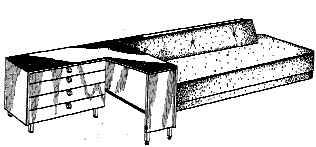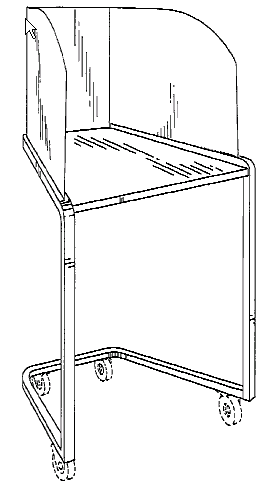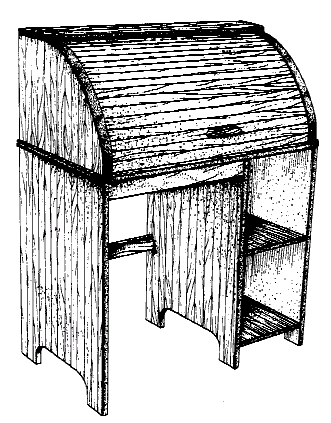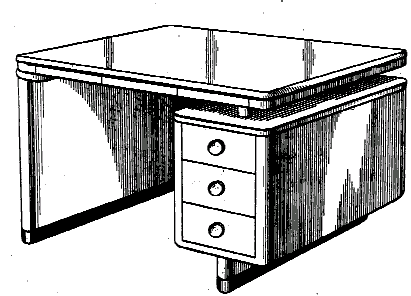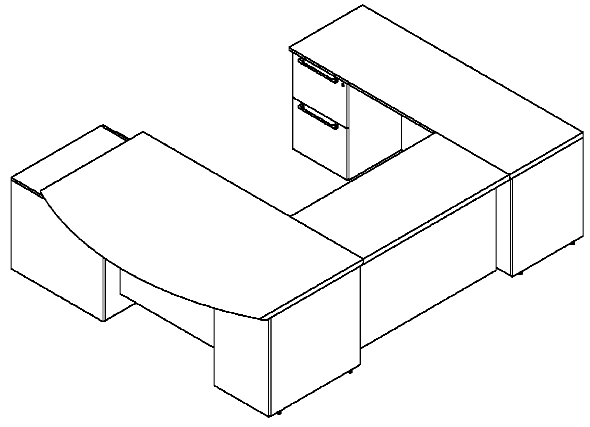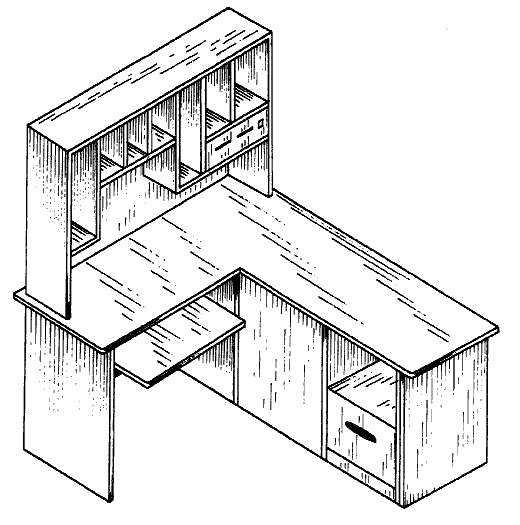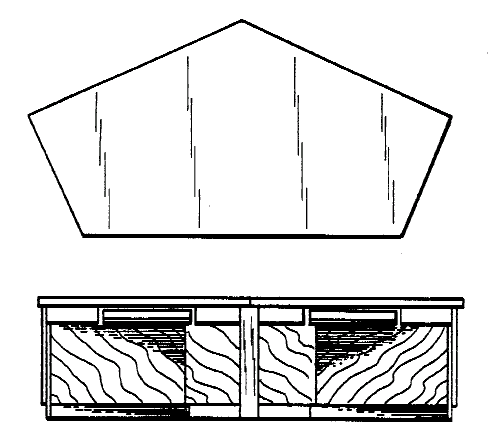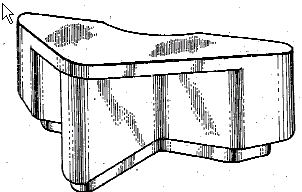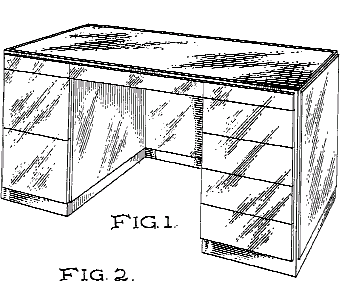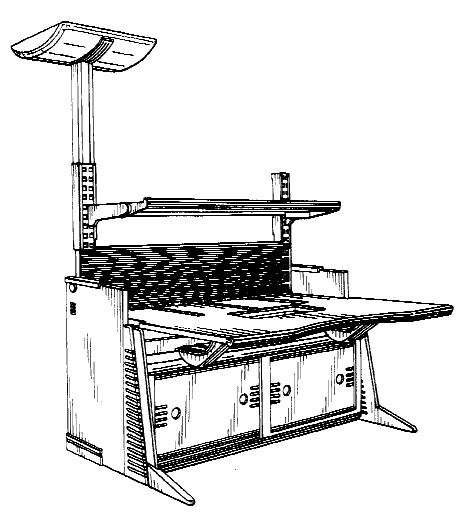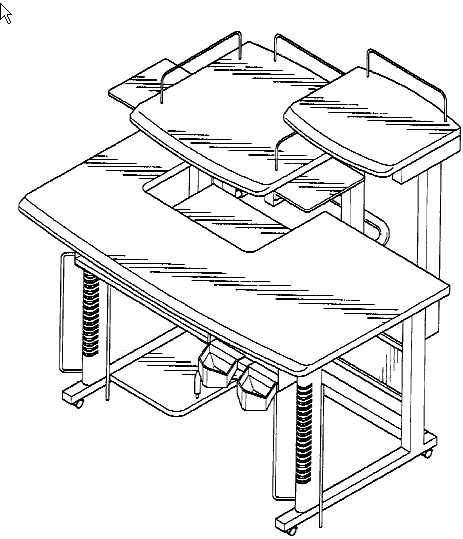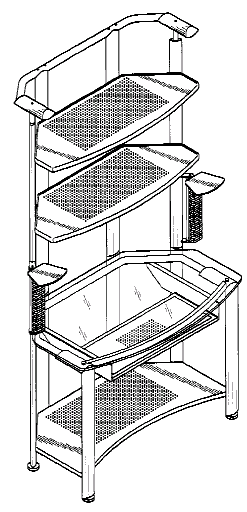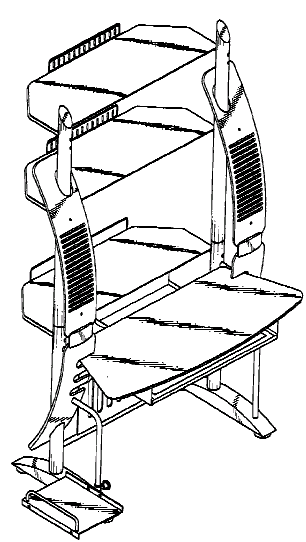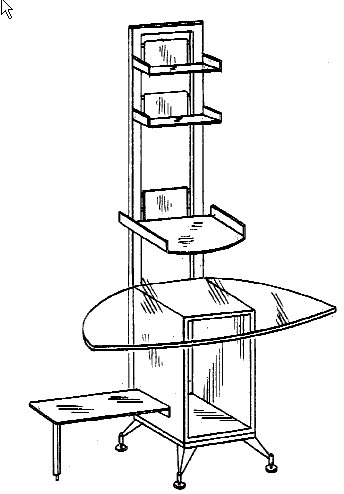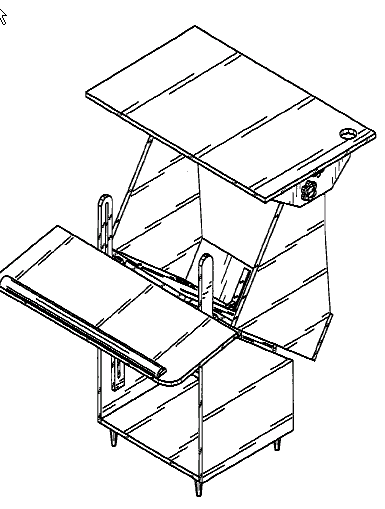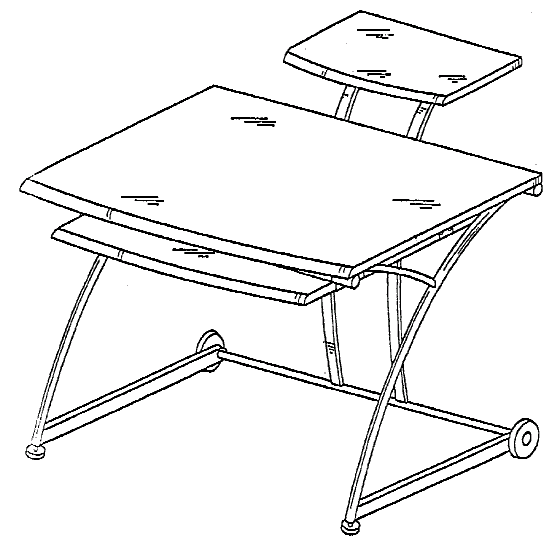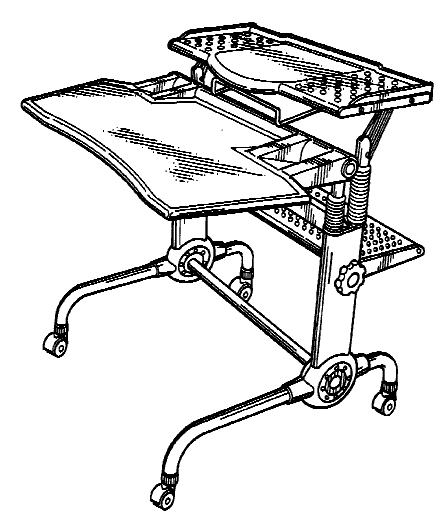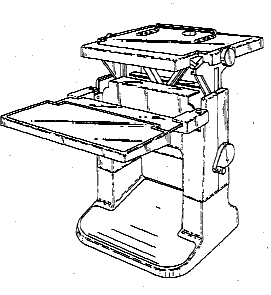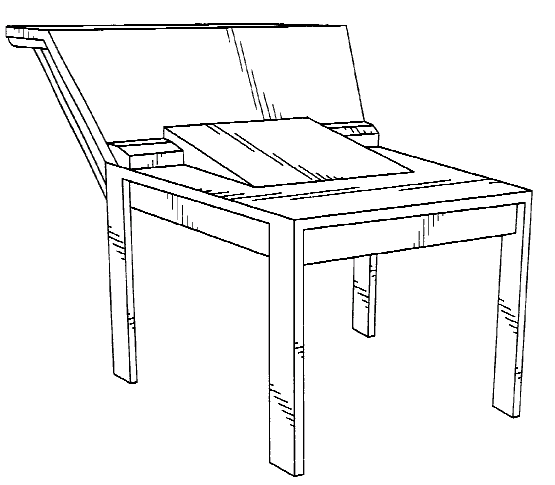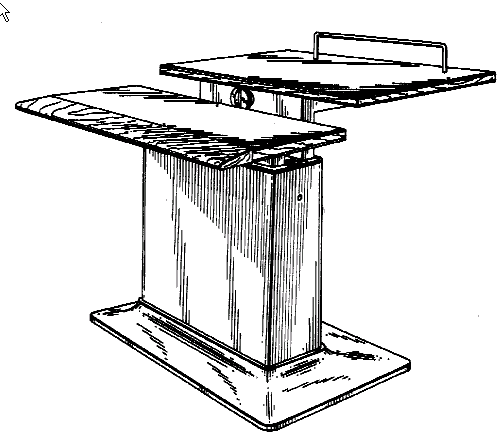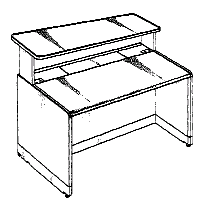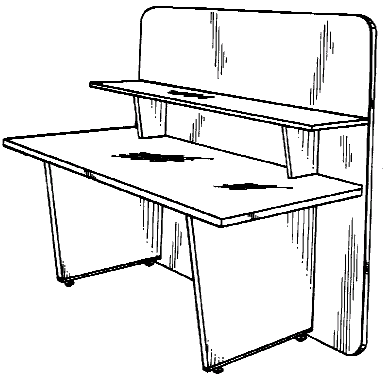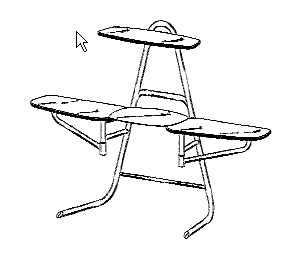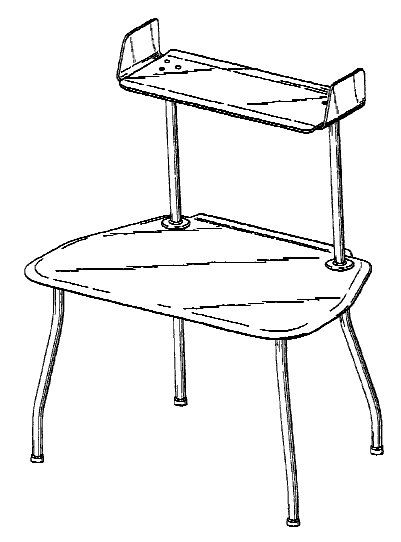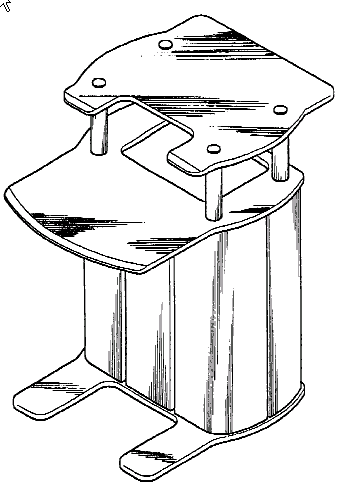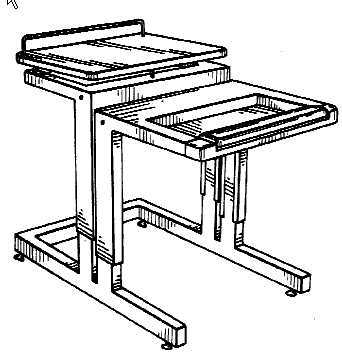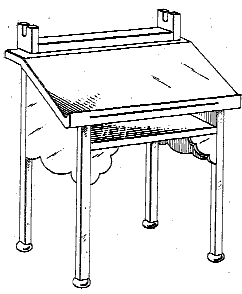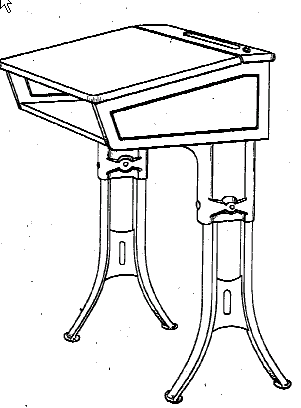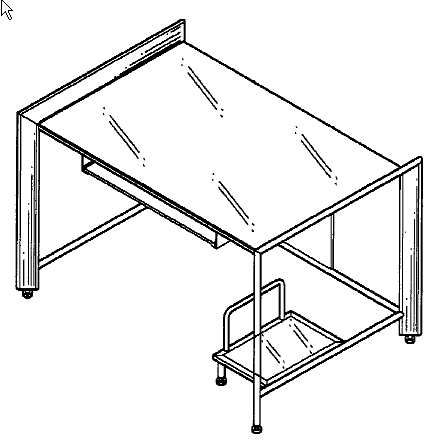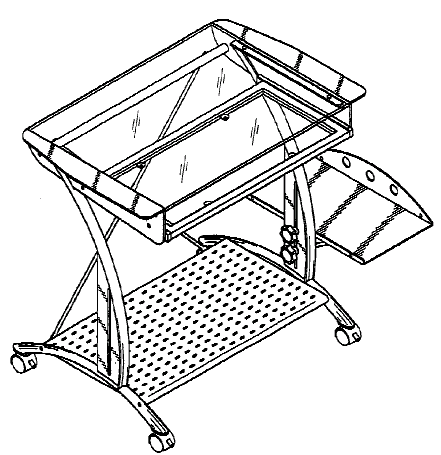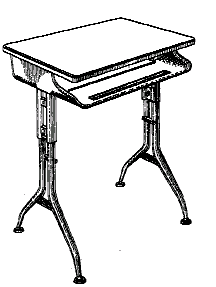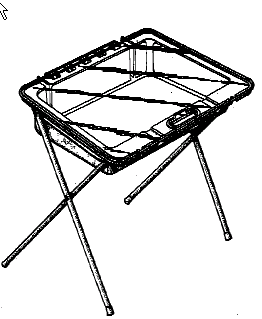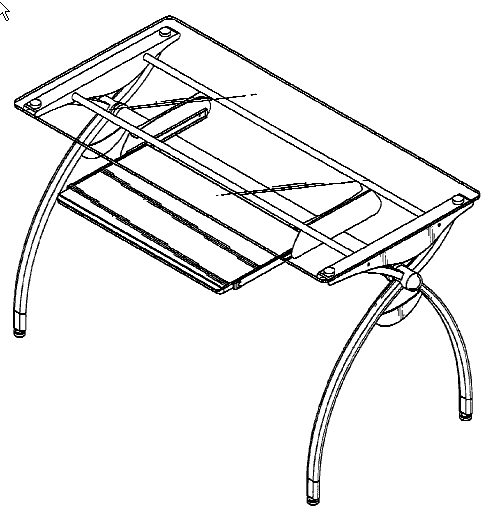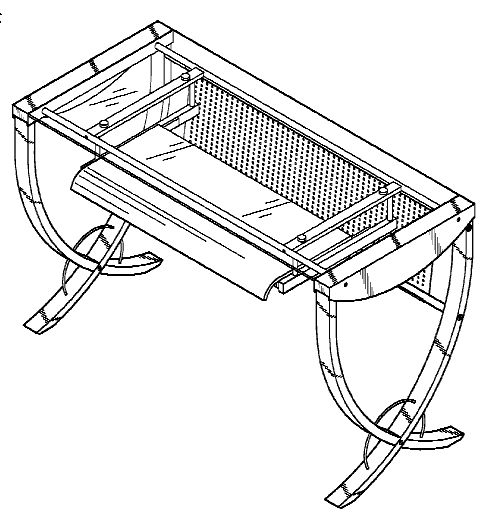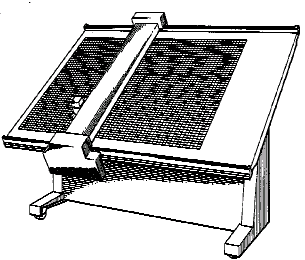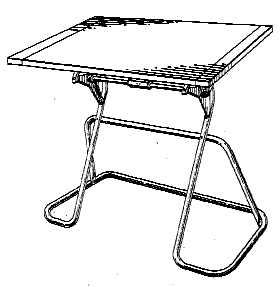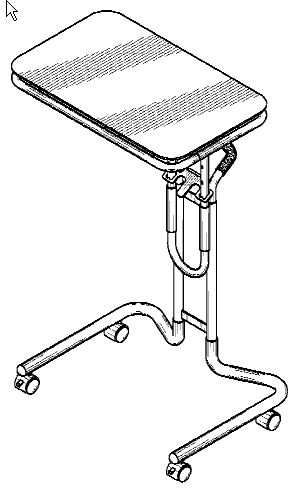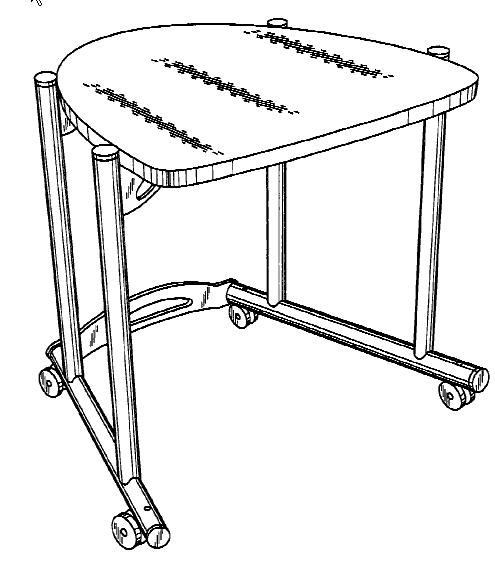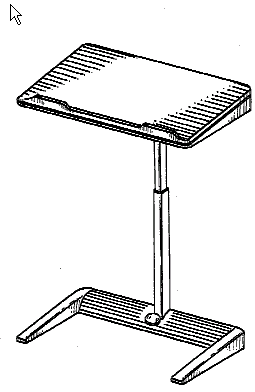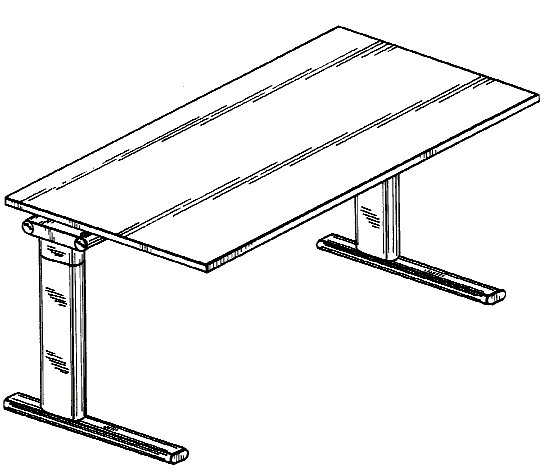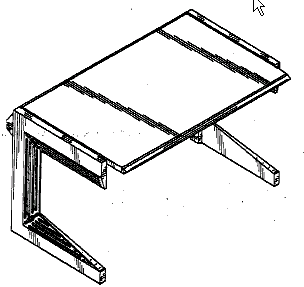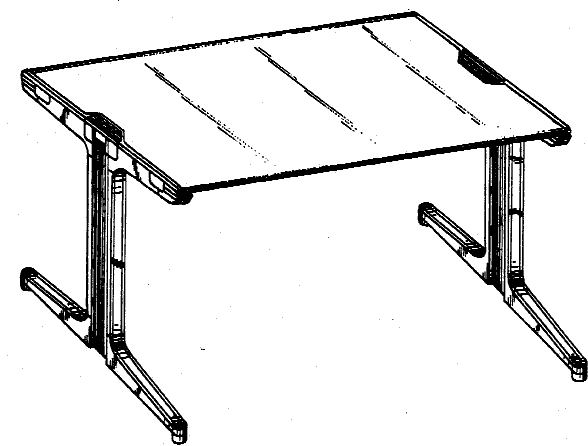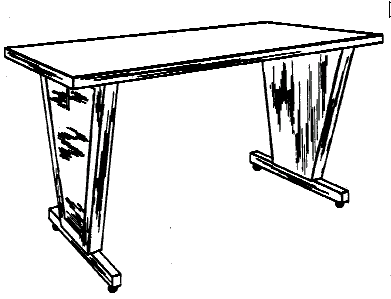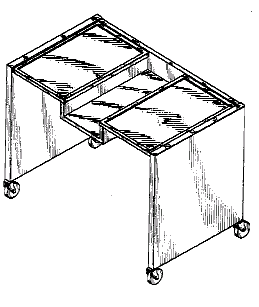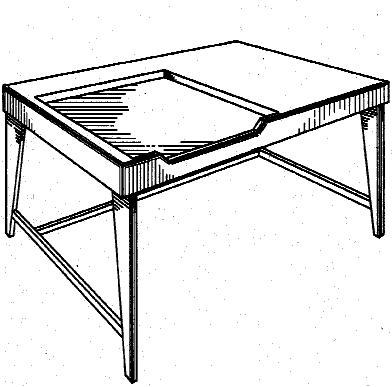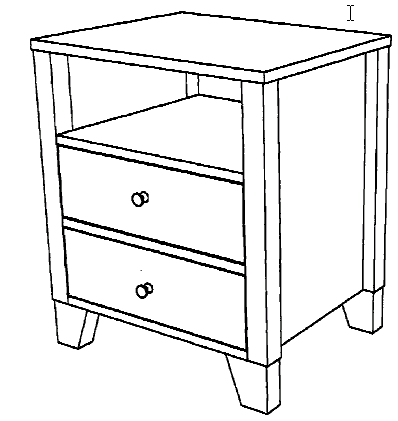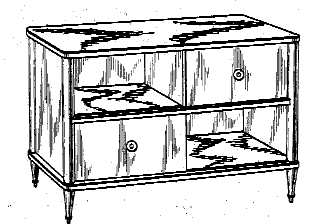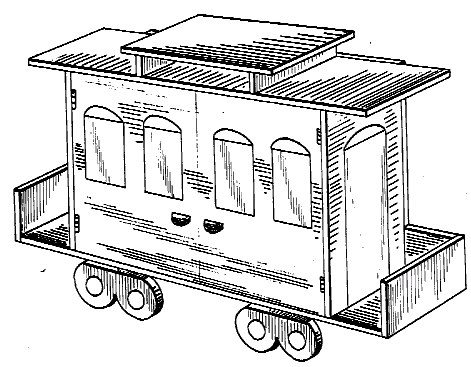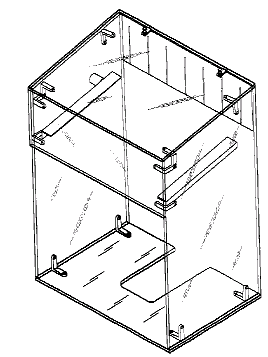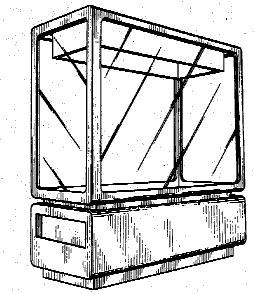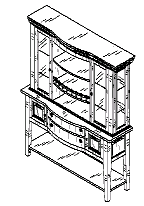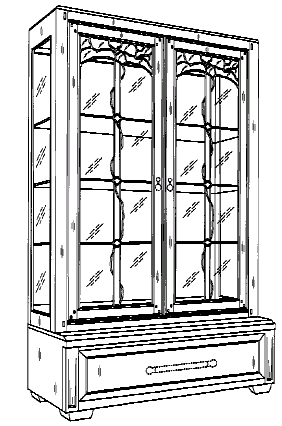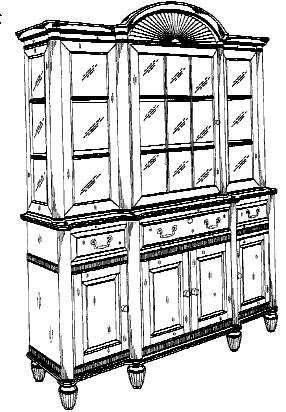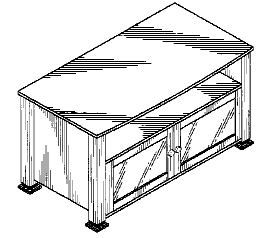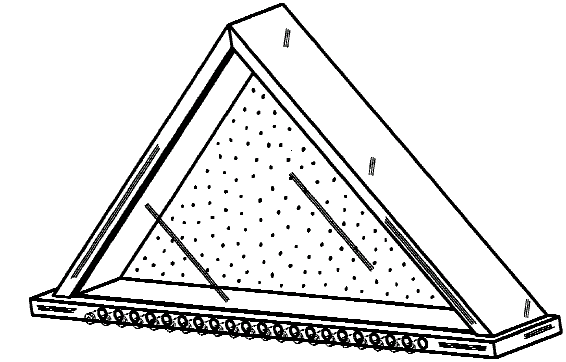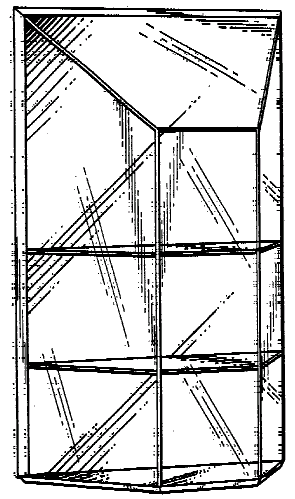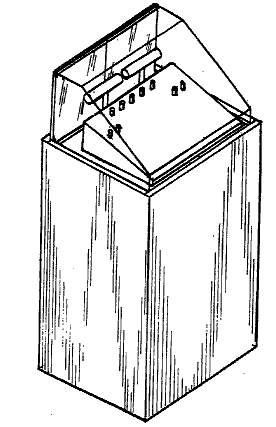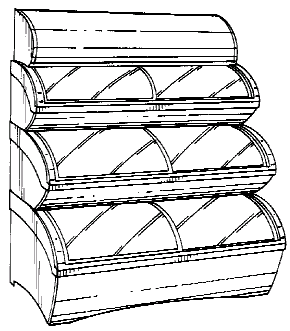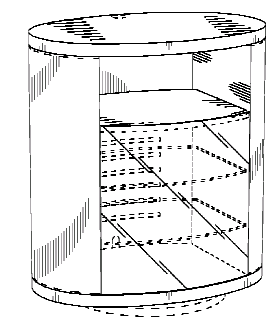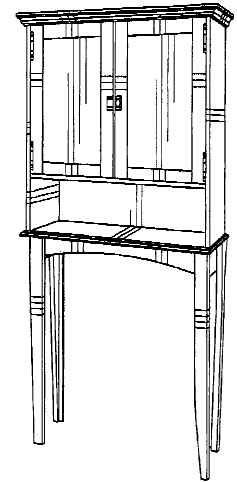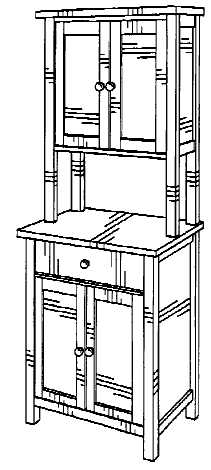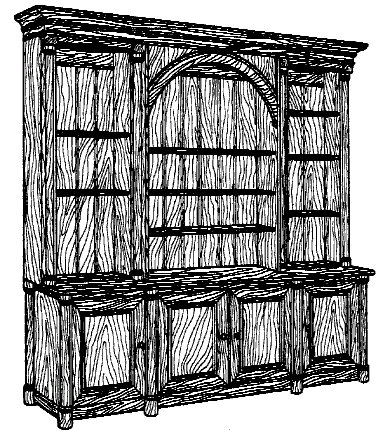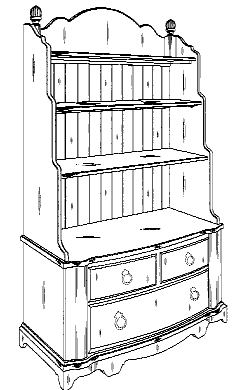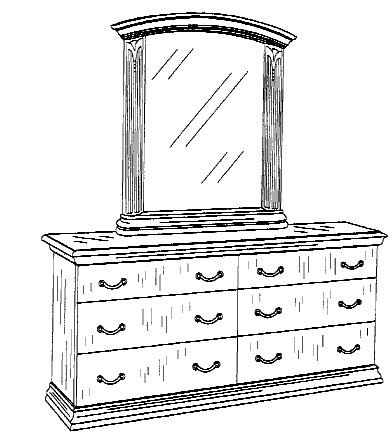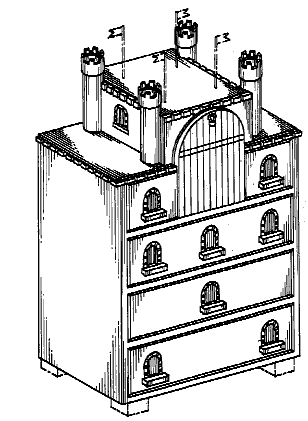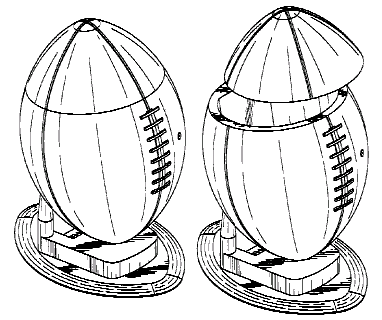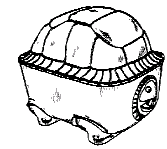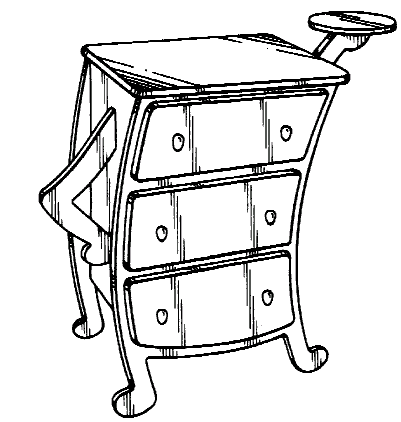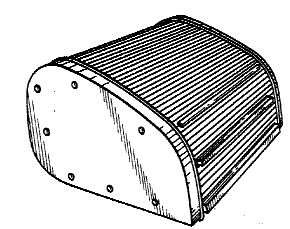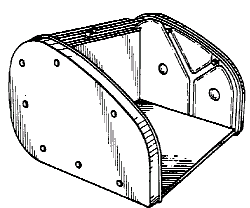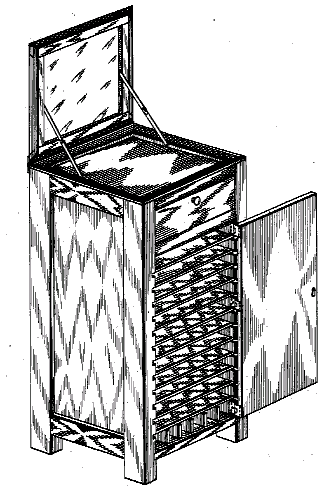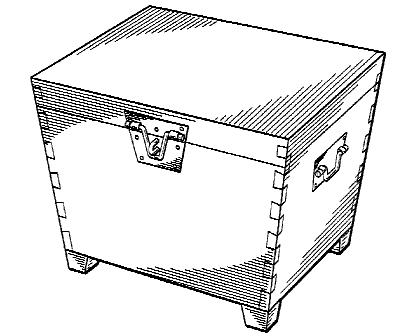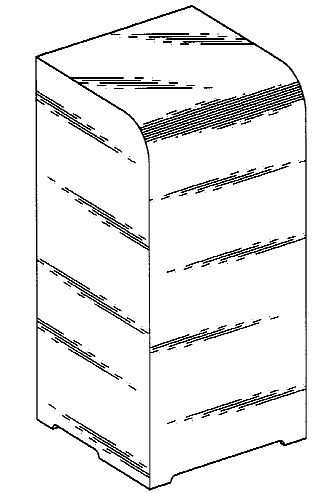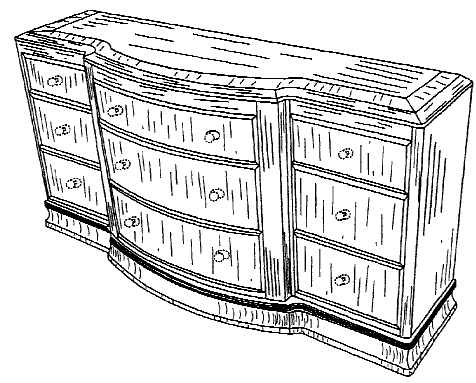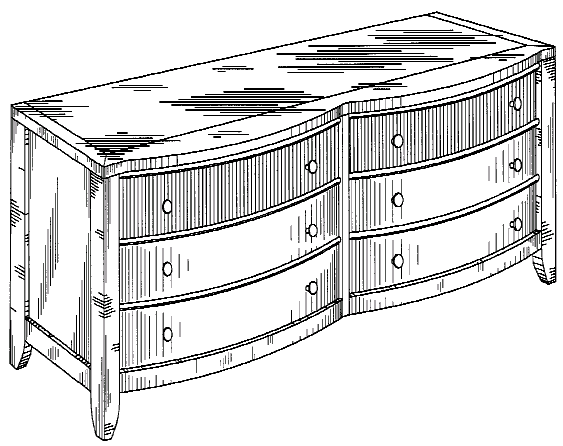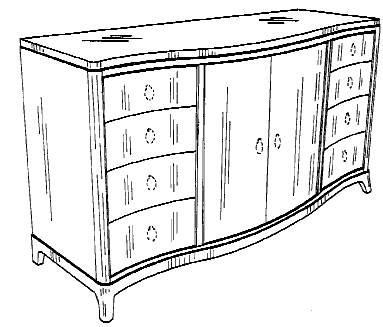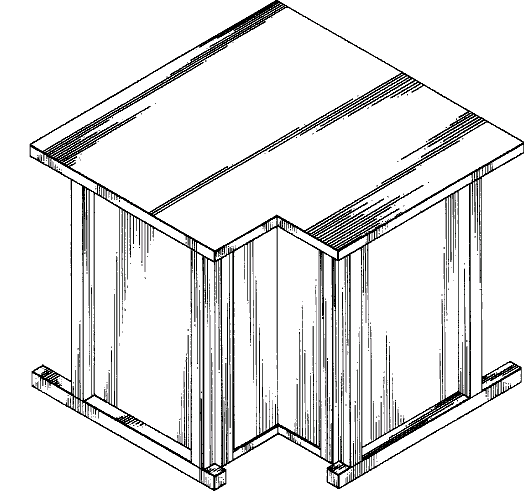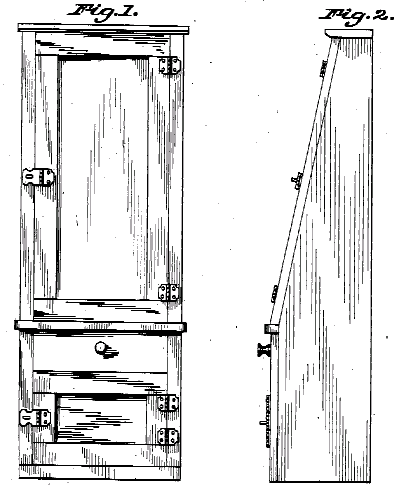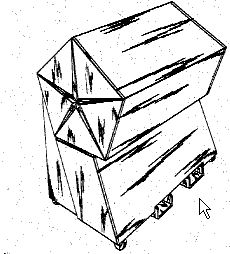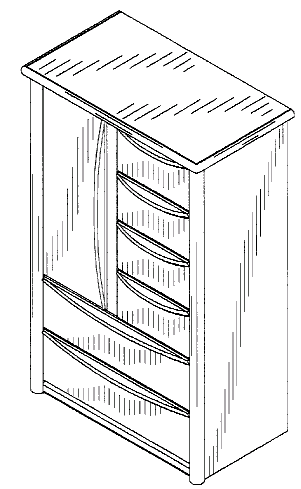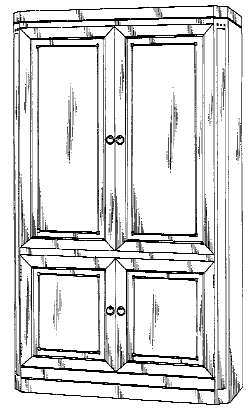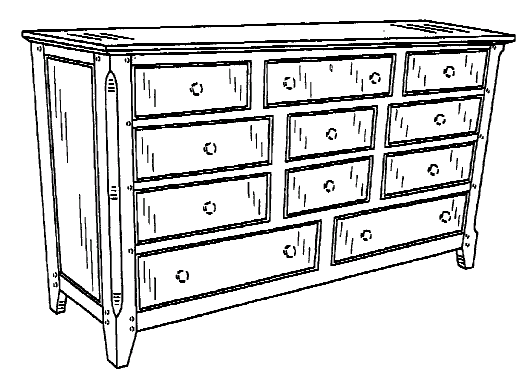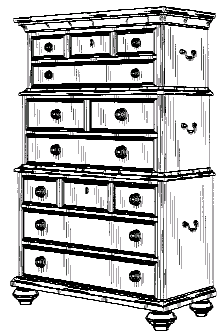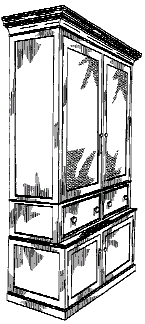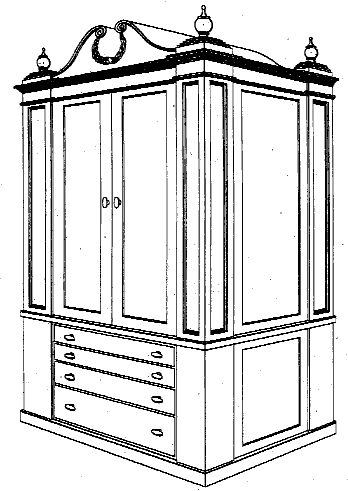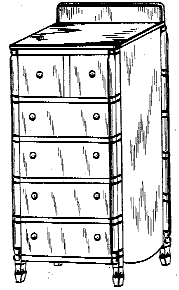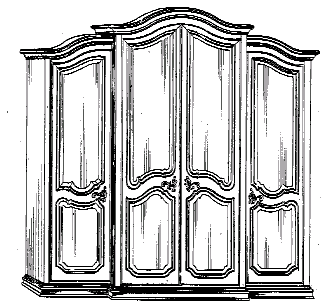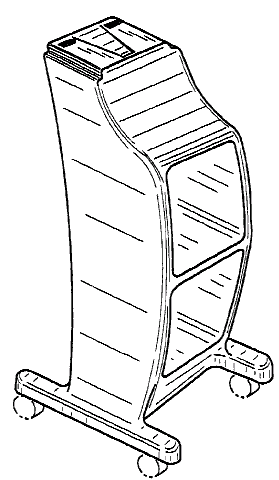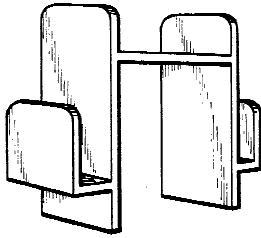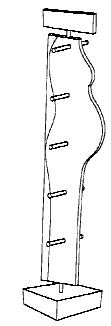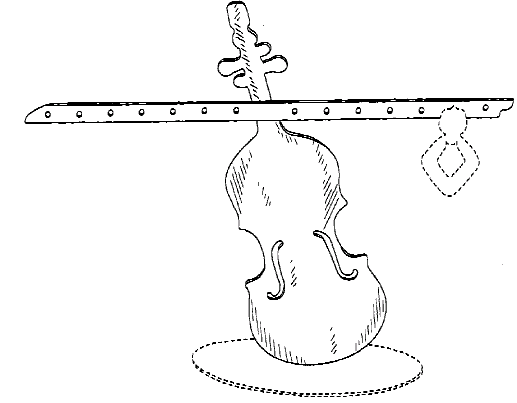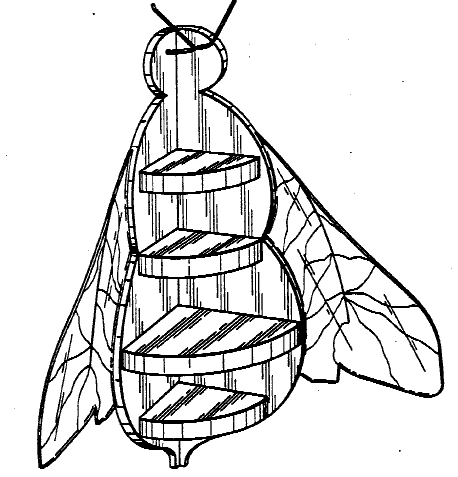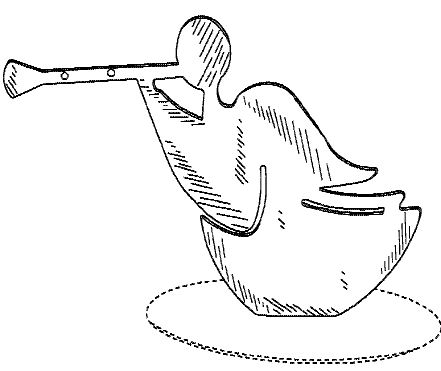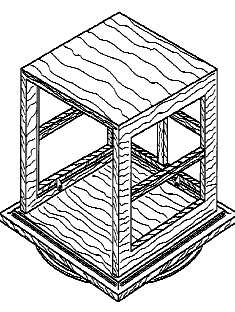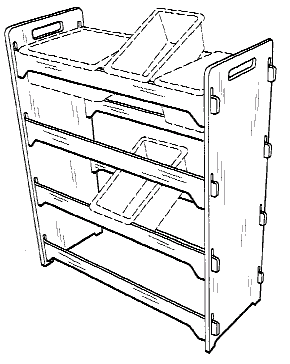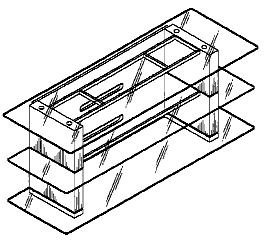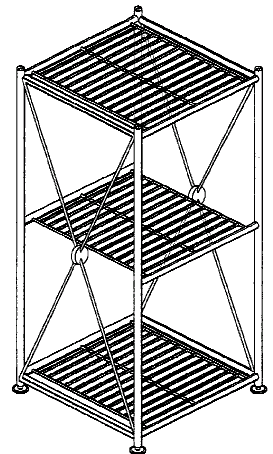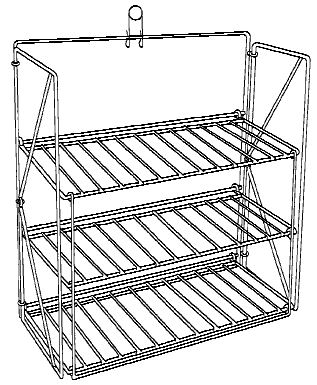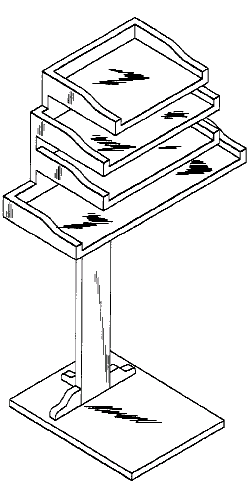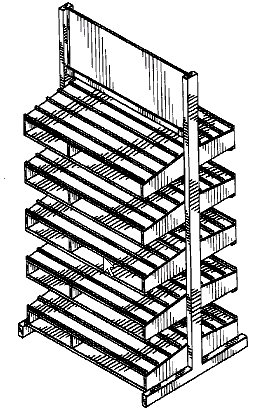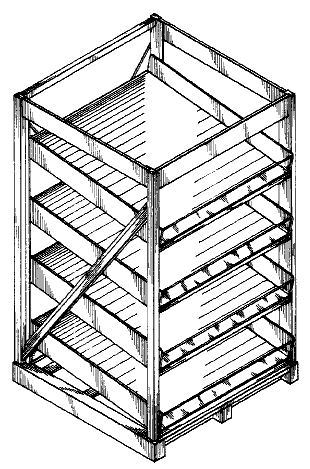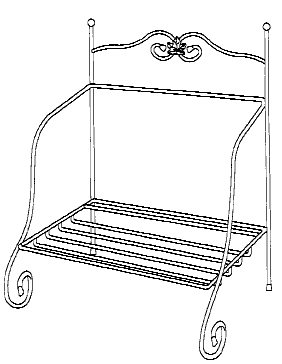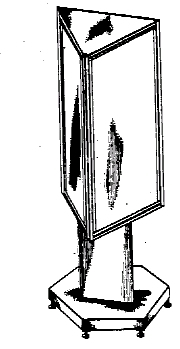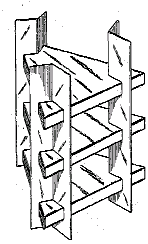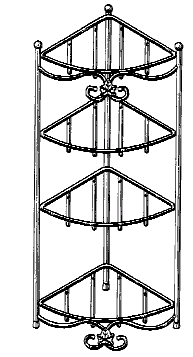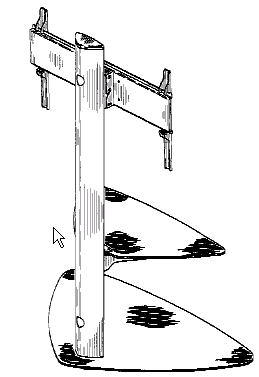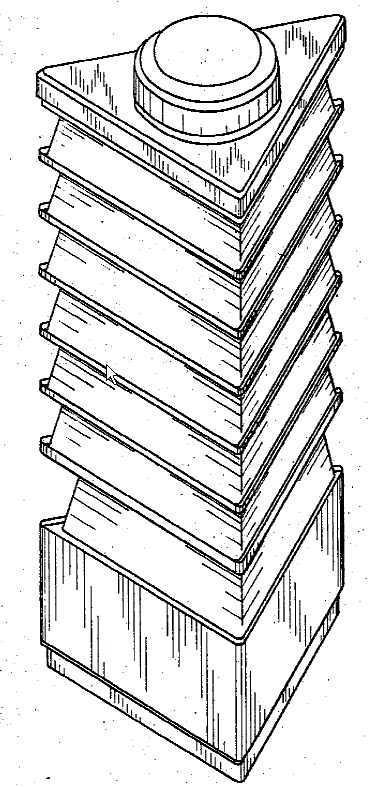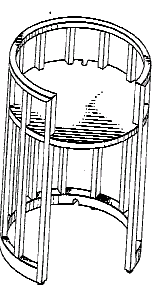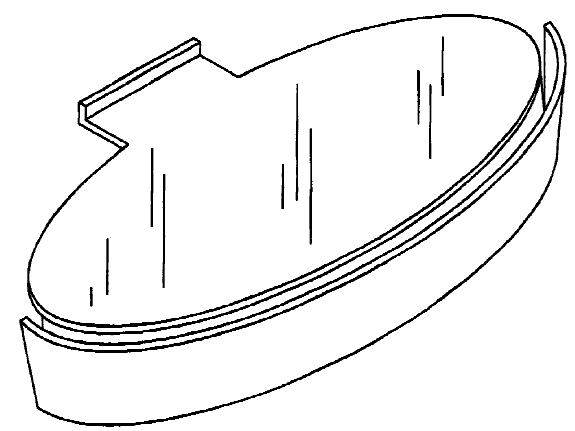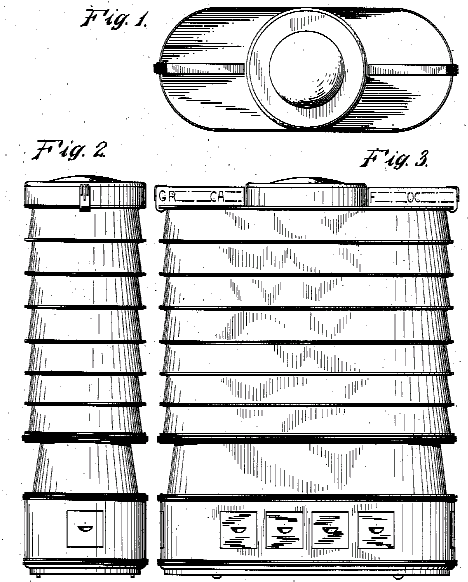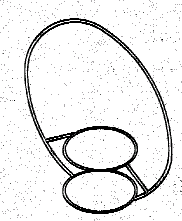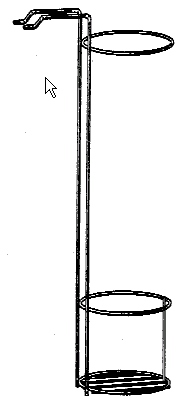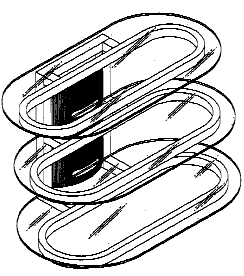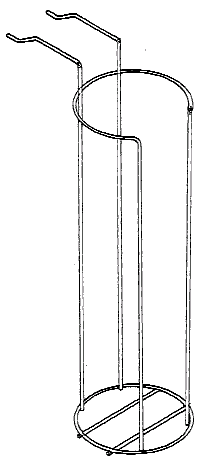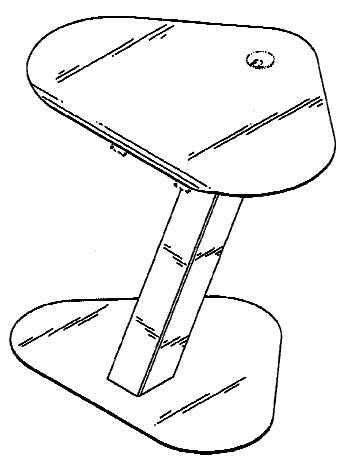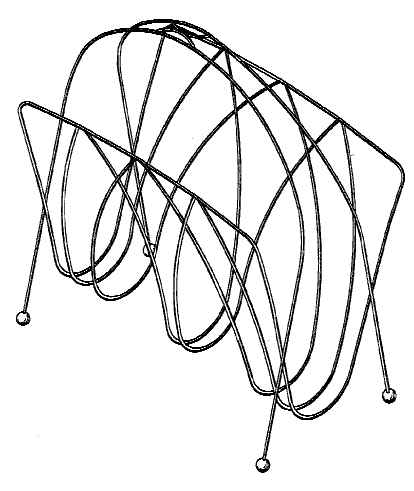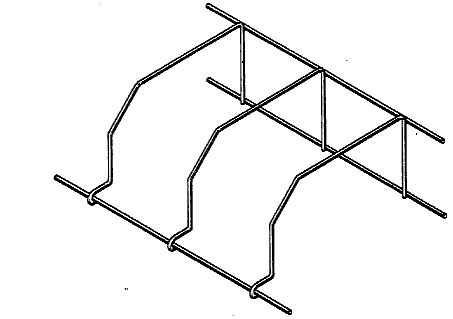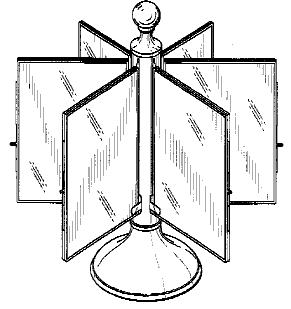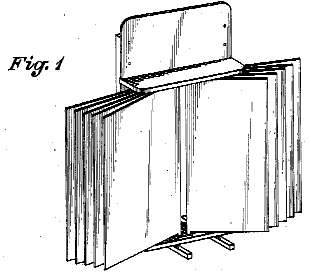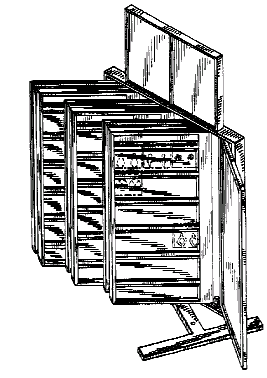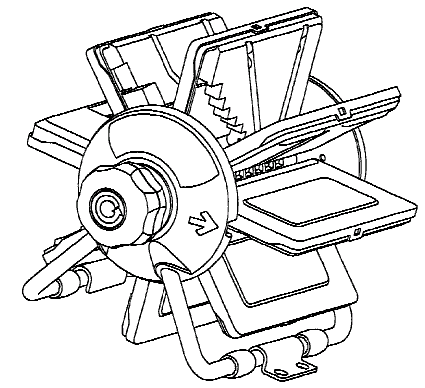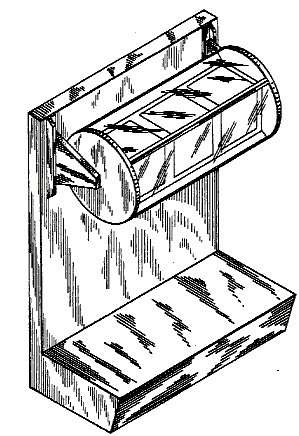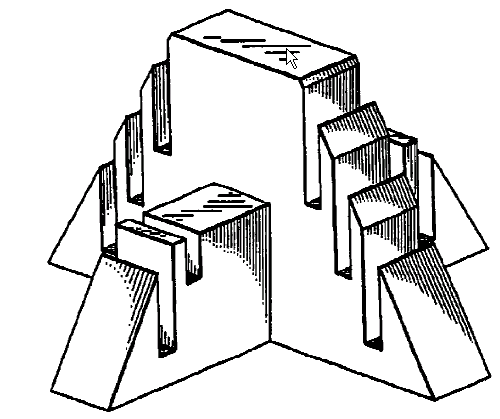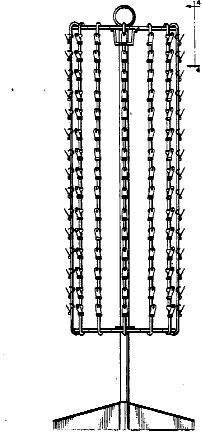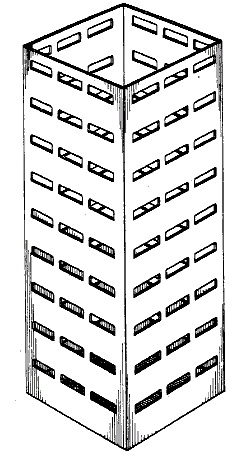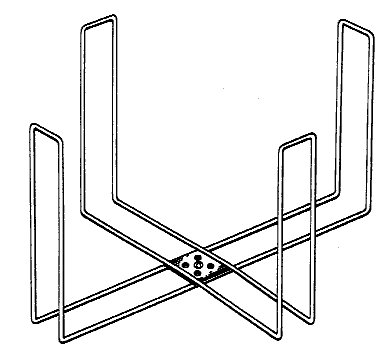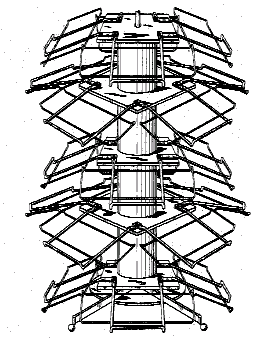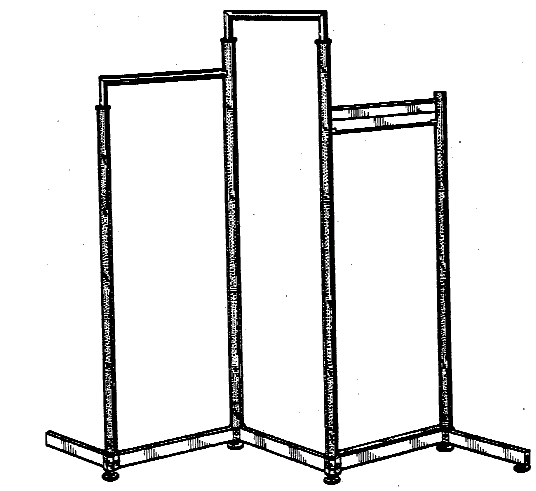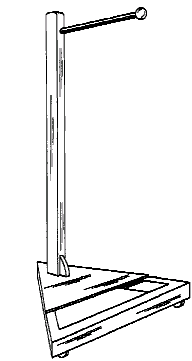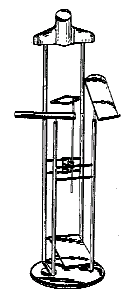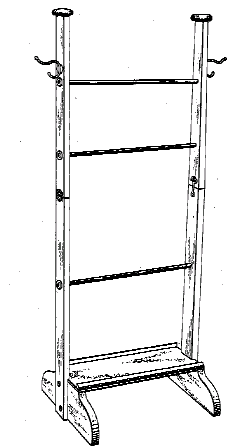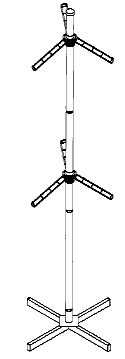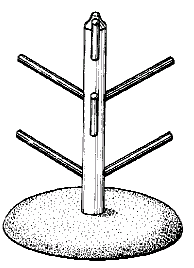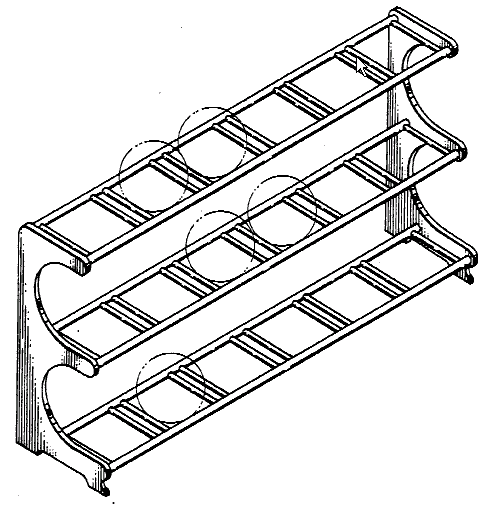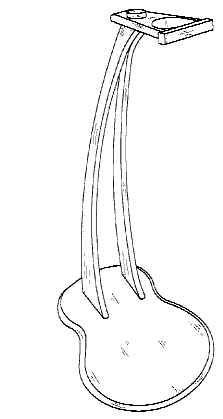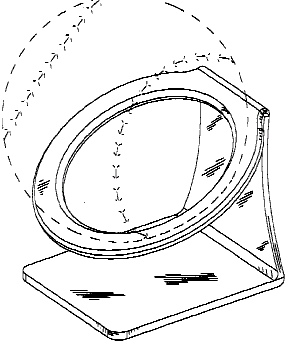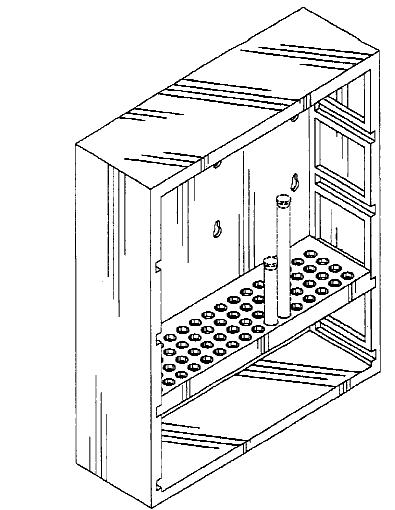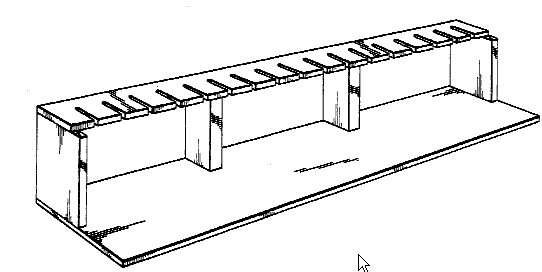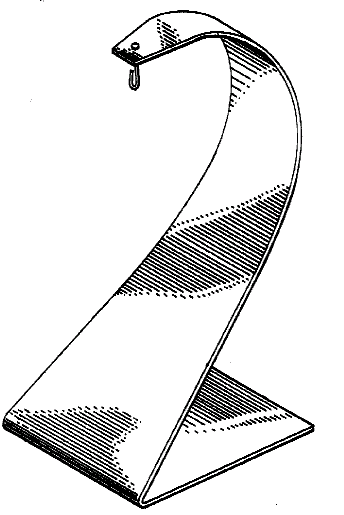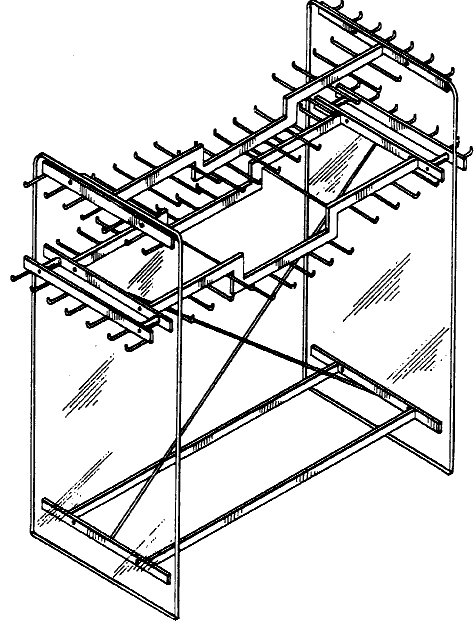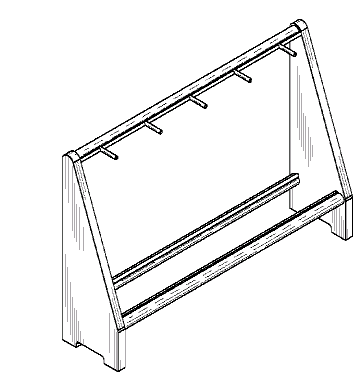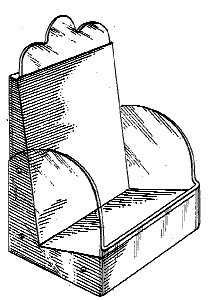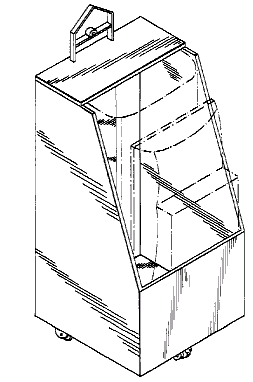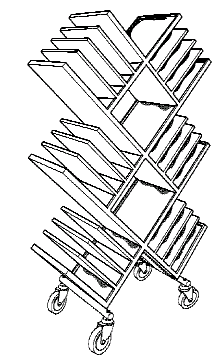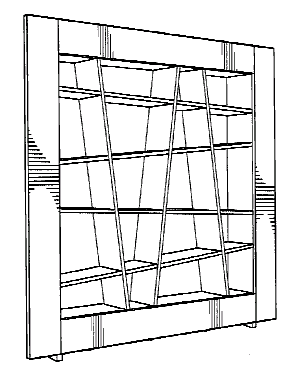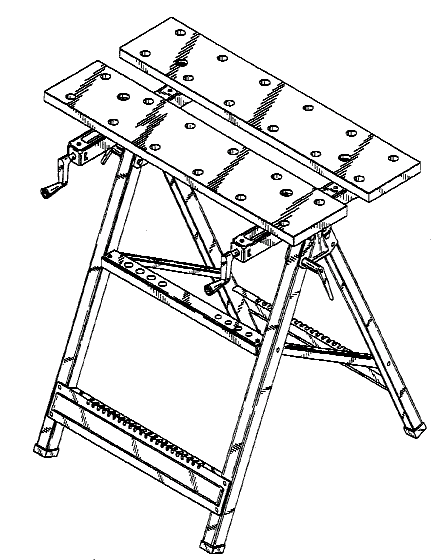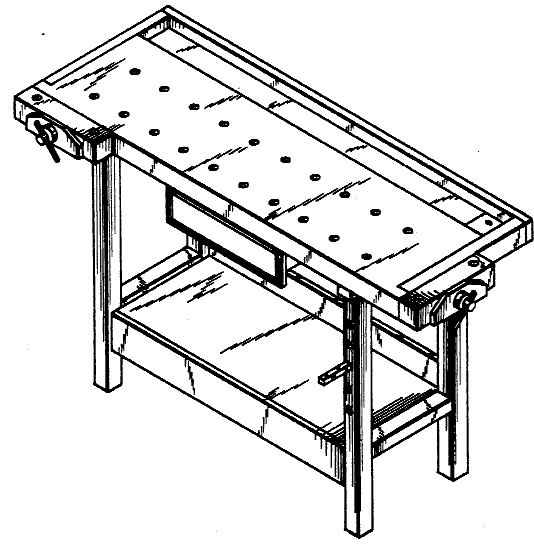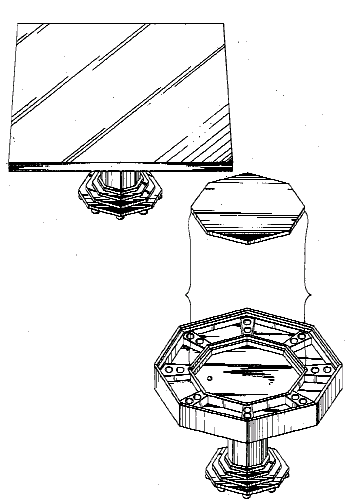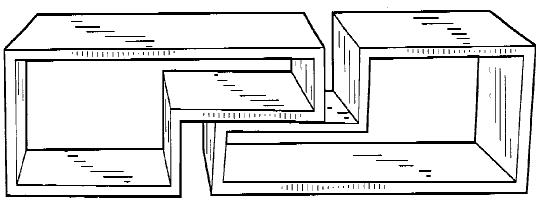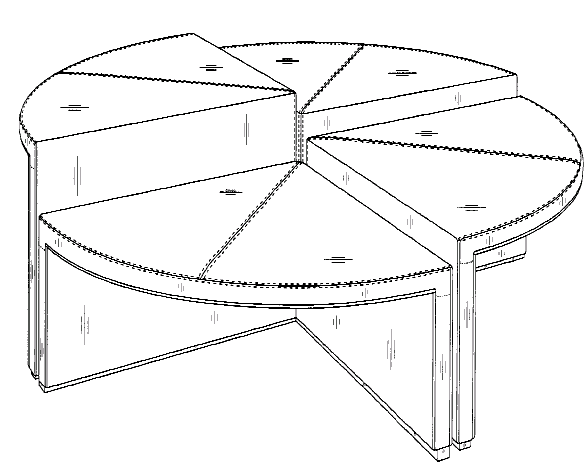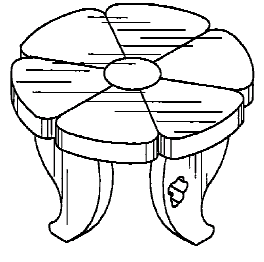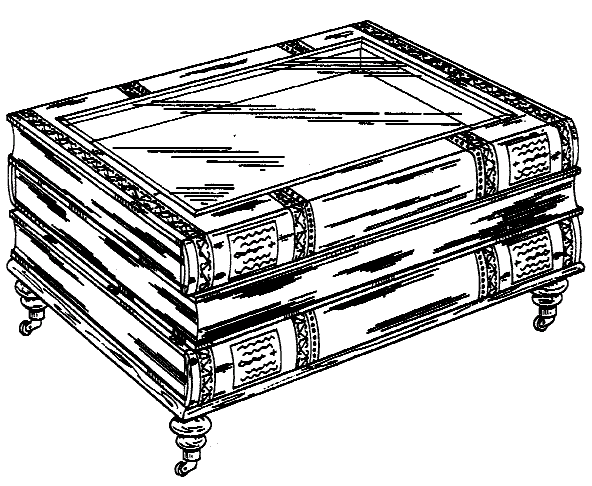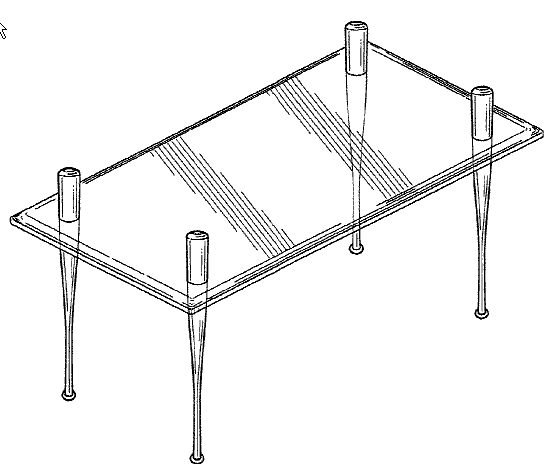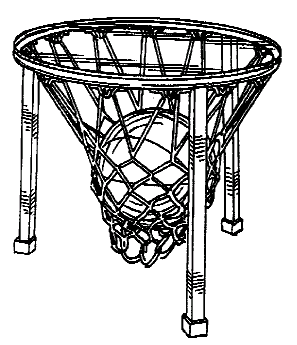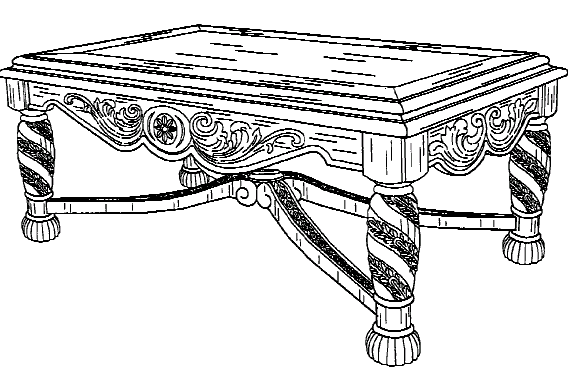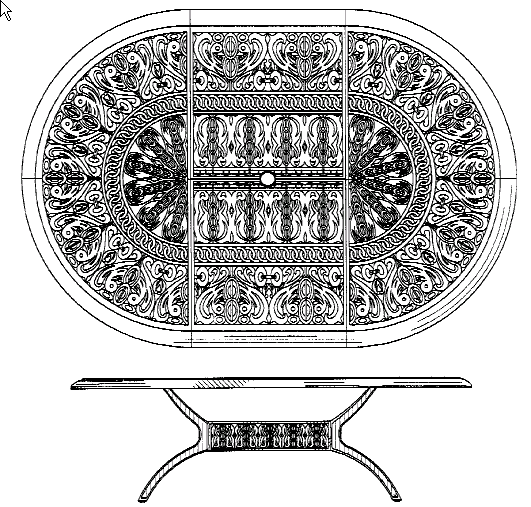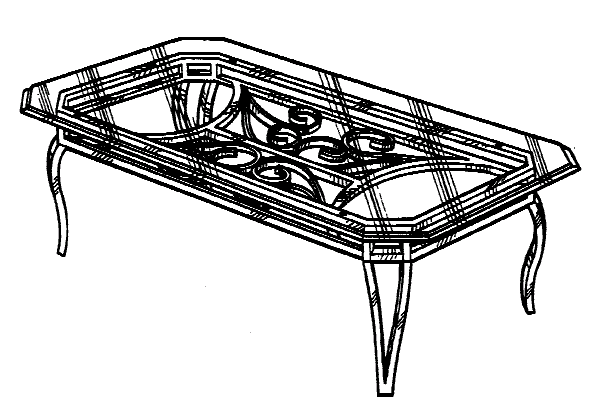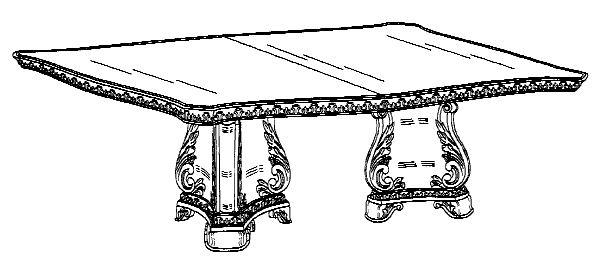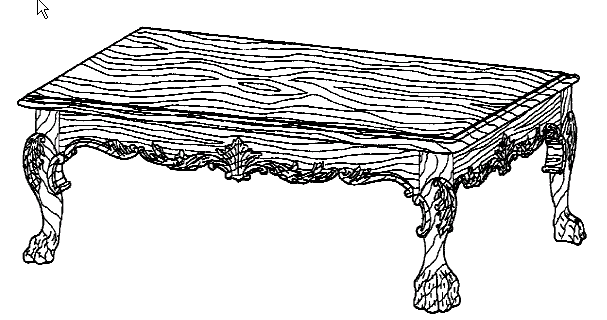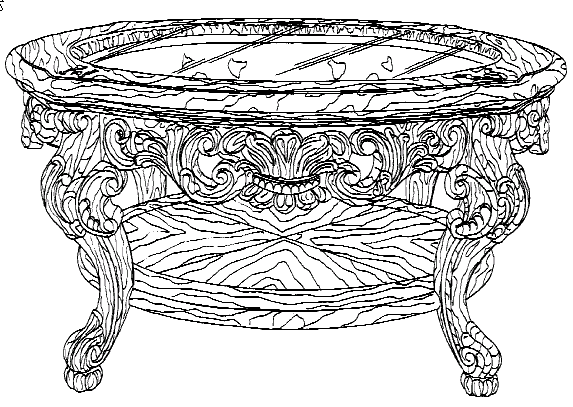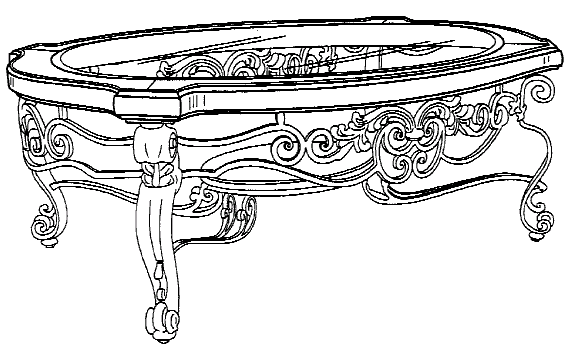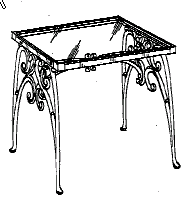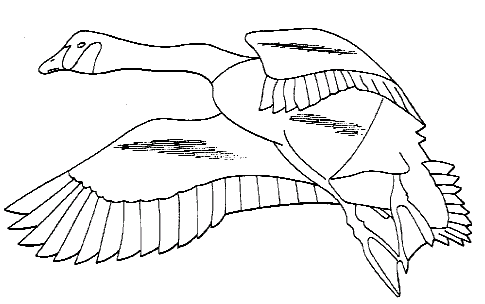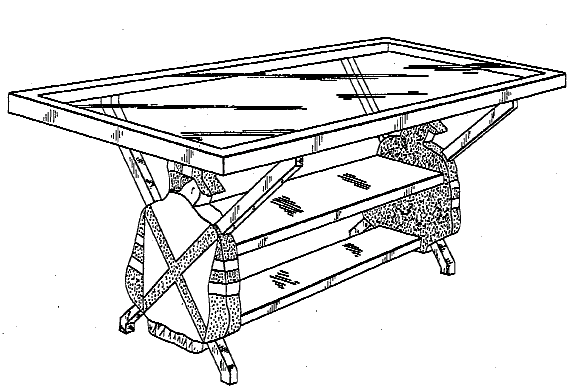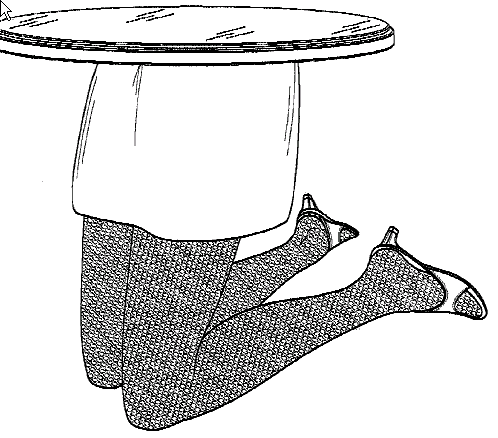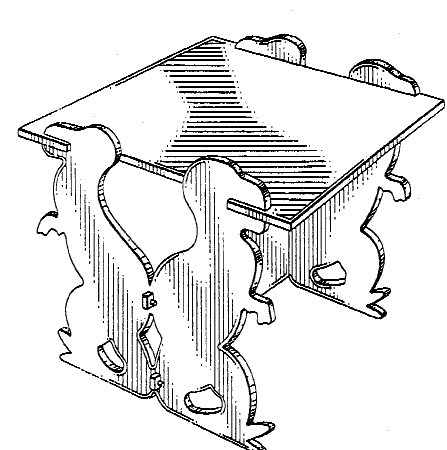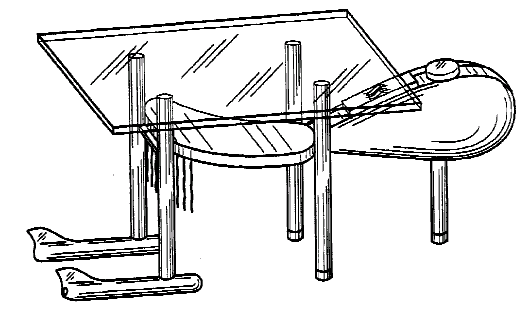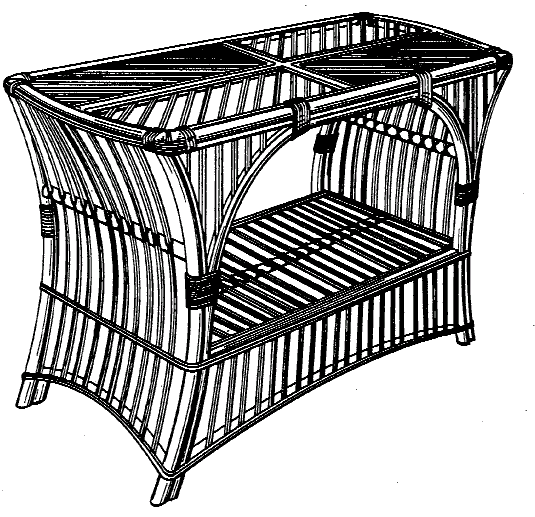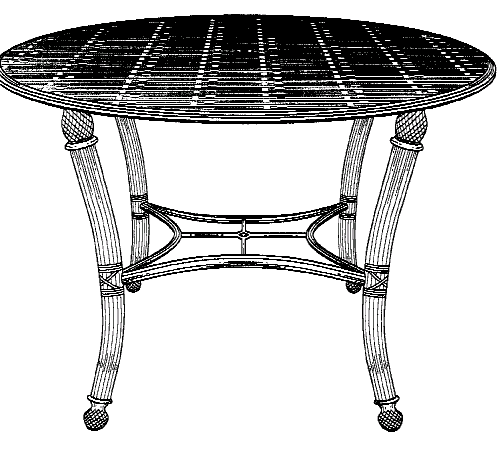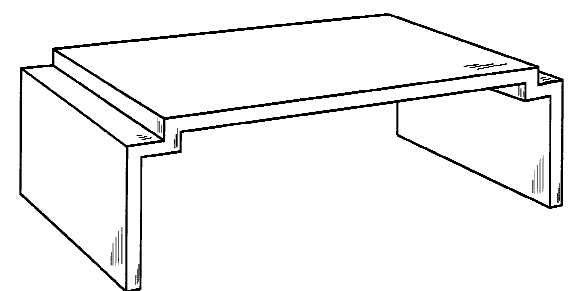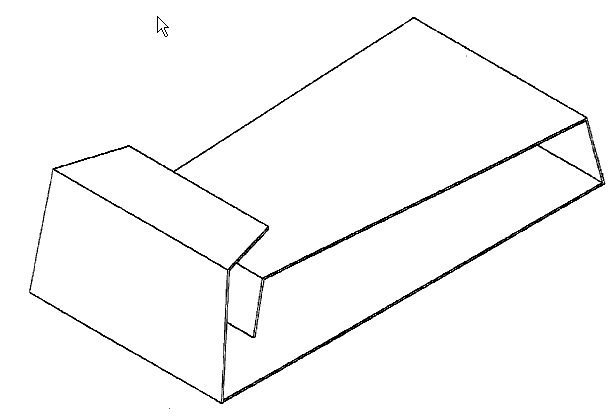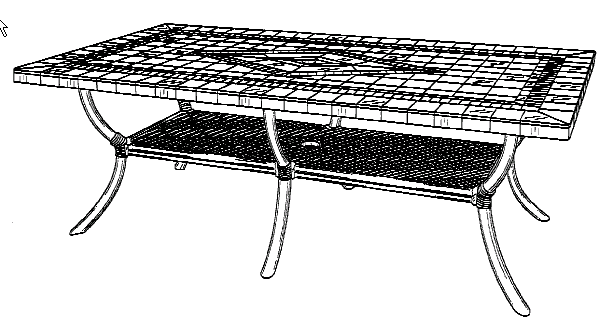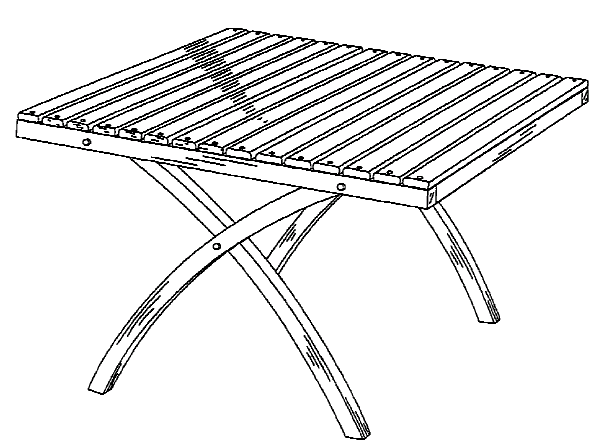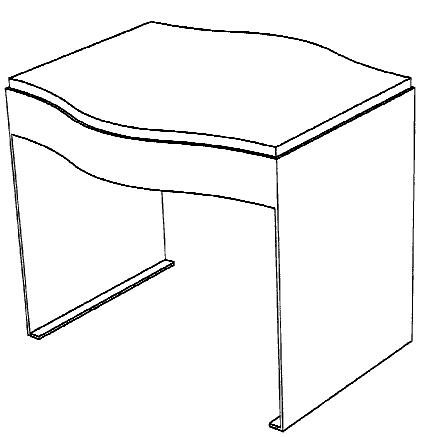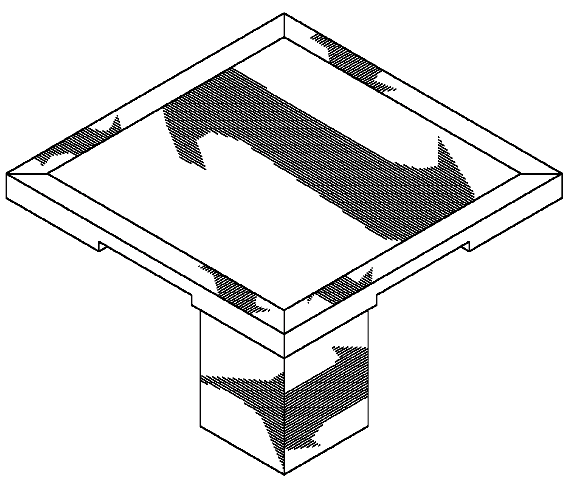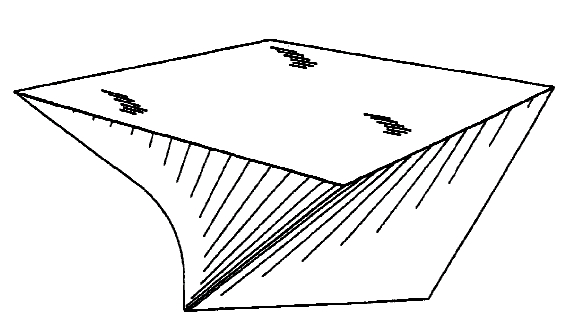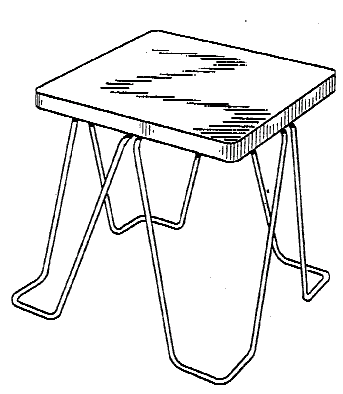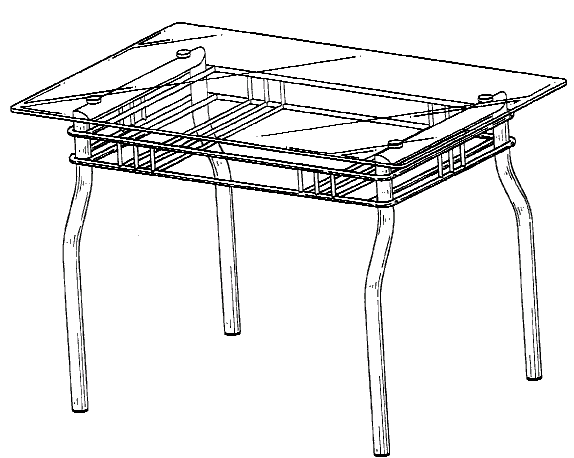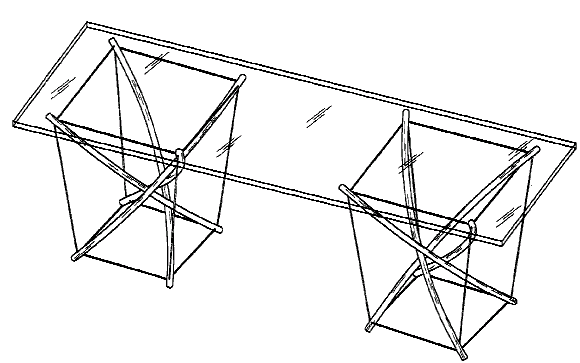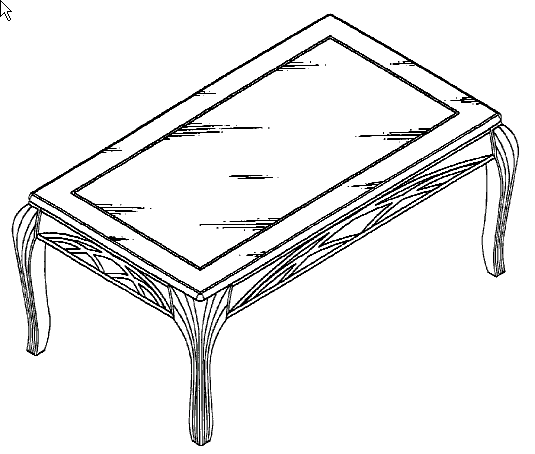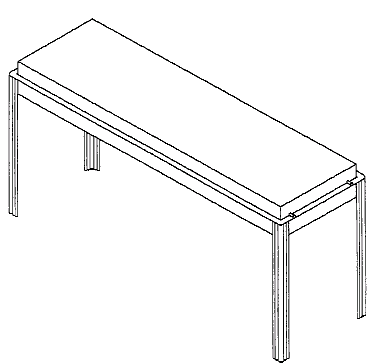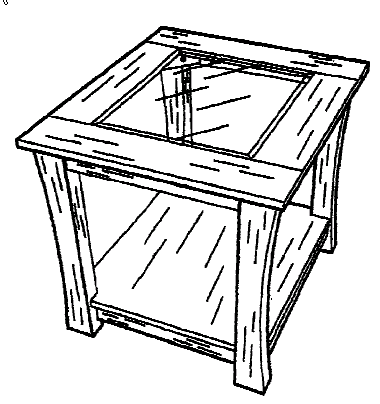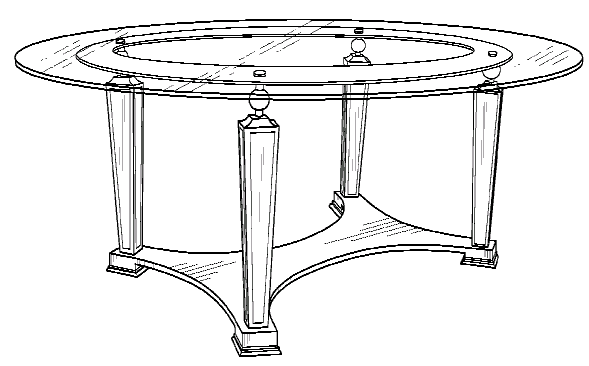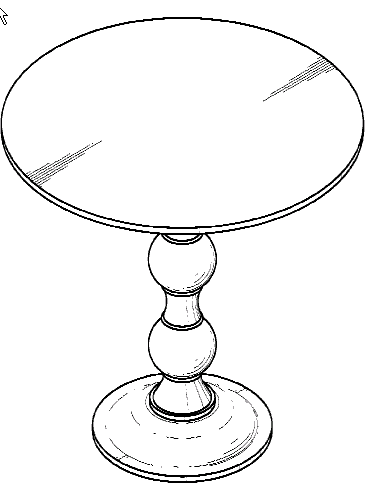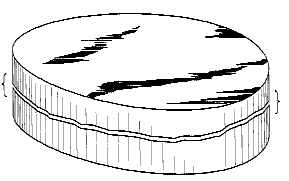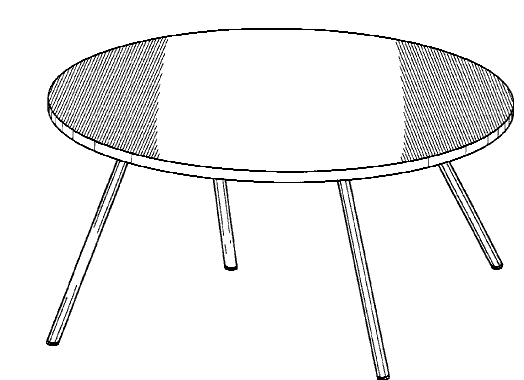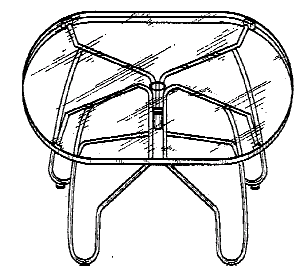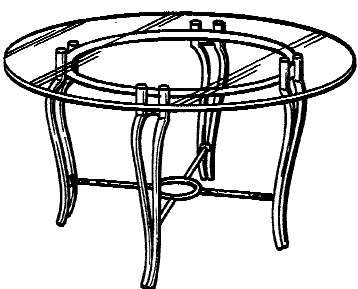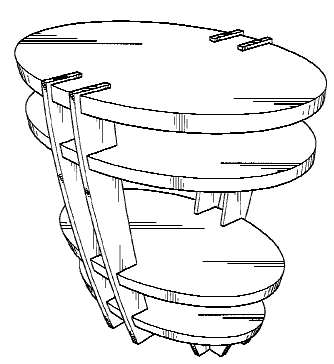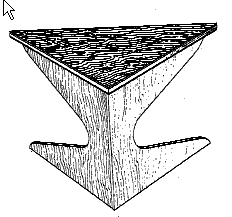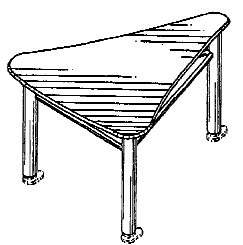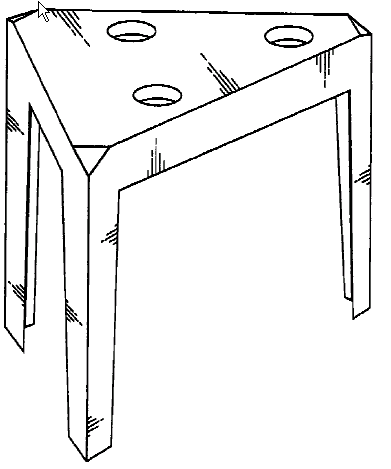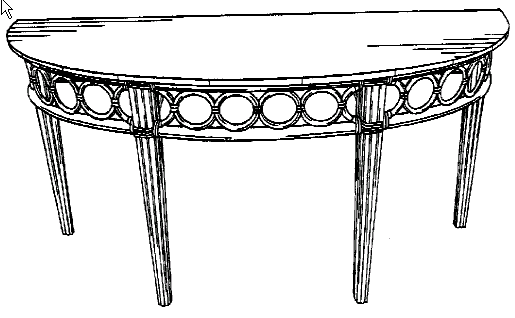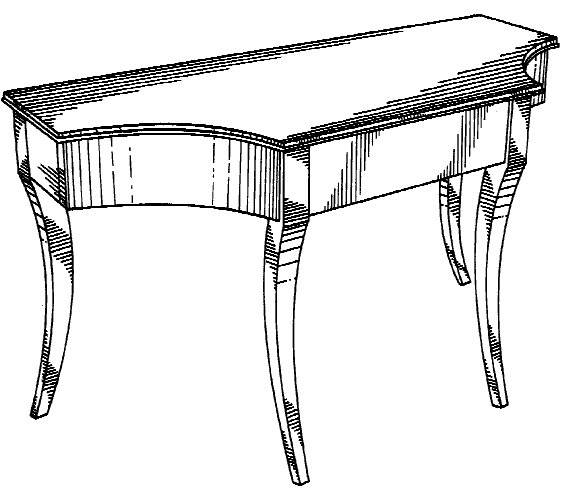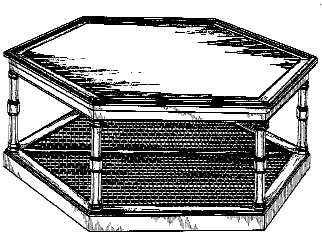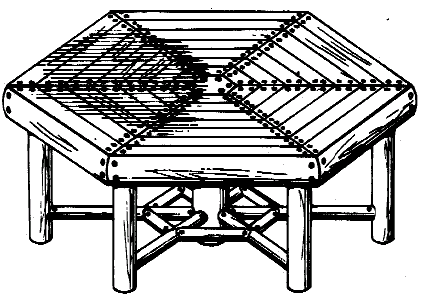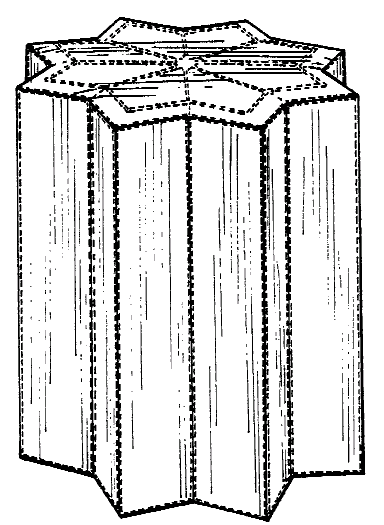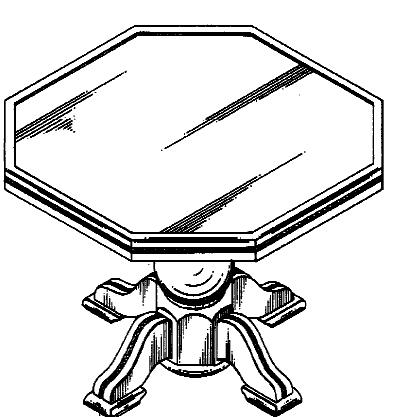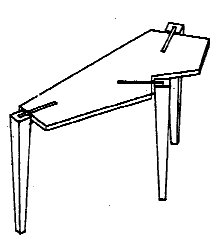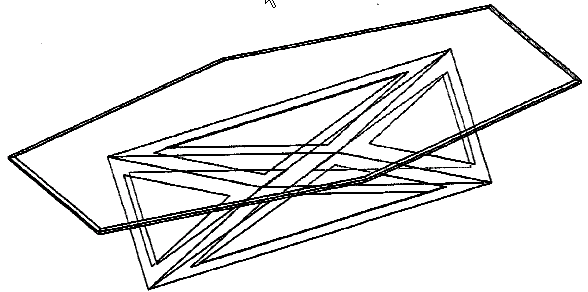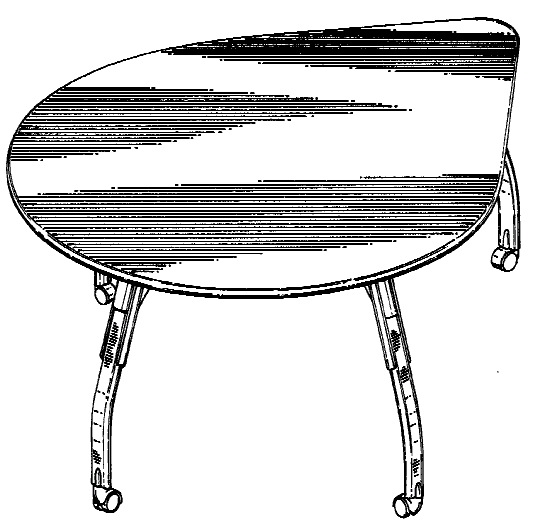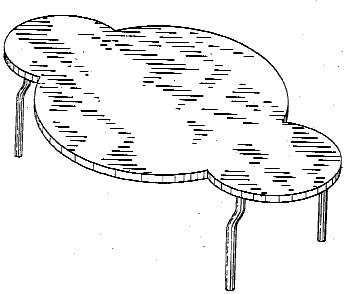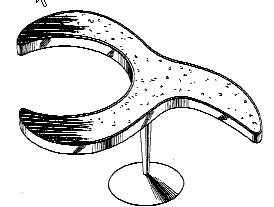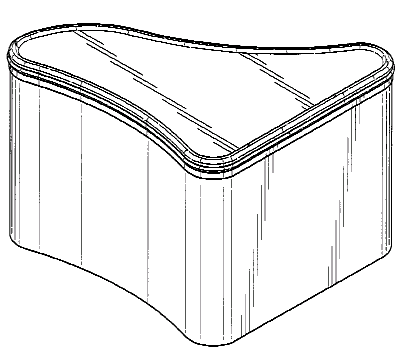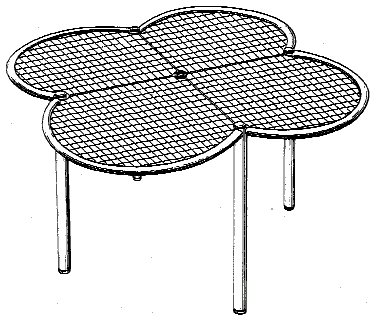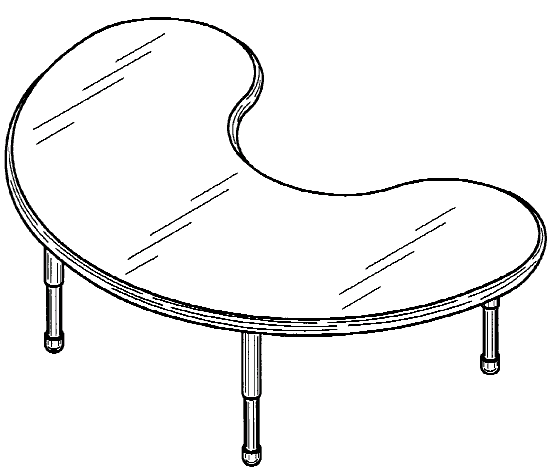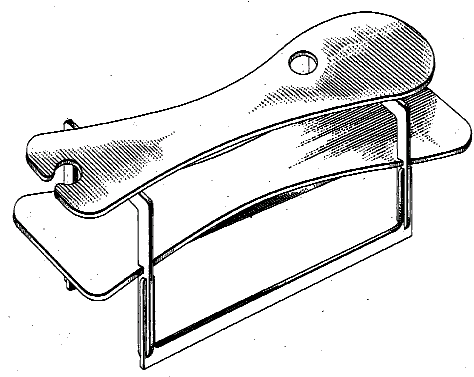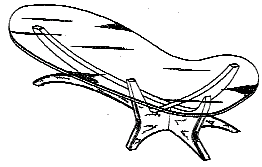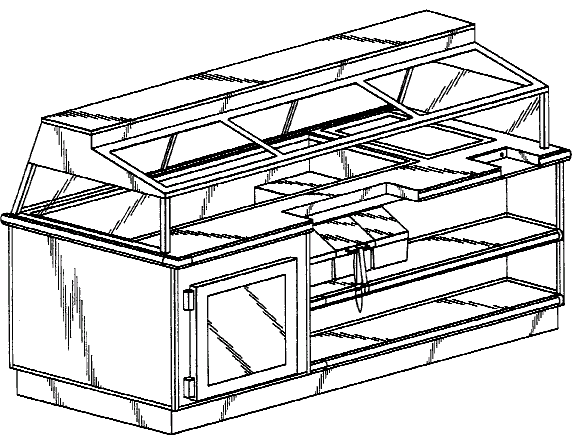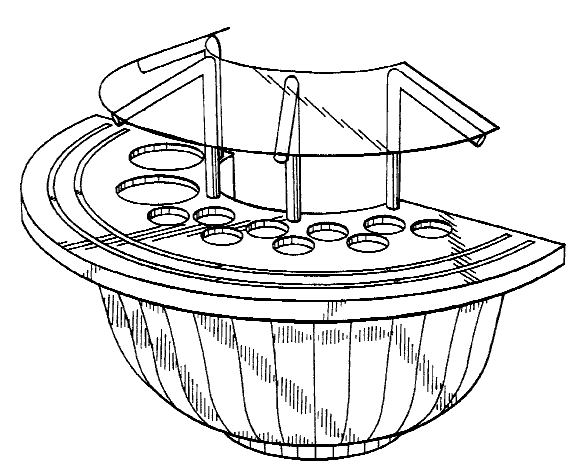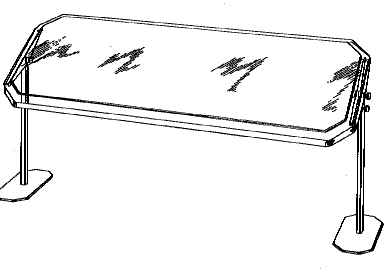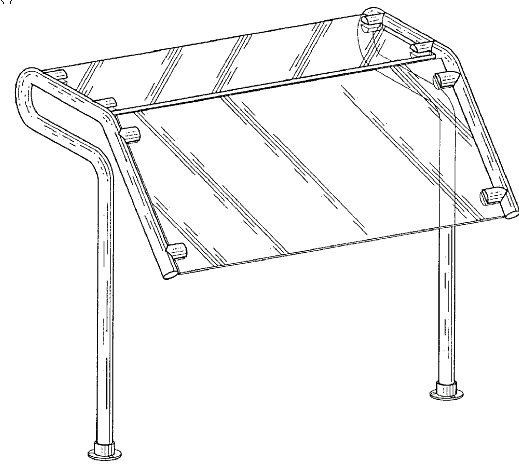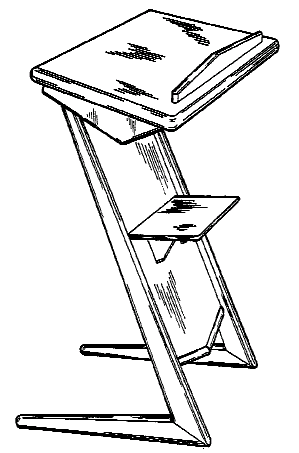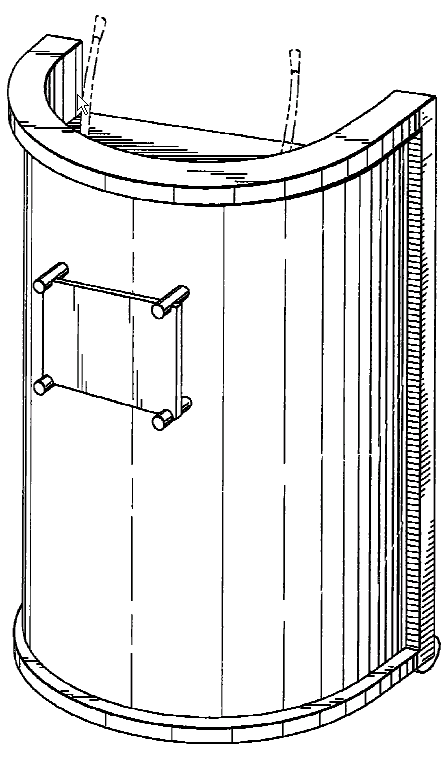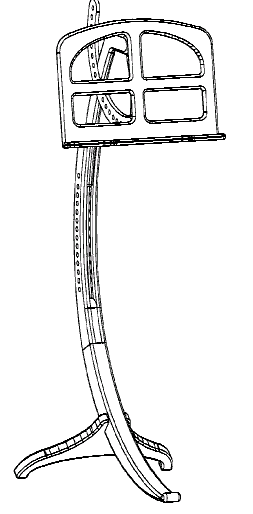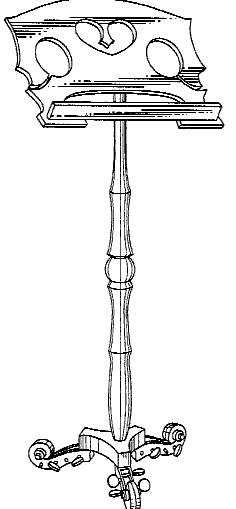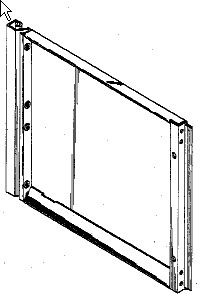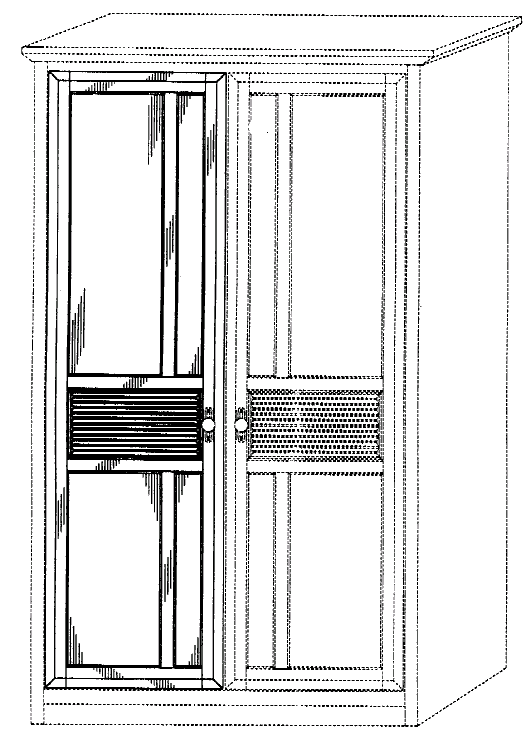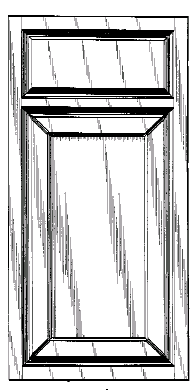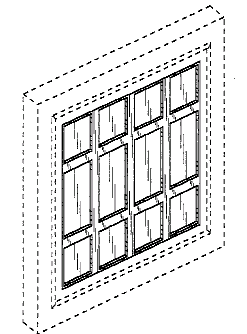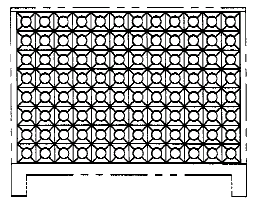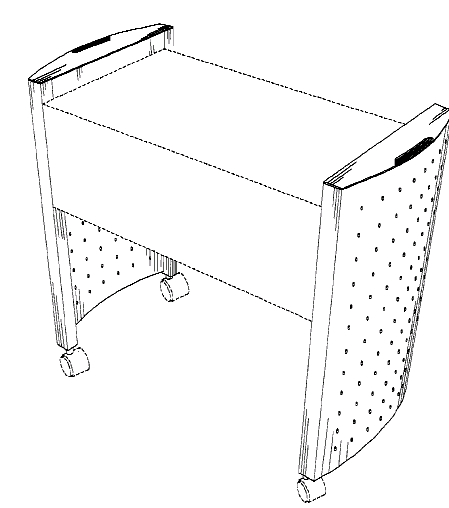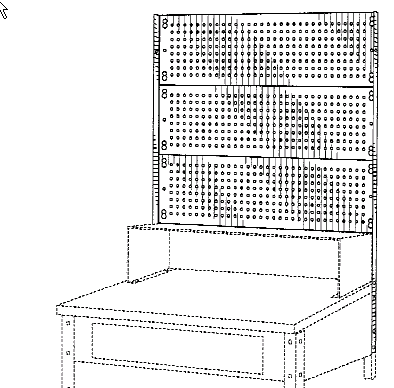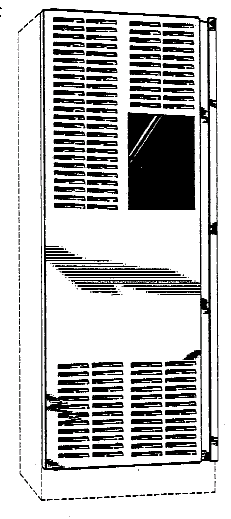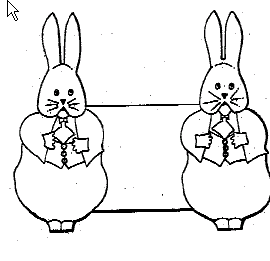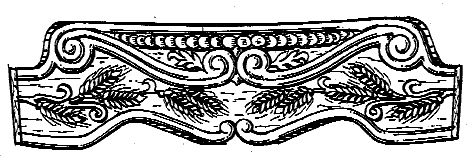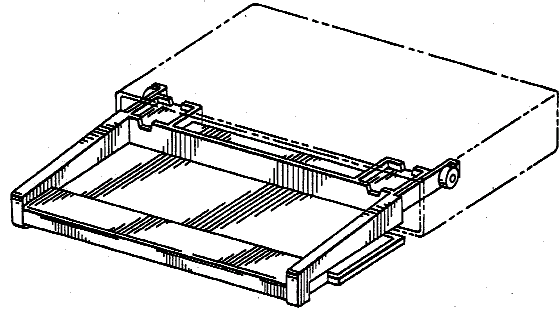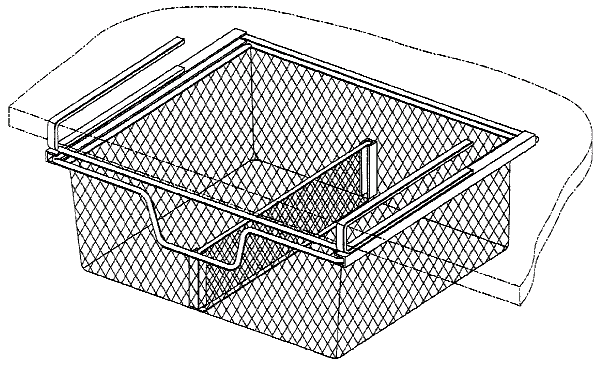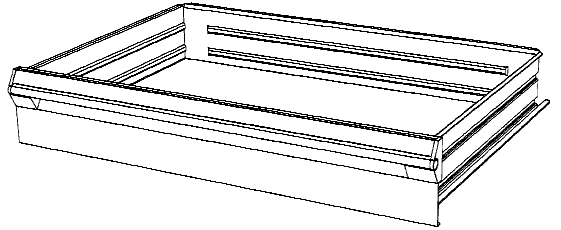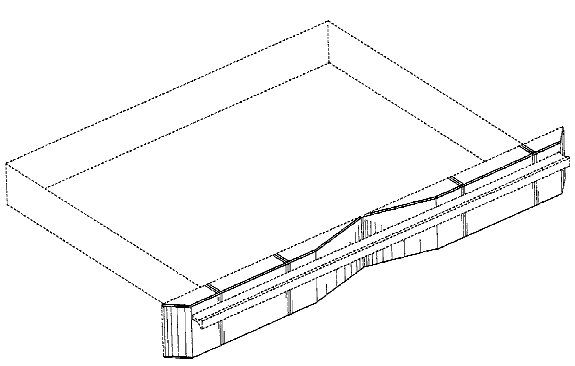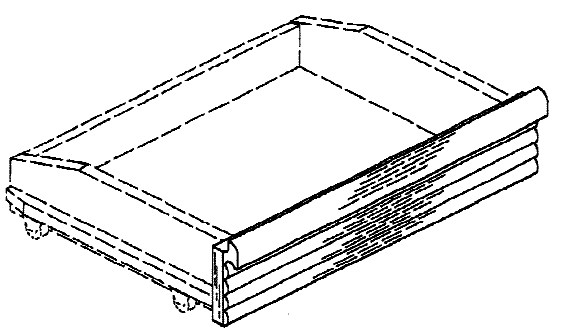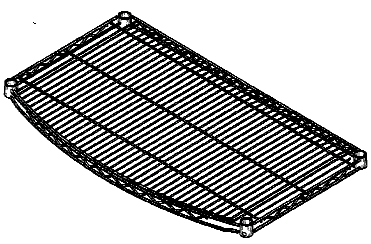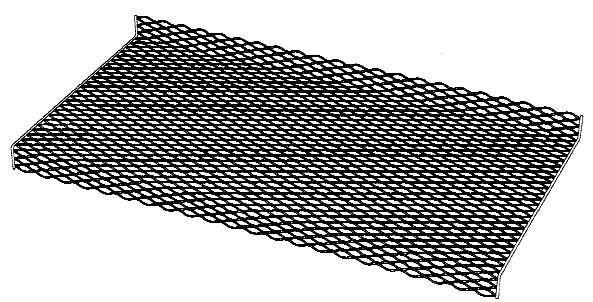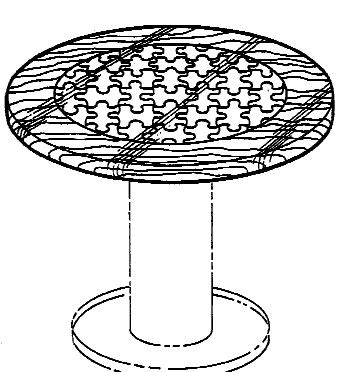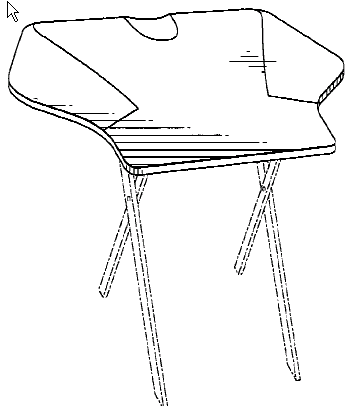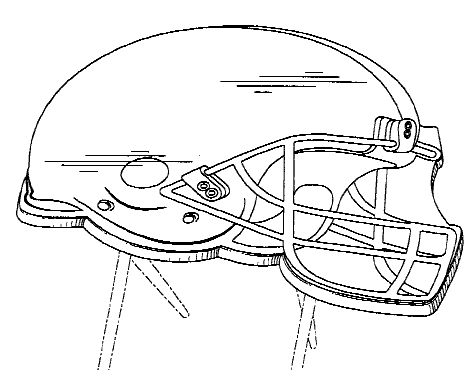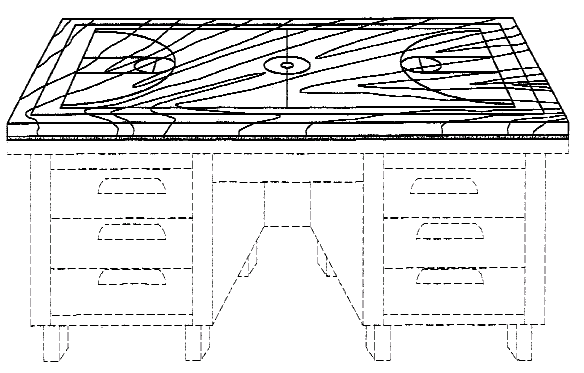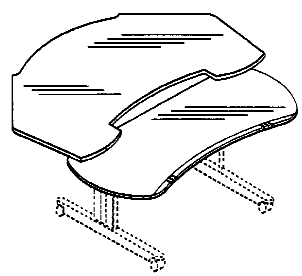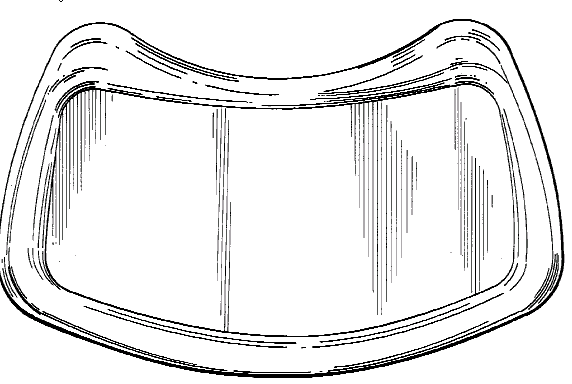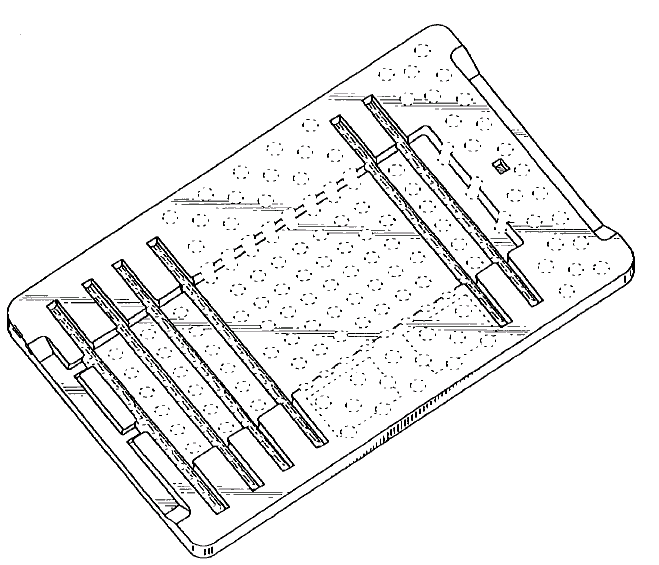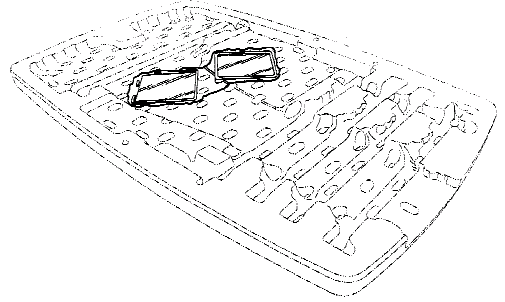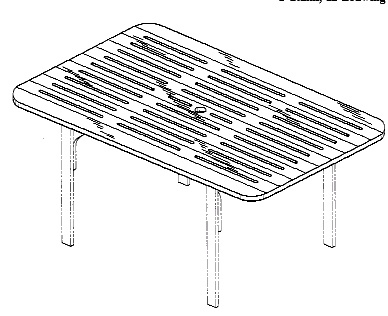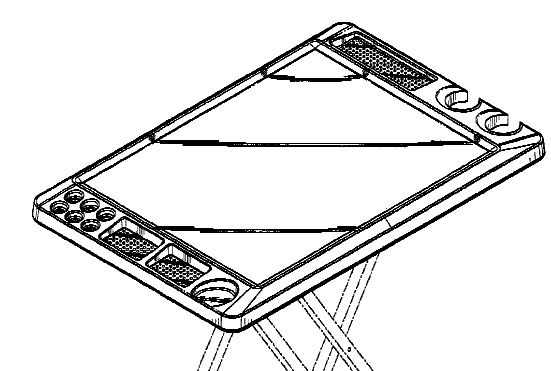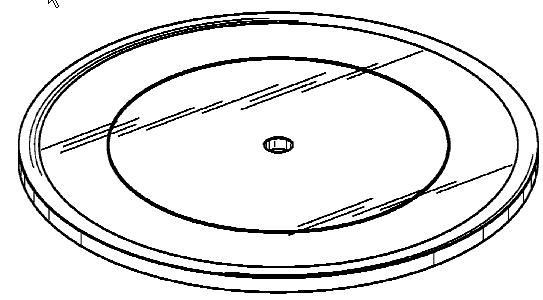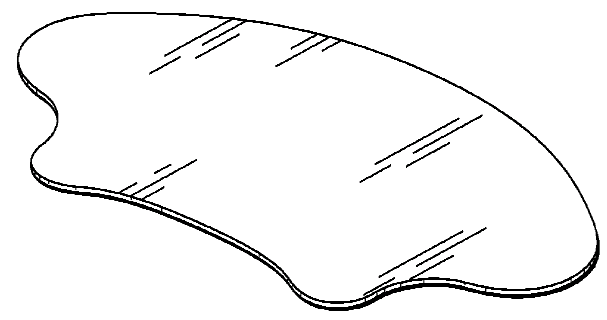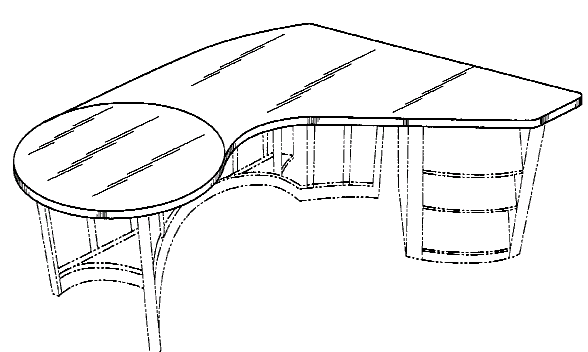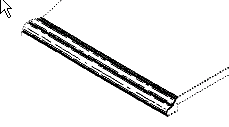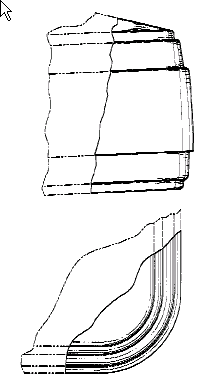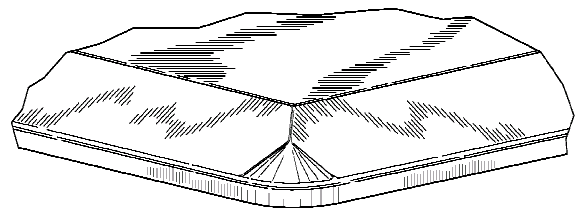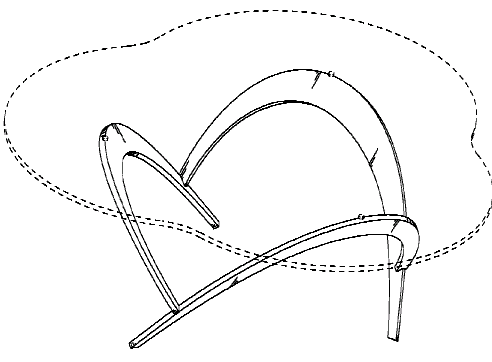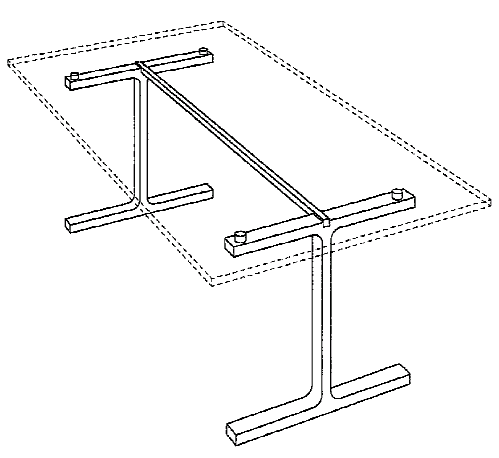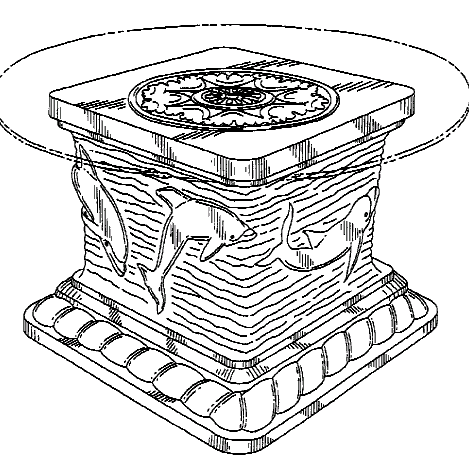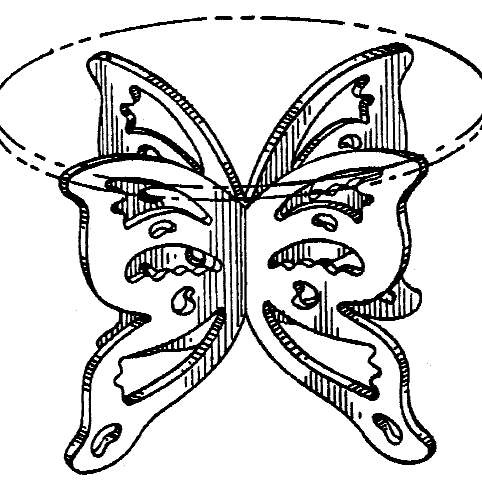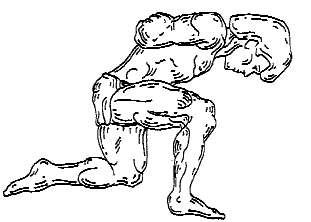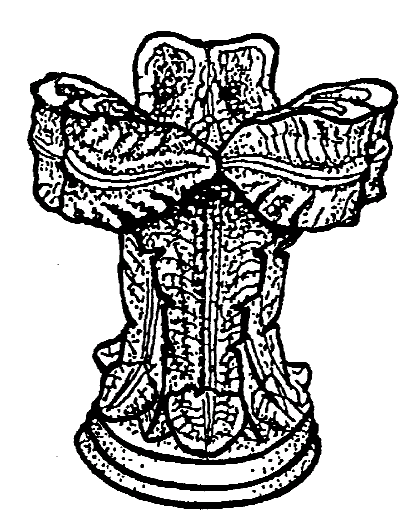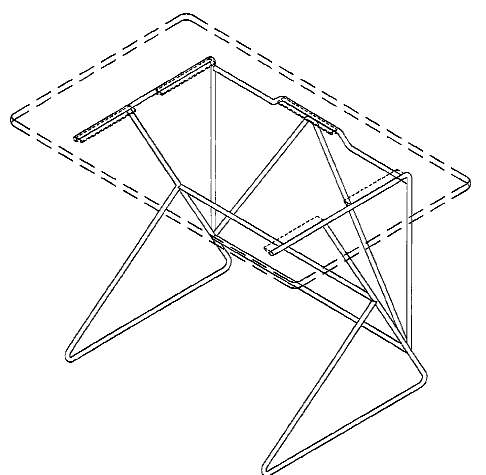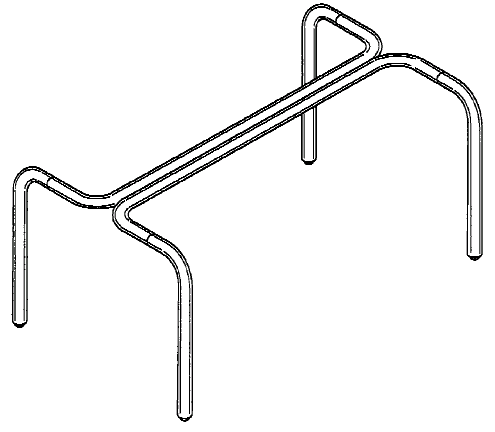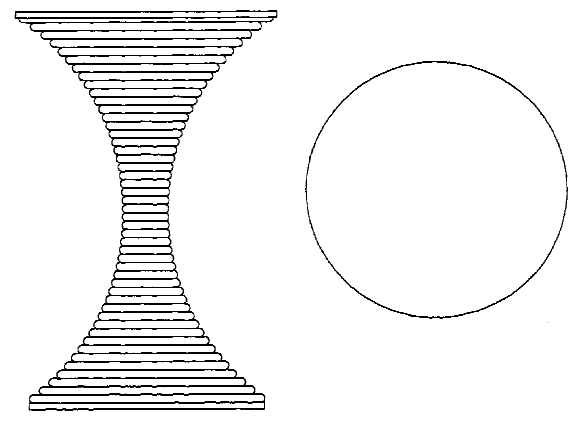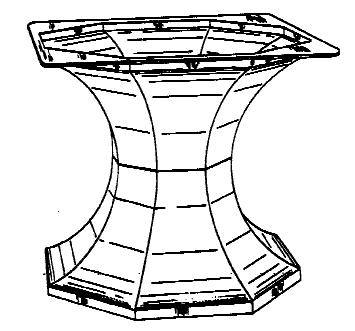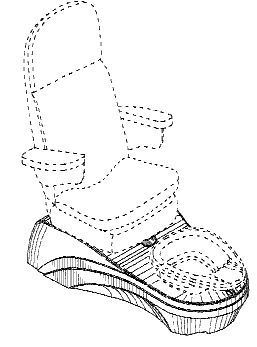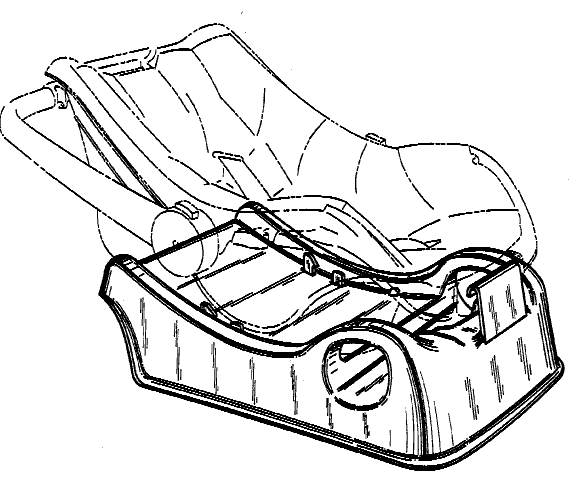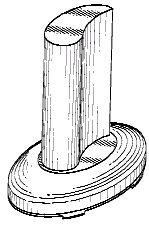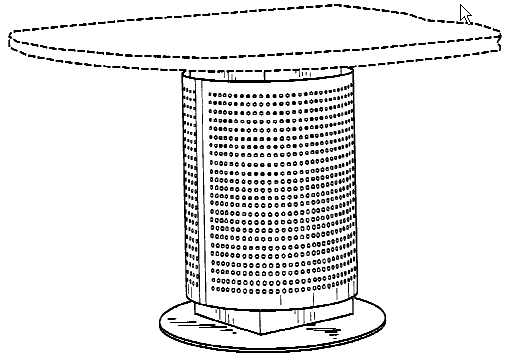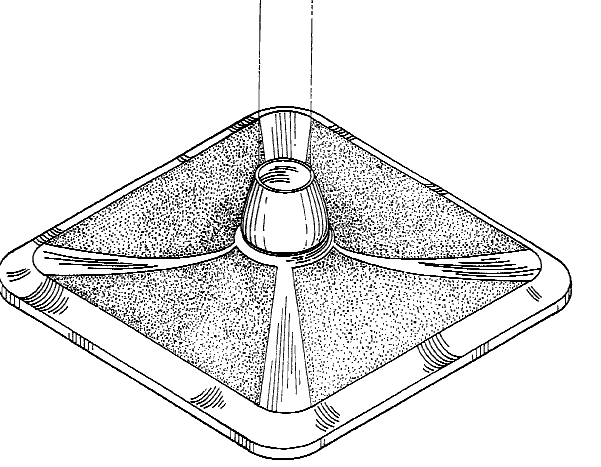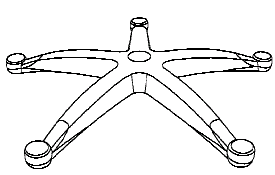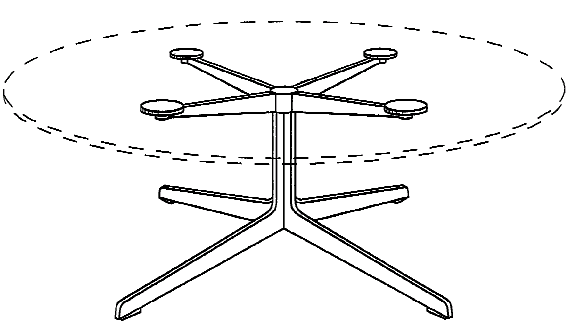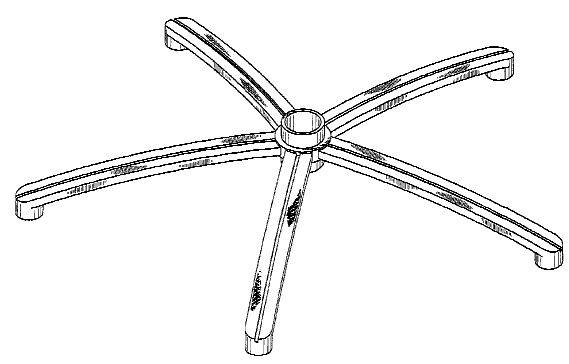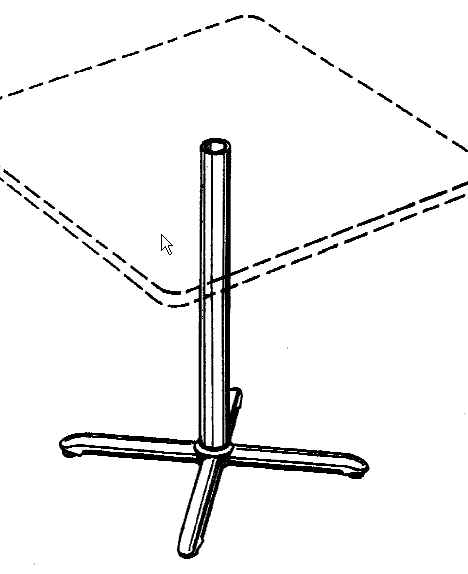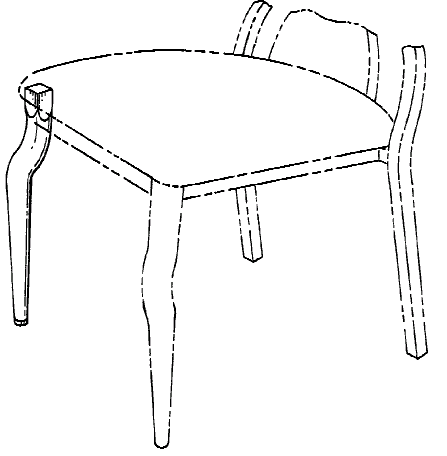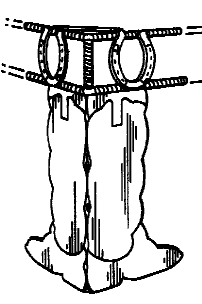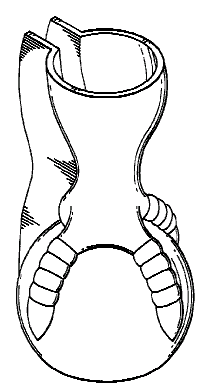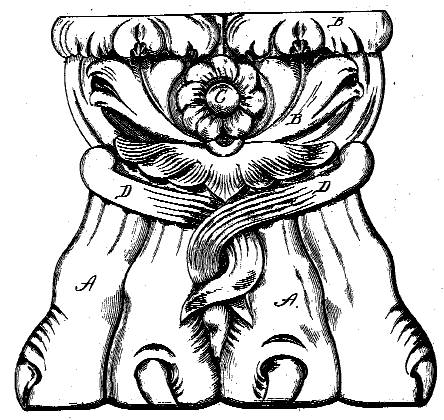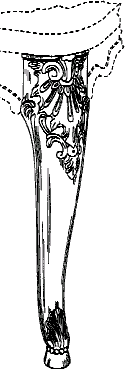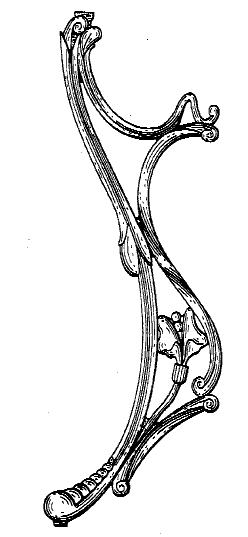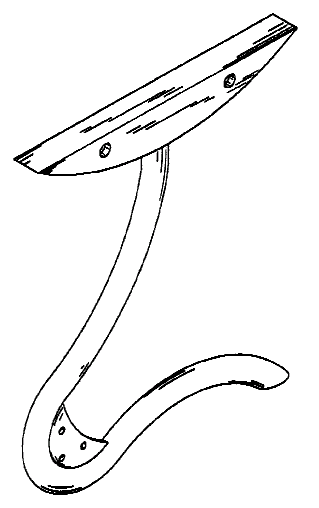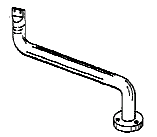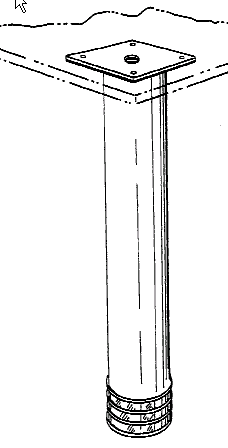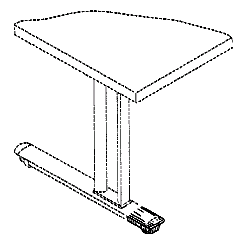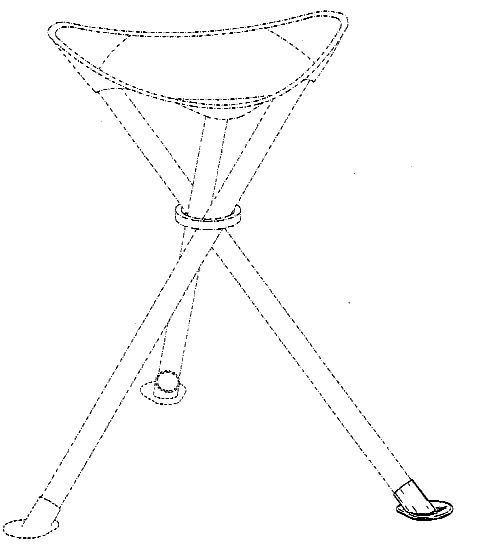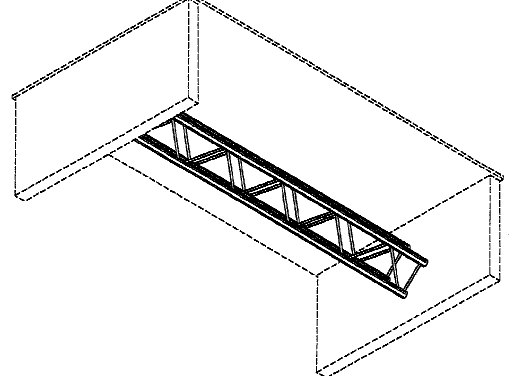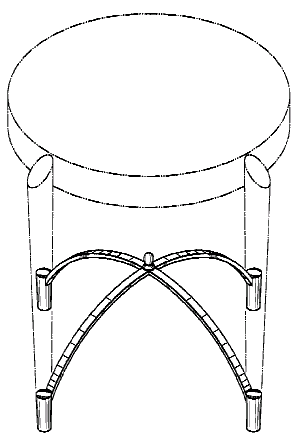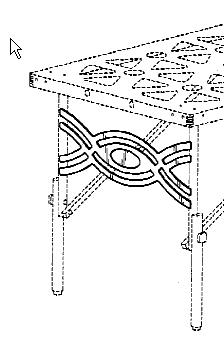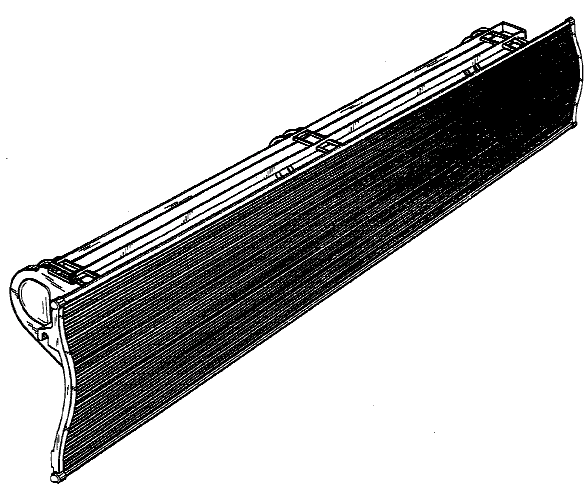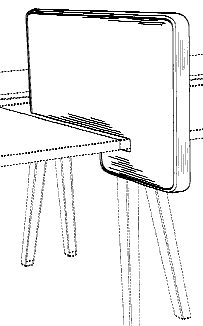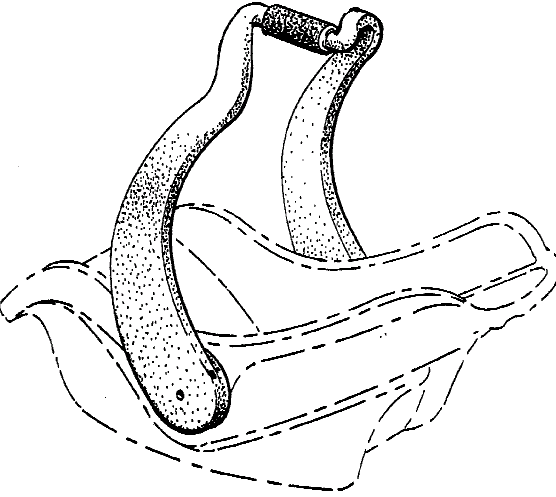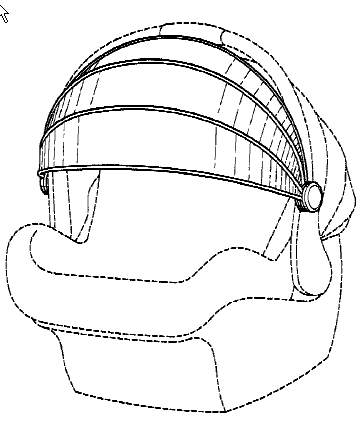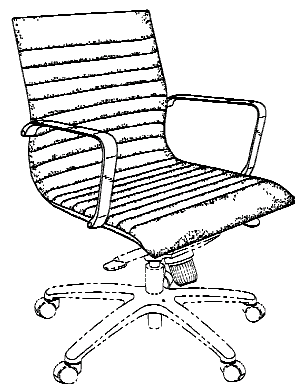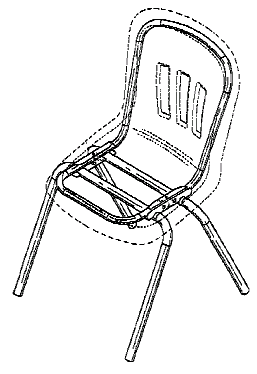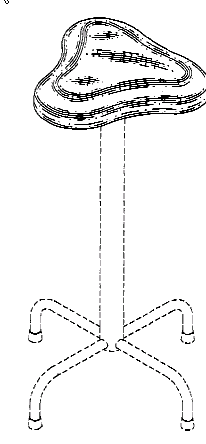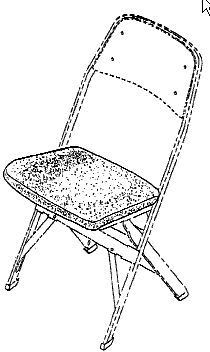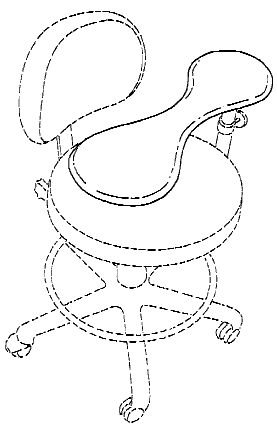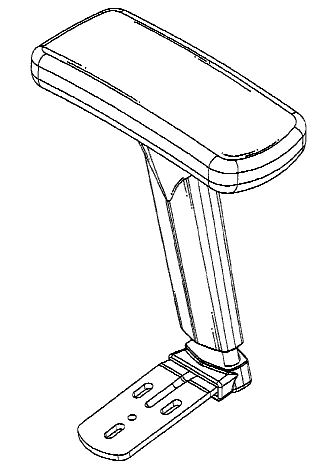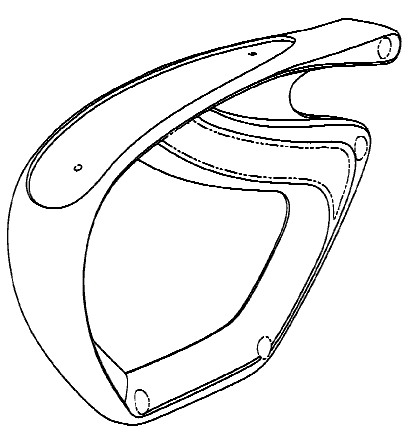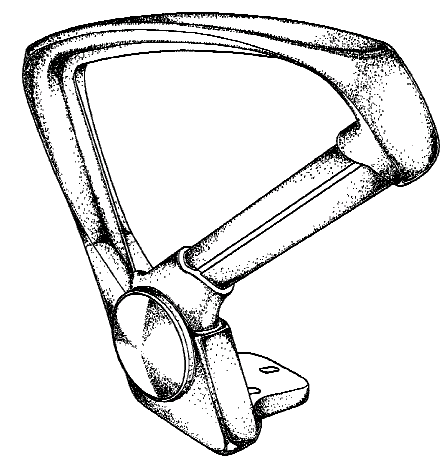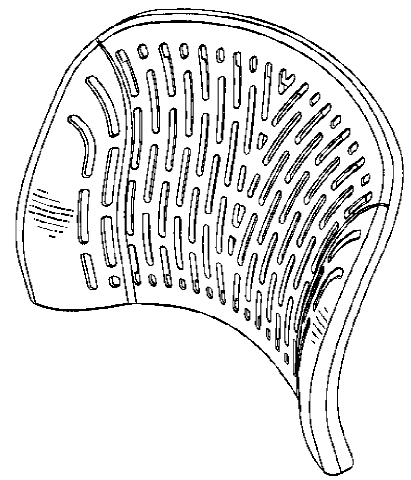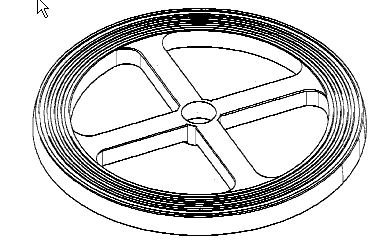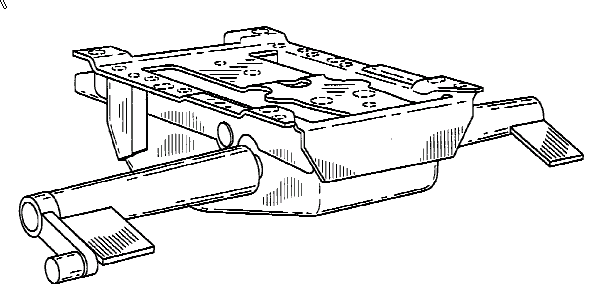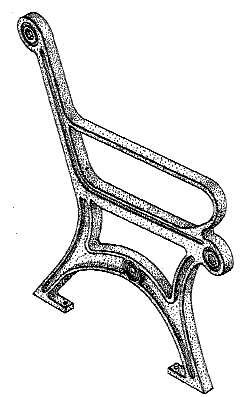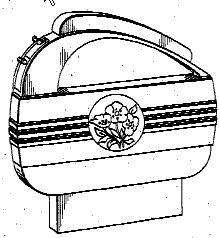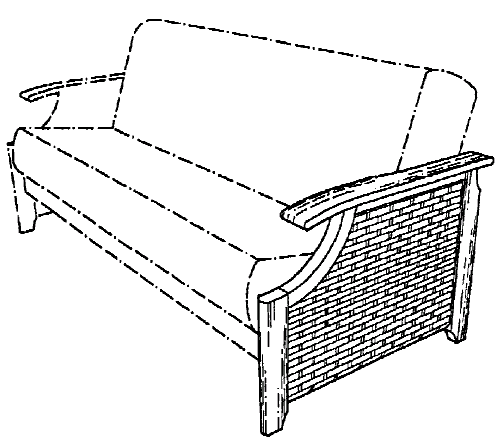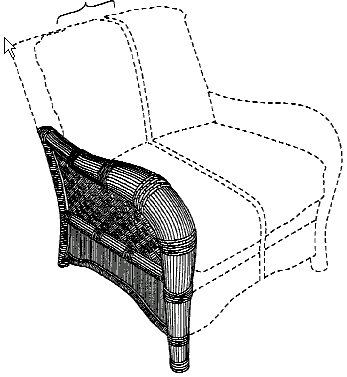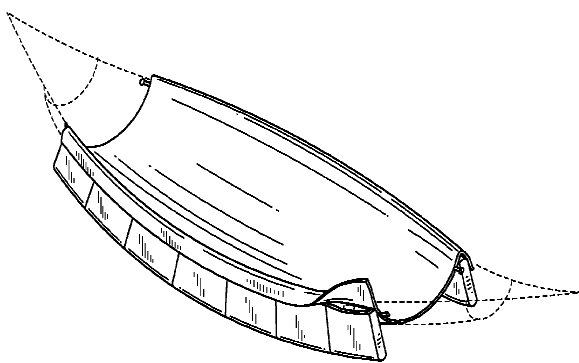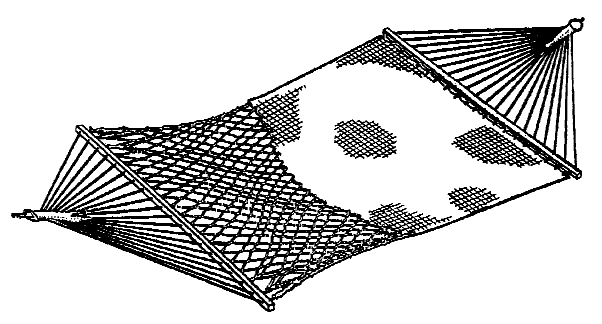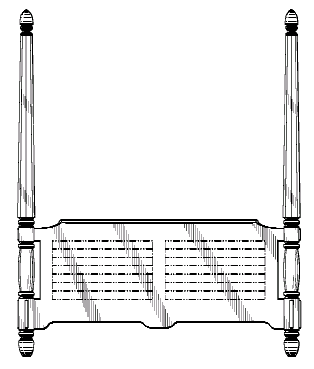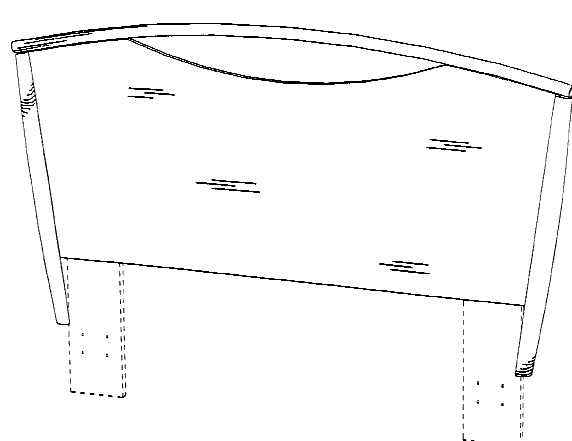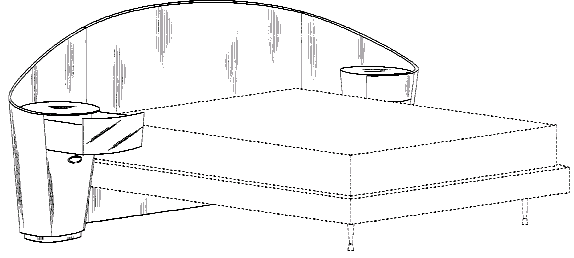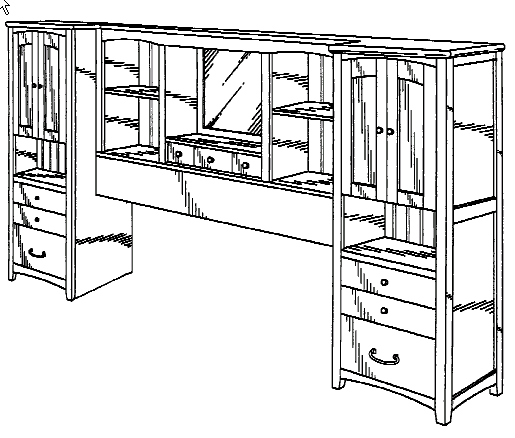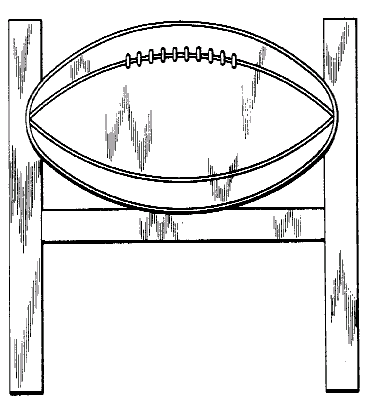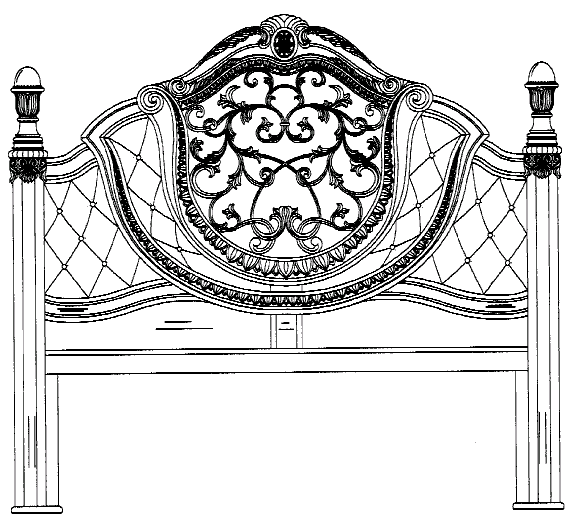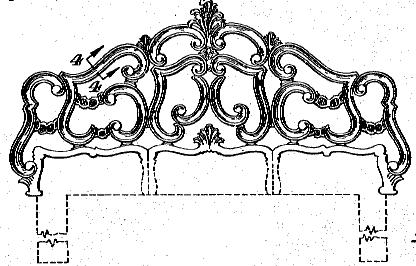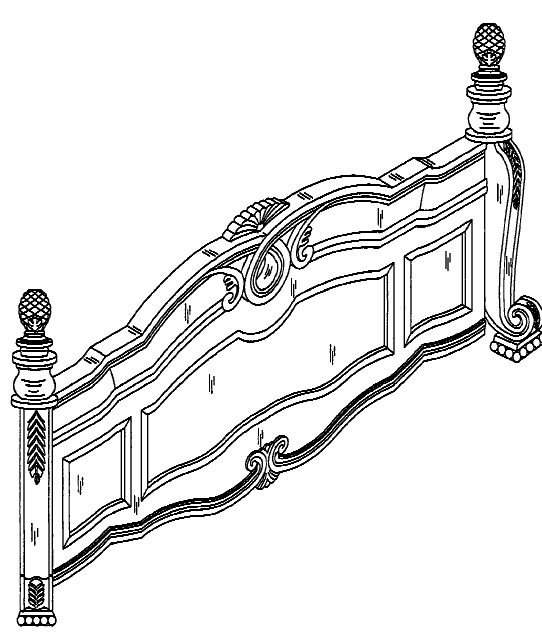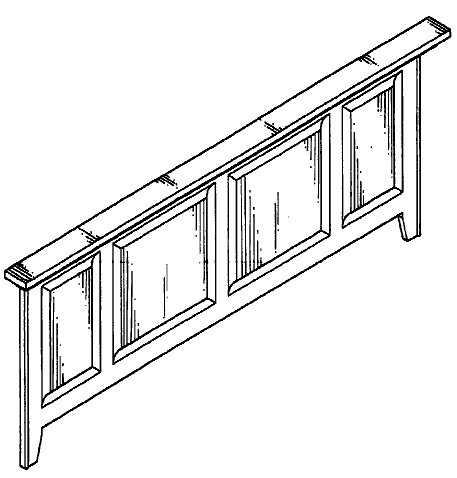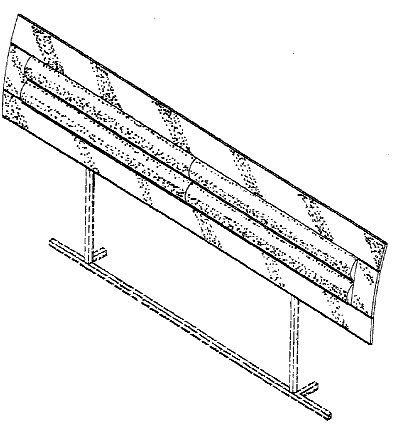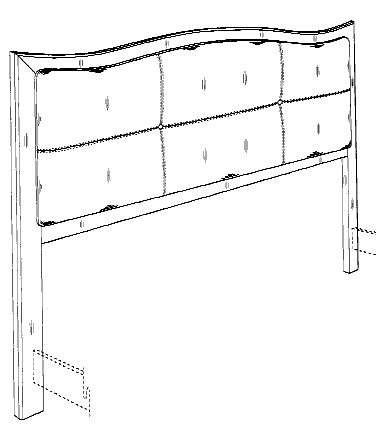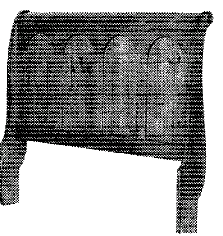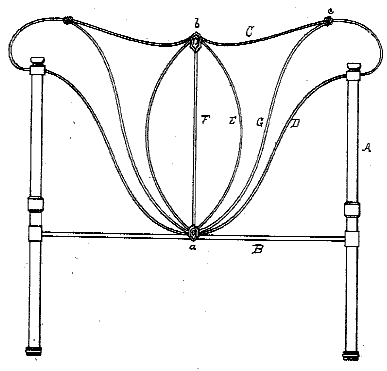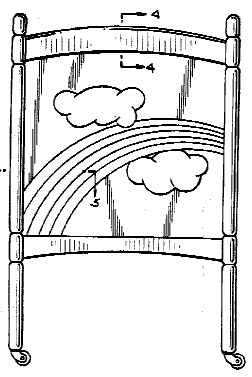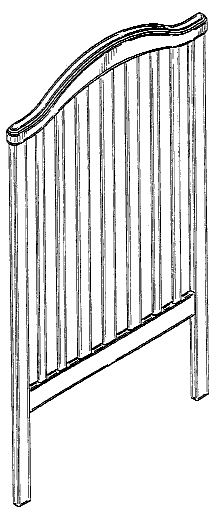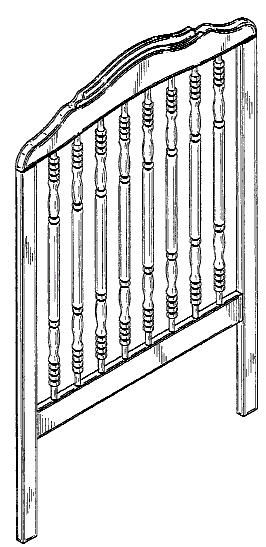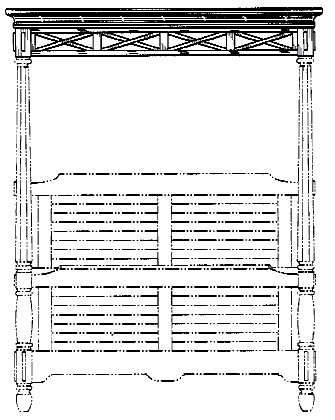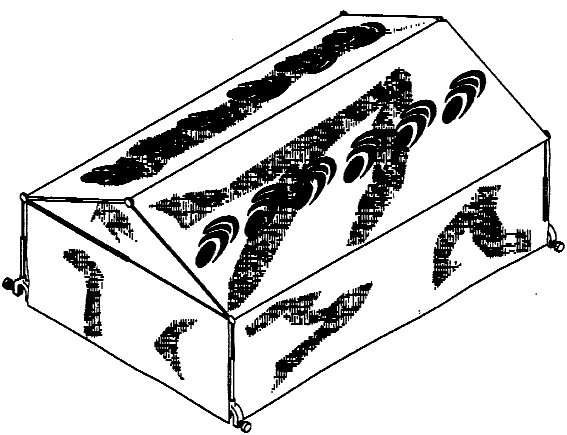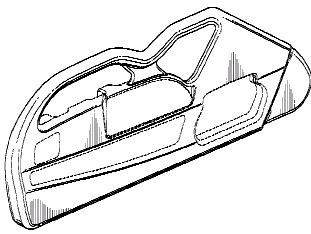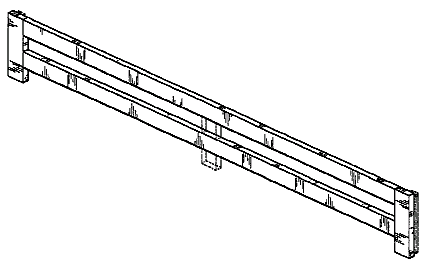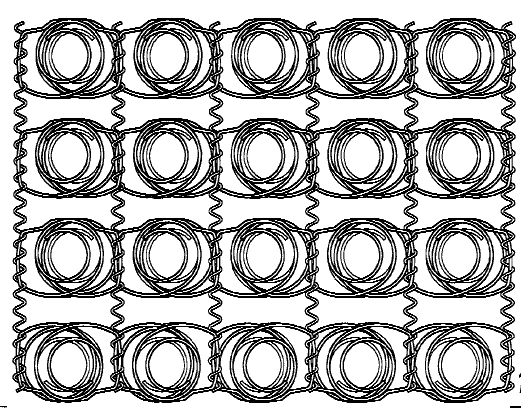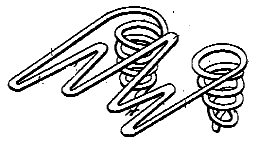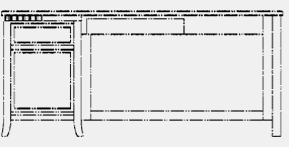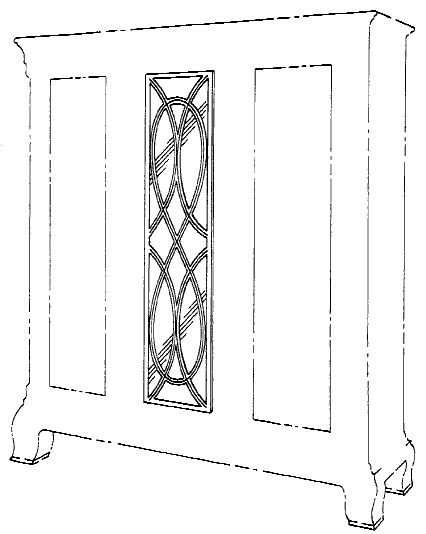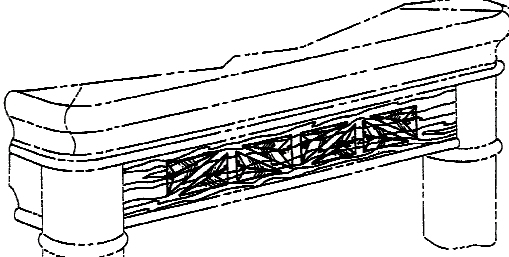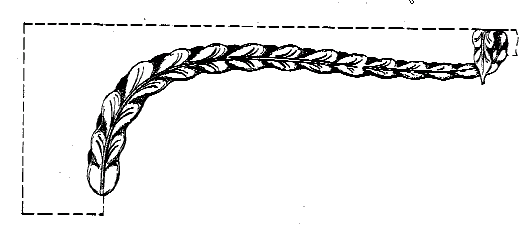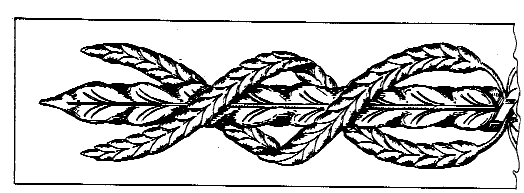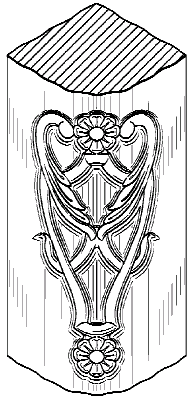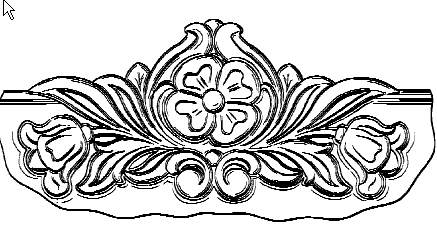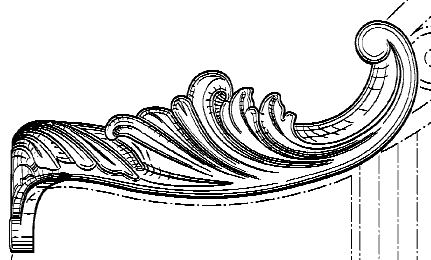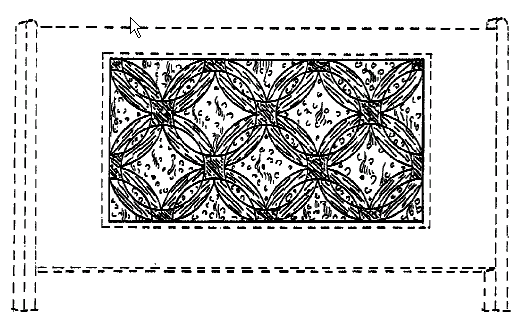![[Search a list of Patent Appplications for class D06]](../as.gif) CLASS D06, CLASS D06, | FURNISHINGS |
| Click here for a printable version of this file | |
SECTION I - CLASS DEFINITION
This class provides for design patents claiming ornamental designs for:
1. Mirror, frame, picture mount, or easel-type support
2. Apparel support
3. Furniture, freestanding support, or frame therefore
4. Article support, holder, or dispenser not otherwise provided for
5. Window covering
6. Carpet, floor mat, or rug
7. Household linen, mattress, or cushion
8. Elements or attachments specific to the above listed subject matter
| (1) Note. Design patents in this class are classified by what is claimed and shown in full lines only. Broken lines, which may be included in design patent drawings, are considered as environment only. |
| (2) Note. Definitions are provided for the mainline subclasses only. Definitions for the remaining subclass will be published at a future date. |
SECTION II - REFERENCES TO OTHER CLASSES
SEE OR SEARCH CLASS:
| D2, | Apparel and Haberdashery, subclass 719 for sleeping bag. |
| D3, | Travel Goods and Personal Belongings, subclasses 20 through 27for sewing supply caddy or carrier; subclasses 276-292, 900, 902 and 905 for suitcase, brief case and tool box; subclasses 304-314 for basket or open bin. |
| D7, | Equipment for Preparing or Serving Food or Drink Not Elsewhere Specified, subclass 388 for insulating mat for cooking range; subclass 590, for kitchen condiment container holder or spice rack; subclass 616 for drinking glass or bottle holder; subclass 637 for food processor blade support. |
| D8, | Tools and Hardware, for generic furniture hardware such as hinge, drawer handle, etc; subclass 71 for tool holder including bagging tool for packing groceries; subclass 303 for handgrip; subclasses 349-399 for fastener, support, or mount; subclasses 354-372 for hook or support for mirror or picture; subclass 375 for caster; subclass 403 for furniture corner protector; subclass 499 for shade locking or ratchet mechanism. |
| D11, | Jewelry, Symbolic Insignia, and Ornaments, subclasses 132 through 140for plaque or wall decoration; subclasses 143-156 for flowerpot or plant holder, including topiary plant form. |
| D12, | Transportation, subclass 115 for bicycle rack or holder; subclasses 128-133 for perambulator, invalid chair or stretcher; subclass 183 for window or curtain deflector for vehicle; subclasses 187-189 for vehicular rear view mirror; subclass 203 for vehicular mat, step or step plate; subclasses 415-426.1 for vehicle integrated holder for CD type disc. |
| D13, | Equipment for Production, Distribution, or Transformation of Energy, subclass 184 for casing or enclosure for electronic equipment not elsewhere specified. |
| D14, | Recording, Communication, or Informational Retrieval Equipment, subclasses 133 and 175-184 for cabinet for radio, television, or stereo. |
| D15, | Machines Not Elsewhere Specified, subclasses 66 through 78for sewing machine cabinets and parts; subclasses 151 and 152 for oil collecting cabinets. |
| D16, | Photography and Optical Equipment, subclass 129 for holder or support for eyeglasses. |
| D19, | Office Supplies; Artists and Teachers Materials, subclass 52 for blackboard or bulletin board; subclasses 75-80 for card file; subclasses 86-92 for desk tray document holder. |
| D20, | Sales and Advertising Equipment, subclasses 10 through 44for sign. |
| D21, | Games, Toys and Sports Goods, subclass 397 for game or card table; subclasses 416-417 for rocking horse; subclasses 519-522 for toy furniture; subclasses 686-691 for bench or body support for physical exercise; subclasses 783-784 for billiard or pool table; subclass 792 for golf training aid type mat; subclasses 823-825 for playground type swing. |
| D23, | Environmental Heating and Cooling; Fluid Handling and Sanitary Equipment, subclass 59 for sink combined with cabinet; subclasses 296-297 for toilet training chair; subclass 303 for support for plumbing fixture. |
| D24, | Medical and Laboratory Equipment, subclass 128 for holder or support rack for medical type equipment; subclass 183 for physician s examination table; subclass 199 for nursing bottle support; subclasses 224-226 for vessel for reagent material; subclasses 227-230 for medical tray, rack, or vessel holder; subclass 234 for laboratory ventilation hood. |
| D25, | Building Units and Construction Elements, subclass 55 for rigid drapery valance or cornice; subclass 64 and indented subclasses for ladder or stepladder; subclasses 119-137 for molding for picture frame or mirror. |
| D26, | Lighting, subclass 58 for table combined with lamp. |
| D27, | Tobacco and Smokers Supplies, subclass 102 for ash receiver, snuffer or support; subclass 184 for cigarette dispenser. |
| D28, | Cosmetic Products and Toilet Articles, subclass 15 for hair dryer combined with chair; subclass 63 for bath mitt or cloth; subclasses 64.1-64.7 for hand held mirror. |
| D30, | Animal Husbandry, subclasses 134 through 143for saddlery; subclass 145 for animal blanket. |
| D32, | Washing, Cleaning, or Drying Machines, subclass 57 for mat for sink or bathtub. |
| D34, | Material of Article Handling Equipment, subclasses 12 through 27for cart or dolly including wheeled television support stands. |
| D99, | Miscellaneous, subclass 25 for altar; subclass 28 for bank depository. |
SUBCLASSES
![[List of Patents for class D6 subclass 300]](../ps.gif) 300 300 | MIRROR, FRAME, PICTURE MOUNT, OR EASEL TYPE SUPPORT: | ||||||||||||||||||||
| This subclass is indented under the class definition. Design for decorative edges or surround for reflective mirror, frame
or art or an three-leg type holder or support for this
subject matter.
SEE OR SEARCH THIS CLASS, SUBCLASS:
SEE OR SEARCH CLASS:
| |||||||||||||||||||||
![[List of Patents for class D6 subclass 315]](../ps.gif) 315 315 | APPAREL SUPPORT: | ||||||||||||||||
This subclass is indented under the class definition. Design for holding or hanging clothing.
SEE OR SEARCH THIS CLASS, SUBCLASS:
SEE OR SEARCH CLASS:
| |||||||||||||||||
![[List of Patents for class D6 subclass 329]](../ps.gif) 329 329 | FURNITURE, FREESTANDING SUPPORT, OR FRAME THEREFOR: | ||||||||||||||||||||||||||||||||||||
| This subclass is indented under the class definition. Design for movable contents articles for household or office
use such as seating, tables, desks, display
and storage cabinets.
SEE OR SEARCH THIS CLASS, SUBCLASS:
SEE OR SEARCH CLASS:
| |||||||||||||||||||||||||||||||||||||
![[List of Patents for class D6 subclass 512]](../ps.gif) 512 512 | ARTICLE SUPPORT HOLDER OR DISPENSER NOT ELSEWHERE SPECIFIED: | ||||||||||||||||||||||||||||
This subclass is indented under the class definition. Design for mounting-type device or device that
dispenses contents in prescribed amounts not otherwise provided
for.
SEE OR SEARCH CLASS:
| |||||||||||||||||||||||||||||
![[List of Patents for class D6 subclass 575]](../ps.gif) 575 575 | WINDOW COVERING: | ||||||||
This subclass is indented under the class definition. Design for a shade or decorative hanging for opening in
a wall or roof in a building or vehicle such as a curtain, swag, valence
or Venetian blind.
SEE OR SEARCH CLASS:
| |||||||||
![[List of Patents for class D6 subclass 582]](../ps.gif) 582 582 | CARPET, FLOOR MAT, OR RUG: | ||||||
| This subclass is indented under the class definition. Design for a floor covering.
SEE OR SEARCH CLASS:
| |||||||
![[List of Patents for class D6 subclass 595]](../ps.gif) 595 595 | HOUSEHOLD LINEN, MATTRESS, OR CUSHION: | ||||||||||||
This subclass is indented under the class definition. Designs for household textile articles, bedding
or pillow.
SEE OR SEARCH CLASS:
| |||||||||||||
![[List of Patents for class D6 subclass 640]](../ps.gif) 640 640 | Freestanding telephone booth with side privacy screens: | ||||
| This subclass is indented under subclass 329. Design for a telephone booth with side or rear panels for
privacy.
SEE OR SEARCH THIS CLASS, SUBCLASS:
SEE OR SEARCH CLASS:
| |||||
![[List of Patents for class D6 subclass 641]](../ps.gif) 641 641 | Computer or office workstation, table, desk, drafting table, or school desk: | ||||||||||||||
This subclass is indented under subclass 329. Design for a work surface, table or desk that is primarily
used by a seated user, for office and computer equipment
use, i.e., kneehole desks, workstations
with storage for office supplies, workstations, or
desks with keyboard pullout trays, drafting tables, and
school desks.
SEE OR SEARCH THIS CLASS, SUBCLASS:
SEE OR SEARCH CLASS:
| |||||||||||||||
![[List of Patents for class D6 subclass 642]](../ps.gif) 642 642 | Combined with disparate article or convertible to another use or expandable with leaves: | ||||
This subclass is indented under subclass 641. Design for a computer or office workstation or desk that
is combined with another article, i.e., a
desk combined with a sofa bed, desk combined with lamp, desk
combined with a clock.
SEE OR SEARCH THIS CLASS, SUBCLASS:
| |||||
![[List of Patents for class D6 subclass 643]](../ps.gif) 643 643 | With privacy screen, e.g., study carrel, voting booth, etc.: |
| This subclass is indented under subclass 641. Design for a computer, office workstation, or
desk that includes a privacy screen and panel(s) around
the top.
Figure 1. Example of a design for a portable modular votingbooth .
Figure 2. Example of a design for a carrel. | |
![[List of Patents for class D6 subclass 643.1]](../ps.gif) 643.1 643.1 | For multiple users: |
| This subclass is indented under subclass 643. Design for a study carrel or voting booth with provisions for multiple users. | |
![[List of Patents for class D6 subclass 644]](../ps.gif) 644 644 | For multiple users: |
| This subclass is indented under subclass 641. Design for a computer or office workstation or desk that shows a distinct provision for plural users. | |
![[List of Patents for class D6 subclass 645]](../ps.gif) 645 645 | Simulative: |
| This subclass is indented under subclass 641. Design for computer or office workstations, tables, or desks that include an ornamental feature or features that simulate the ornamental appearance of another object either as applied ornamentation or in form. | |
![[List of Patents for class D6 subclass 646]](../ps.gif) 646 646 | With tambour enclosure: |
| This subclass is indented under subclass 641. Design for a computer or office workstation or desk that
includes a tambour enclosure, i.e., rolling
door panel.
Figure 1. Example of a design for a child’sroll-top desk. | |
![[List of Patents for class D6 subclass 647]](../ps.gif) 647 647 | Top spaced from leg support: |
| This subclass is indented under subclass 641. Design for a computer or office workstation, or desk
that includes a space or gap between the top and leg supports.
Figure 1. Example of a design for a desk top spaced fromsupport. | |
![[List of Patents for class D6 subclass 648]](../ps.gif) 648 648 | L-shaped or U-shaped corner unit: |
| This subclass is indented under subclass 641. Design for a computer or office workstation or desk wherein
the top surface is either L-Shaped or a corner unit (U-shape).
Figure 1. Example of a design for a work station.
Figure 2. Example of a design for a desk. | |
![[List of Patents for class D6 subclass 648.1]](../ps.gif) 648.1 648.1 | With tubular supports: |
| This subclass is indented under subclass 648. Design for an L-shaped or U-shaped workstation wherein the supports are wire or tubular. | |
![[List of Patents for class D6 subclass 648.2]](../ps.gif) 648.2 648.2 | With shelf above top: |
| This subclass is indented under subclass 648. Design for an L-shaped or U-shaped workstation that includes a shelf above the top of the work surface. | |
![[List of Patents for class D6 subclass 648.3]](../ps.gif) 648.3 648.3 | Multiple shelves above top, e.g., hutch-like, etc.: |
| This subclass is indented under subclass 648.2. Design for an L-shaped or U-shaped workstation
that includes a multiple shelves or storage above the top of the
work surface.
Figure 1. Example of a design for a personal computer console. | |
![[List of Patents for class D6 subclass 648.4]](../ps.gif) 648.4 648.4 | With keyboard pull-out shelf under top: |
| This subclass is indented under subclass 648. Design for an L-shaped or U-shaped workstation that includes a keyboard shelf below the top of the work surface. | |
![[List of Patents for class D6 subclass 649]](../ps.gif) 649 649 | Top with more than four sides: |
| This subclass is indented under subclass 641. Design for a computer or office workstation wherein in top
plan there are more than four sides.
Figure 1. Example of a design for a school desk. | |
![[List of Patents for class D6 subclass 650]](../ps.gif) 650 650 | Freeform or curved top: |
| This subclass is indented under subclass 641. Design for a computer or office workstation that shows a
single top surface that is freeform with curved edges.
Figure 1. Example of a design for a desk withcurved edges. | |
![[List of Patents for class D6 subclass 650.1]](../ps.gif) 650.1 650.1 | Transparent top: |
| This subclass is indented under subclass 650. Design for a computer or office workstation that shows a transparent freeform top. | |
![[List of Patents for class D6 subclass 651]](../ps.gif) 651 651 | Knee-hole-type desk with storage adjacent to legs on both sides: |
| This subclass is indented under subclass 641. Design for a computer or office workstation or desk wherein
there is storage on both sides adjacent to the user’s knees.
Figure 1. Example of a design for a desk withstorage on both sides. | |
![[List of Patents for class D6 subclass 651.1]](../ps.gif) 651.1 651.1 | With shelf above work surface: |
| This subclass is indented under subclass 651. Design includes storage adjacent to legs on both sides and a single shelf above the work surface top. | |
![[List of Patents for class D6 subclass 651.2]](../ps.gif) 651.2 651.2 | Multiple shelves, e.g., hutch-like, etc.: |
| This subclass is indented under subclass 651.1. Design includes storage adjacent to legs on both sides and multiple shelves or storage above the top of the work surface. | |
![[List of Patents for class D6 subclass 652]](../ps.gif) 652 652 | Knee-hole type storage adjacent to legs on one side of knee hole: |
| This subclass is indented under subclass 641. Design for a computer or office workstation or desk wherein
there is storage on one side adjacent to the user’s knees.
Figure 1. Example of a design for a desk at oneleg. | |
![[List of Patents for class D6 subclass 652.1]](../ps.gif) 652.1 652.1 | With shelf above work surface: |
| This subclass is indented under subclass 652. Design includes storage adjacent to legs on one side and a single shelf above the work surface top. | |
![[List of Patents for class D6 subclass 652.2]](../ps.gif) 652.2 652.2 | Multiple shelves, e.g., hutch-like, etc.: |
| This subclass is indented under subclass 652.1. Design includes storage adjacent to legs on one side and multiple shelves or storage above the top of the work surface. | |
![[List of Patents for class D6 subclass 653]](../ps.gif) 653 653 | With shelf or storage, e.g., drawer, etc., both above and below the work surface: |
| This subclass is indented under subclass 641. Design for a computer or office workstation or desk that includes a shelf or storage both above and below the primary work surface. | |
![[List of Patents for class D6 subclass 653.1]](../ps.gif) 653.1 653.1 | With multiple shelves or storage both above and below work surface: |
| This subclass is indented under subclass 653. Design includes multiple shelving or storage both above
and below the primary work surface.
Figure 1. Example of a design for a desk withshelves above and storage below work surface.
Figure 2. Example of a design for a desk for adesk with shelves above and below work surface. | |
![[List of Patents for class D6 subclass 653.11]](../ps.gif) 653.11 653.11 | With tubular supports: |
| This subclass is indented under subclass 653.1. Design for a workstation with multiple shelving above and
below the top and wherein the supports are wire or tubular.
Figure 1. Example of a design for a workstationhaving shelving above and below work surface with tubular supports. | |
![[List of Patents for class D6 subclass 653.12]](../ps.gif) 653.12 653.12 | With transparent top: |
| This subclass is indented under subclass 653.11. Design for a workstation with multiple shelving above and
below the top and wherein the supports are wire or tubular and the
primary work surface is transparent.
Figure 1. Example of a design for a workstationhaving shelving above and below work surface with transparent top. | |
![[List of Patents for class D6 subclass 653.13]](../ps.gif) 653.13 653.13 | With unitary pedestal support: |
| This subclass is indented under subclass 653.1. Design for a workstation with multiple shelving above and below the top and wherein the support is a single unitary pedestal. | |
![[List of Patents for class D6 subclass 653.14]](../ps.gif) 653.14 653.14 | With dual leg supports: |
| This subclass is indented under subclass 653.1. Design for a workstation with multiple shelving above and
below the top and wherein the supports are two or dual pedestals.
Figure 1. Example of a design for a workstationhaving shelving above and below work surface with dual leg supports. | |
![[List of Patents for class D6 subclass 653.15]](../ps.gif) 653.15 653.15 | With transparent top: |
| This subclass is indented under subclass 653.1. Design for a workstation with multiple shelving above and
below the top and wherein the top is transparent.
Figure 1. Example of a design for a workstationhaving transparent top and shelving. | |
![[List of Patents for class D6 subclass 653.16]](../ps.gif) 653.16 653.16 | With recess on top of work surface: |
| This subclass is indented under subclass 653.1. Design for a workstation with multiple shelving above and below the top and wherein the top is provided with a recessed area. | |
![[List of Patents for class D6 subclass 653.17]](../ps.gif) 653.17 653.17 | Whole workstation is of a uniform thickness: |
| This subclass is indented under subclass 653. Design for a workstation that includes a single shelf or
storage area both above and below the primary work surface and is
formed of one material that has a uniform (same) thickness.
Figure 1. Example of a design for a workstationhaving uniform thickness and shelving. | |
![[List of Patents for class D6 subclass 653.18]](../ps.gif) 653.18 653.18 | With tubular supports: |
| This subclass is indented under subclass 653. Design for a workstation with a single shelf or storage
both above and below the top and wherein the supports are wire or
tubular.
Figure 1. Example of a design for a workstationhaving tubular supports and shelving.
Figure 2. Example of a design for a workstationhaving tubular supports and shelving. | |
![[List of Patents for class D6 subclass 653.19]](../ps.gif) 653.19 653.19 | With transparent top: |
| This subclass is indented under subclass 653.18. Design for a workstation with a single shelf or storage both above and below the top and wherein the supports are wire or tubular and the primary work surface is transparent. | |
![[List of Patents for class D6 subclass 653.2]](../ps.gif) 653.2 653.2 | With unitary pedestal support: |
| This subclass is indented under subclass 653. Design for a workstation with a single shelf or storage both above and below the top and wherein the support is a single unitary pedestal. | |
![[List of Patents for class D6 subclass 653.21]](../ps.gif) 653.21 653.21 | With dual leg supports: |
| This subclass is indented under subclass 653. Design for a workstation with a single shelf or storage both above and below the top and wherein the supports are two or dual pedestals. | |
![[List of Patents for class D6 subclass 653.22]](../ps.gif) 653.22 653.22 | With transparent top: |
| This subclass is indented under subclass 653. Design for a workstation with a single shelf or storage
both above and below the top and wherein the top is transparent.
Figure 1. Example of a design for a workstationhaving transparent top and shelving. | |
![[List of Patents for class D6 subclass 653.23]](../ps.gif) 653.23 653.23 | With recess on top of work surface: |
| This subclass is indented under subclass 653. Design for a workstation with a single shelf or storage both above and below the top and wherein the top is provided with a recessed area. | |
![[List of Patents for class D6 subclass 654]](../ps.gif) 654 654 | With shelf or storage, e.g. drawer, etc., above the work surface: |
| This subclass is indented under subclass 641. Design for a computer or office workstation or desk that
includes a single shelf or storage unit only above the primary work
surface.
Figure 1. Example of a design for a workstationwith shelf above work surface. | |
![[List of Patents for class D6 subclass 654.1]](../ps.gif) 654.1 654.1 | With multiple shelves or storage above work surface: |
| This subclass is indented under subclass 654. Design includes multiple shelving or storage above the primary
work surface.
Figure 1. Example of a design for a workstationwith shelves above work surface. | |
![[List of Patents for class D6 subclass 654.11]](../ps.gif) 654.11 654.11 | With wire or tubular supports: |
| This subclass is indented under subclass 654.1. Design includes multiple shelving or storage above work surface and wherein the supports are wire or tubular. | |
![[List of Patents for class D6 subclass 654.12]](../ps.gif) 654.12 654.12 | With transparent top: |
| This subclass is indented under subclass 654.11. Design for a workstation with multiple shelving above the top and wherein the supports are tubular and the top is transparent. | |
![[List of Patents for class D6 subclass 654.13]](../ps.gif) 654.13 654.13 | With unitary pedestal support: |
| This subclass is indented under subclass 654.1. Design for a workstation with multiple shelving above the
top and wherein the support is a single unitary pedestal.
Figure 1. Example of a design for a workstationwith shelves above work surface and unitary pedestal. | |
![[List of Patents for class D6 subclass 654.14]](../ps.gif) 654.14 654.14 | With dual leg supports: |
| This subclass is indented under subclass 654.1. Design for a workstation with multiple shelving above the top and wherein the supports are two dual or pedestals. | |
![[List of Patents for class D6 subclass 654.15]](../ps.gif) 654.15 654.15 | With transparent top: |
| This subclass is indented under subclass 654.1. Design for a workstation with multiple shelving above the top and wherein the top is transparent. | |
![[List of Patents for class D6 subclass 654.16]](../ps.gif) 654.16 654.16 | With recess on top of work surface: |
| This subclass is indented under subclass 654.1. Design for a workstation with multiple shelving above the top and wherein the top is provided with a recessed area. | |
![[List of Patents for class D6 subclass 654.17]](../ps.gif) 654.17 654.17 | Whole workstation is of a uniform thickness: |
| This subclass is indented under subclass 654. Design includes a single shelf or storage area above the
primary work surface and is formed of one material having a uniform
thickness.
Figure 1. Example of a design for a workstationhaving uniform thickness and shelf above work surface.
Figure 2. Example of a design for a workstationhaving uniform thickness and shelf above work surface. | |
![[List of Patents for class D6 subclass 654.18]](../ps.gif) 654.18 654.18 | With wire or tubular supports: |
| This subclass is indented under subclass 654. Design includes a single shelf or storage area above the
primary work surface and wherein the supports are wire or tubular.
Figure 1. Example of a design for a workstationhaving tubular supports and shelf above work surface.
Figure 2. Example of a design for a workstationhaving tubular supports and shelf above work surface. | |
![[List of Patents for class D6 subclass 654.19]](../ps.gif) 654.19 654.19 | With transparent top: |
| This subclass is indented under subclass 654.18. Design includes a single shelf or storage area above the primary work surface and wherein the supports are wire or tubular and the primary work surface is transparent. | |
![[List of Patents for class D6 subclass 654.2]](../ps.gif) 654.2 654.2 | With unitary pedestal support: |
| This subclass is indented under subclass 654. Design includes a single shelf or storage area above the
primary work surface and wherein the support is a single unitary
pedestal.
Figure 1. Example of a design for a workstationhaving a unitary pedestal and shelf above work surface. | |
![[List of Patents for class D6 subclass 654.21]](../ps.gif) 654.21 654.21 | With dual leg supports: |
| This subclass is indented under subclass 654. Design for a workstation with a single shelf or storage area above the top and wherein the supports are two or dual pedestals. | |
![[List of Patents for class D6 subclass 654.22]](../ps.gif) 654.22 654.22 | With transparent top: |
| This subclass is indented under subclass 654. Design for a workstation with a single shelf or storage area above the top and wherein the top is transparent. | |
![[List of Patents for class D6 subclass 654.23]](../ps.gif) 654.23 654.23 | With recess on top of work surface: |
| This subclass is indented under subclass 654. Design for a workstation with a single shelf or storage
area above the top and wherein the top is provided with a recessed
area.
Figure 1. Example of a design for a workstationhaving a recessed work surface and a shelf. | |
![[List of Patents for class D6 subclass 655]](../ps.gif) 655 655 | With shelf or storage, e.g. drawer, etc., below the work surface: |
| This subclass is indented under subclass 641. Design for a computer or office workstation or desk that
includes a shelf or storage only below the primary work surface.
Figure 1. Example of a design for a workstationshelf below work surface.
Figure 2. Example of a design for a workstationshelf below work surface. | |
![[List of Patents for class D6 subclass 655.1]](../ps.gif) 655.1 655.1 | With multiple shelves or storage below the work surface: |
| This subclass is indented under subclass 655. Design includes multiple shelving or storage below the primary
work surface.
Figure 1. Example of a design for workstationshelves below work surface. | |
![[List of Patents for class D6 subclass 655.11]](../ps.gif) 655.11 655.11 | With wire or tubular supports: |
| This subclass is indented under subclass 655.1. Design includes multiple shelving or storage below work surface and wherein the supports are wire or tubular. | |
![[List of Patents for class D6 subclass 655.12]](../ps.gif) 655.12 655.12 | With transparent top: |
| This subclass is indented under subclass 655.11. Design includes multiple shelving or storage below work
surface and wherein the supports are wire or tubular and the primary work
surface is transparent.
Figure 1. Example of a design for workstationshelves below transparent work surface.
Figure 2. Example of a design for workstationshelves below transparent work surface. | |
![[List of Patents for class D6 subclass 655.13]](../ps.gif) 655.13 655.13 | With unitary pedestal support: |
| This subclass is indented under subclass 655.1. Design includes multiple shelving or storage below work surface and wherein the support is a unitary pedestal. | |
![[List of Patents for class D6 subclass 655.14]](../ps.gif) 655.14 655.14 | With dual leg supports: |
| This subclass is indented under subclass 655.1. Design includes multiple shelving or storage below work surface and wherein the supports are two pedestals. | |
![[List of Patents for class D6 subclass 655.15]](../ps.gif) 655.15 655.15 | With transparent top: |
| This subclass is indented under subclass 655.1. Design includes multiple shelving or storage below work surface and wherein the top is transparent. | |
![[List of Patents for class D6 subclass 655.16]](../ps.gif) 655.16 655.16 | With recess on top of work surface: |
| This subclass is indented under subclass 655.1. Design includes multiple shelving or storage below work surface and wherein the top is provided with a recessed area. | |
![[List of Patents for class D6 subclass 655.17]](../ps.gif) 655.17 655.17 | Whole workstation is of a uniform thickness: |
| This subclass is indented under subclass 655. Design includes a single shelf or storage area below primary work surface and is formed of one material having a uniform thickness. | |
![[List of Patents for class D6 subclass 655.18]](../ps.gif) 655.18 655.18 | With wire or tubular supports: |
| This subclass is indented under subclass 655. Design includes a single shelf or storage area below work
surface and wherein the supports are wire or tubular.
Figure 1. Example of a design for a workstationwith tubular supports and shelf below work surface. | |
![[List of Patents for class D6 subclass 655.19]](../ps.gif) 655.19 655.19 | With transparent top: |
| This subclass is indented under subclass 655.18. Design includes a single shelf or storage area below the
top and wherein the supports are wire or tubular and the primary
work surface is transparent.
Figure 1. Example of a design for a workstationhaving tubular supports, transparent top, and shelf below work surface.
Figure 2. Example of a design for a workstationhaving tubular supports, transparent top, and shelf below work surface. | |
![[List of Patents for class D6 subclass 655.2]](../ps.gif) 655.2 655.2 | With unitary pedestal support: |
| This subclass is indented under subclass 655. Design includes a single shelf or storage area below the top and wherein the support is a single unitary pedestal. | |
![[List of Patents for class D6 subclass 655.21]](../ps.gif) 655.21 655.21 | With dual leg supports: |
| This subclass is indented under subclass 655. Design includes a single shelf or storage area below the top and wherein the supports are two pedestals. | |
![[List of Patents for class D6 subclass 655.22]](../ps.gif) 655.22 655.22 | With transparent top: |
| This subclass is indented under subclass 655. Design includes a single shelf or storage area below the
top and wherein the top is transparent.
Figure 1. Example of a design for a workstationhaving transparent top and shelf below work surface.
Figure 2. Example of a design for a workstationhaving transparent top and shelf below work surface. | |
![[List of Patents for class D6 subclass 655.23]](../ps.gif) 655.23 655.23 | With recess on top of work surface: |
| This subclass is indented under subclass 655. Design includes a single shelf or storage area below the top and wherein the top is provided with a recessed area. | |
![[List of Patents for class D6 subclass 656]](../ps.gif) 656 656 | Single work surface without storage: |
| This subclass is indented under subclass 641. Design for a computer or office workstation or desk that is not provided with storage or shelving. | |
![[List of Patents for class D6 subclass 656.1]](../ps.gif) 656.1 656.1 | Whole workstation is of a uniform thickness: |
| This subclass is indented under subclass 656. Design for a computer or office workstation that is formed of one material that has a uniform thickness. | |
![[List of Patents for class D6 subclass 656.11]](../ps.gif) 656.11 656.11 | Angled top surface: | ||
| This subclass is indented under subclass 656. Design for a computer or office workstation that is provided
with an angled (not flat) top.
SEE OR SEARCH THIS CLASS, SUBCLASS:
| |||
![[List of Patents for class D6 subclass 656.12]](../ps.gif) 656.12 656.12 | With wire or tubular supports: |
| This subclass is indented under subclass 656.11. Design for a computer or office workstation that is provided
with an angled top and wherein the supports are formed of a wire
or tubular material.
Figure 1. Example of a design for angled worksurface with tubular supports. | |
![[List of Patents for class D6 subclass 656.13]](../ps.gif) 656.13 656.13 | With wire or tubular supports: |
| This subclass is indented under subclass 656. Design for a computer or office workstation wherein the
supports are formed of a wire or tubular material.
Figure 1. Example of a design for a workstationwith tubular supports.
Figure 2. Example of a design for a workstationwith tubular supports. | |
![[List of Patents for class D6 subclass 656.14]](../ps.gif) 656.14 656.14 | With transparent top: |
| This subclass is indented under subclass 655.13. Design for a computer or office workstation wherein the supports are formed of a wire or tubular material and the top is transparent. | |
![[List of Patents for class D6 subclass 656.15]](../ps.gif) 656.15 656.15 | With unitary pedestal support: |
| This subclass is indented under subclass 656. Design for a computer or office workstation wherein the
support is a single pedestal.
Figure 1. Example of a design for workstationwith a unitary pedestal. | |
![[List of Patents for class D6 subclass 656.16]](../ps.gif) 656.16 656.16 | With dual leg supports: |
| This subclass is indented under subclass 656. Design for a computer or office workstation wherein the
supports are two pedestals.
Figure 1. Example of a design for a workstationwith dual legs.
Figure 2. Example of a design for a workstationwith dual legs. | |
![[List of Patents for class D6 subclass 656.17]](../ps.gif) 656.17 656.17 | With symmetrical leg extensions, i.e. same length front to rear: |
| This subclass is indented under subclass 655.16. Design for a computer or office workstation wherein the
supports are two pedestals and the vertical legs are centered symmetrically
on the vertical foot.
Figure 1. Example of a design for a workstationwith symmetrical leg extensions.
Figure 2. Example of a design for a workstationwith symmetrical leg extensions. | |
![[List of Patents for class D6 subclass 656.18]](../ps.gif) 656.18 656.18 | With transparent top: |
| This subclass is indented under subclass 656. Design for a computer or office workstation wherein the top is transparent. | |
![[List of Patents for class D6 subclass 656.19]](../ps.gif) 656.19 656.19 | With recess on top of work surface: |
| This subclass is indented under subclass 656. Design for a computer or office workstation wherein the
top is provided with a recess.
Figure 1. Example of a design for a workstationwith recessed work surface.
Figure 2. Example of a design for a portable typewriter desk. | |
![[List of Patents for class D6 subclass 657]](../ps.gif) 657 657 | Combined visible and enclosed storage (includes showcase): | ||||
This subclass is indented under subclass 329. Design includes closed and open storage areas, and
storage with transparent or visible panels, i.e., both
enclosed drawers and panels with open shelving, or with
transparent panels or showcase for one unit having both shelving holding
articles seen by an observer and a cabinet.
| |||||
![[List of Patents for class D6 subclass 658]](../ps.gif) 658 658 | Simulative: |
| This subclass is indented under subclass 657. Design for a combined closed and opened storage cabinet
or similar article that includes an ornamental feature or features
that simulate the ornamental appearance of another object either as
applied ornamentation or in form.
Figure 1. Example of a design for simulative visibleand enclosed storage. | |
![[List of Patents for class D6 subclass 659]](../ps.gif) 659 659 | All doors or panels of storage are transparent allowing visibility from all sides: |
| This subclass is indented under subclass 657. Design that is completely enclosed with transparent panel
or door(s) for viewing.
Figure 1. Example of a design for transparentvisible and enclosed storage. | |
![[List of Patents for class D6 subclass 660]](../ps.gif) 660 660 | With inset component and at least one transparent door or panel: |
| This subclass is indented under subclass 657. Design with combined closed and open storage with distinct
superposed or inset portion and includes open bin or shelf-type
area, closed door, panel, or drawer(s), and
with transparent panel or door(s) for viewing.
Figure 1. Example of a design for a visible andenclosed storage with inset and transparent panel.
Figure 2. Example of a design for visible andenclosed storage with inset and transparent panel.
Figure 3. Example of a design for visible andenclosed storage with inset and transparent panel.
Figure 4. Example of a design for visible andenclosed storage with inset and transparent panel. | |
![[List of Patents for class D6 subclass 661]](../ps.gif) 661 661 | With transparent door or panel: | ||||
This subclass is indented under subclass 657. Design for a combined closed and open or visible storage
that includes open shelf or bin area; opaque panel, door, or
drawer(s); and with transparent panel
or door(s) for viewing.
SEE OR SEARCH THIS CLASS, SUBCLASS:
| |||||
![[List of Patents for class D6 subclass 661.1]](../ps.gif) 661.1 661.1 | Triangular case type, e.g., flag display, etc.: |
| This subclass is indented under subclass 661. Design having a three-sided shape and
with transparent panel or door for viewing.
Figure 1. Example of a design for a transparentpanel flag display case. | |
![[List of Patents for class D6 subclass 661.2]](../ps.gif) 661.2 661.2 | Inclined viewing surface: |
| This subclass is indented under subclass 661. Design for an enclosed storage article that includes
slanted transparent panel or door that is completely enclosed and
has slanted transparent panel or door(s).
Figure 1. Example of a design for a curio cabinetwith inclined viewing surface.
Figure 2. Example of a design for visible andenclosed storage with inclined viewing surface. | |
![[List of Patents for class D6 subclass 661.3]](../ps.gif) 661.3 661.3 | Curved viewing surface: |
| This subclass is indented under subclass 661. Design includes curved transparent panel or door(s).
Figure 1. Example of a design for a cabinet havingvisible and enclosed storage with a curved transparent panel.
Figure 2. Example of a design for a cabinet havingvisible and enclosed storage with a curved transparent panel. | |
![[List of Patents for class D6 subclass 662]](../ps.gif) 662 662 | With inset or superposed distinct component and only opaque doors, panels, or drawers: |
| This subclass is indented under subclass 657. Design for a combined closed and open storage with distinct
inset or superposed portion and includes open bin or shelf-type
area, door, panel, or drawer(s), and
without transparent panel or door(s).
Figure 1. Example of a design for visible andenclosed storage with inset and transparent panel.
Figure 2. Example of a design for a hutch withinset. | |
![[List of Patents for class D6 subclass 662.1]](../ps.gif) 662.1 662.1 | With plural superposed or stepped surfaces: |
| This subclass is indented under subclass 662. Design for combined closed and open storage with distinct
plural superposed or stepped surfaces, and opaque doors, panels, or
drawers.
Figure 1. Example of a design for a bookcase with superposedsurfaces.
Figure 2. Example of a design for a bookcase with steppedsurfaces. | |
![[List of Patents for class D6 subclass 663]](../ps.gif) 663 663 | Enclosed storage, e.g., armoires, cabinets, dressers, chests, etc.: | ||||||||||||||||||
This subclass is indented under subclass 329. Design that completely encloses the articles to be stored, i.e., storage, cabinet, shelf, or
stand, which has a closed door, drawer, panel, or
bin.
SEE OR SEARCH THIS CLASS, SUBCLASS:
SEE OR SEARCH CLASS:
| |||||||||||||||||||
![[List of Patents for class D6 subclass 664]](../ps.gif) 664 664 | Combined with disparate article or convertible to another use: | ||
| This subclass is indented under subclass 663. Design that is combined with another article which, if
disclosed separately, would be proper subject matter for
an indented subclass or another design patent class, e.g., an
enclosed cabinet combined with lamp, etc.; or
if design converts to another use when in an opened or folded state, either
with or without being combined with a different article.
SEE OR SEARCH CLASS:
| |||
![[List of Patents for class D6 subclass 664.1]](../ps.gif) 664.1 664.1 | With mirror: |
| This subclass is indented under subclass 671. Design includes one or more reflective surfaces for use
or viewing.
Figure 1. Example of a design for a dresser withmirror. | |
![[List of Patents for class D6 subclass 665]](../ps.gif) 665 665 | Simulative: |
| This subclass is indented under subclass 663. Design for enclosed storage that includes an ornamental
feature or features that simulate the ornamental appearance of another
object either as applied ornamentation or in form.
Figure 1. Example of a design for a castle-shaped dresser.
Figure 2. Example of a design for an article storagecontainer. | |
![[List of Patents for class D6 subclass 665.1]](../ps.gif) 665.1 665.1 | Animate: |
| This subclass is indented under subclass 665. Design includes an ornamentation feature or features that
simulate the ornamental appearance of an animal or part of an animal, including
animated human, either as applied ornamentation or in general
form.
Figure 1. Example of a design for an animate-shapedtoy box.
Figure 2. Example of a design for an animate-shaped dresser. | |
![[List of Patents for class D6 subclass 666]](../ps.gif) 666 666 | Tambour closure: |
| This subclass is indented under subclass 663. Design includes rolling door or panel(s).
Figure 1. Example of a design for a closed roll-topcabinet.
Figure 2. Example of a design for an open roll-topcabinet. | |
![[List of Patents for class D6 subclass 667]](../ps.gif) 667 667 | Opening top: | ||
This subclass is indented under subclass 663. Design includes at least one door or panel(s) that
opens from top.
| |||
![[List of Patents for class D6 subclass 668]](../ps.gif) 668 668 | Curved front or side: |
| This subclass is indented under subclass 663. Design includes one or more curved panels at any surface.
Figure 1. Example of a design for a curved frontenclosure. | |
![[List of Patents for class D6 subclass 668.1]](../ps.gif) 668.1 668.1 | Plural exterior closures: |
| This subclass is indented under subclass 668. Design includes at least one curved door, panel, or
drawer.
Figure 1. Example of a design for a curved-frontdresser.
Figure 2. Example of a design for a curved-frontchest.
Figure 3. Example of a design for a curved-frontand curved-edge dresser. | |
![[List of Patents for class D6 subclass 668.2]](../ps.gif) 668.2 668.2 | Symmetrical about vertical or horizontal axis: |
| This subclass is indented under subclass 668.1. Design that shows identical halves if divided vertically
through the horizontal or vertical center or both.
Figure 1. Example of a design for a symmetricalfurniture unit.
Figure 2. Example of a design for a symmetricaldresser.
Figure 3. Example of a design for a symmetricalbureau. | |
![[List of Patents for class D6 subclass 669]](../ps.gif) 669 669 | Five or more sides: |
| This subclass is indented under subclass 663. Design includes five or more sides in plan.
Figure 1. Example of a design for a corner cabinetwith six sides. | |
![[List of Patents for class D6 subclass 670]](../ps.gif) 670 670 | Inclined front surface: |
| This subclass is indented under subclass 663. Design includes one or more slanted surfaces.
Figure 1. Example of a design for a gun cabinetwith inclinded front.
Figure 2. Example of a design for a cabinet with inclinedfront. | |
![[List of Patents for class D6 subclass 671]](../ps.gif) 671 671 | Plural exterior closures: |
| This subclass is indented under subclass 663. Design includes enclosed storage and has more than
one door, panel, or drawer(s).
Figure 1. Example of a design for an armoire withclosures. | |
![[List of Patents for class D6 subclass 671.1]](../ps.gif) 671.1 671.1 | Symmetrical about vertical or horizontal axis: |
| This subclass is indented under subclass 671. Design that shows identical halves if divided horizontally
or vertically.
Figure 1. Example of a design for an entertainmentcenter.
Figure 2. Example of a design for a symmetrical dresser. | |
![[List of Patents for class D6 subclass 671.2]](../ps.gif) 671.2 671.2 | Inset or superposed distinct components, e.g., hutch, chest-on-chest type, etc.: | ||||
| This subclass is indented under subclass 671. Design includes or combines more than one door, panel, or
drawer(s), and distinct vertically stacked
or stepped section(s).
SEE OR SEARCH THIS CLASS, SUBCLASS:
SEE OR SEARCH CLASS:
| |||||
![[List of Patents for class D6 subclass 671.3]](../ps.gif) 671.3 671.3 | With backsplash or irregular top surface: |
| This subclass is indented under subclass 671.2. Design includes plural doors, panels, or
drawers, and distinct superposed portion that has backsplash
top or irregular top.
Figure 1. Example of a design for a dinner setcabinet with irregular top surface. | |
![[List of Patents for class D6 subclass 671.4]](../ps.gif) 671.4 671.4 | With backsplash or irregular top surface: |
| This subclass is indented under subclass 671. Design includes backsplash top or irregular top.
Figure 1. Example of a design for a chest of drawers withbacksplash top.
Figure 2. Example of a design for a breakfrontarmoire with irregular top. | |
![[List of Patents for class D6 subclass 672]](../ps.gif) 672 672 | Visible storage or merchandise display, e.g., bookcases, racks, cupboards, retail and display fixtures, etc.: | ||||||||||||||||||||||||||||||||
This subclass is indented under subclass 329. Design for article with open storage area(s) such
as a stand, bookcase, rack, cupboard, or jewelry
stand that does not have a closed door, drawer, or
panel.
SEE OR SEARCH THIS CLASS, SUBCLASS:
SEE OR SEARCH CLASS:
| |||||||||||||||||||||||||||||||||
![[List of Patents for class D6 subclass 673]](../ps.gif) 673 673 | Combined with disparate article or convertible to another use: |
| This subclass is indented under subclass 672. Design that is combined with another article which, if disclosed separately, would be proper subject matter for an indented subclass or another design patent class, or if design converts to another use when in an opened or folded state, either with or without being combined with different article, etc. | |
![[List of Patents for class D6 subclass 674]](../ps.gif) 674 674 | Simulative: |
| This subclass is indented under subclass 672. Design includes an ornamentation feature or features
that simulate the ornamental appearance of another object either
as applied ornamentation or in form.
Figure 1. Example of a design for a pregnant-shaped stand.
Figure 2. Example of a design for a jewelry display rack. | |
![[List of Patents for class D6 subclass 674.1]](../ps.gif) 674.1 674.1 | Animate: | ||
| This subclass is indented under subclass 674. Design includes an ornamentation feature or features
that simulate the ornamental appearance of an animal or part of
an animal, including animated human, either as
applied ornamentation or in general form.
SEE OR SEARCH CLASS:
| |||
![[List of Patents for class D6 subclass 675]](../ps.gif) 675 675 | Square or rectangular in plan: |
| This subclass is indented under subclass 672. Design that has a four-sided shape and
four substantially right angles.
Figure 1. Example of a design for a rectangularspeaker stand.
Figure 2. Example of a design for a swivel squarestorage unit. | |
![[List of Patents for class D6 subclass 675.1]](../ps.gif) 675.1 675.1 | Superposed repeating surfaces: |
| This subclass is indented under subclass 675. Design that has at least two shelves, i.e., one shelf
directly above and equal to the perimeter or within the perimeter
of another, similar shelf.
Figure 1. Example of a design for a superposedbin rack.
Figure 2. Example of a design for a superposedshelving unit. | |
![[List of Patents for class D6 subclass 675.2]](../ps.gif) 675.2 675.2 | Wire, tubular, or uniform cross-section support surface: | ||
| This subclass is indented under subclass 675.1. Design that has tubular or wire supports.
SEE OR SEARCH THIS CLASS, SUBCLASS:
| |||
![[List of Patents for class D6 subclass 675.3]](../ps.gif) 675.3 675.3 | Stepped surfaces: |
| This subclass is indented under subclass 675. Design that has plural horizontal stepped surfaces.
Figure 1. Example of a design for a stepped rack.
Figure 2. Example of a design for a stepped array. | |
![[List of Patents for class D6 subclass 675.4]](../ps.gif) 675.4 675.4 | Inclined surfaces: |
| This subclass is indented under subclass 675. Design that has slanted surfaces.
Figure 1. Example of a design for a display with inclinedsurfaces.
Figure 2. Example of a design for a pallet withinclined surfaces. | |
![[List of Patents for class D6 subclass 675.5]](../ps.gif) 675.5 675.5 | Wire, tubular, or uniform cross-section support surface: |
| This subclass is indented under subclass 675. Design that has tubular or wire supports.
Figure 1. Example of a design for a one-shelfwire rack.
Figure 2. Example of a design for a wire shoerack. | |
![[List of Patents for class D6 subclass 676]](../ps.gif) 676 676 | Triangular in plan: |
| This subclass is indented under subclass 672. Design that has a three-sided shape in
plan.
Figure 1. Example of a design for a triangulardisplay stand. | |
![[List of Patents for class D6 subclass 676.1]](../ps.gif) 676.1 676.1 | Superposed or repeating surfaces: |
| This subclass is indented under subclass 676. Design that has a superposed or repeating surfaces, i.e., shelf
on top of shelf.
Figure 1. Example of a design for a superposeddisplay stand. | |
![[List of Patents for class D6 subclass 676.2]](../ps.gif) 676.2 676.2 | Wire, tubular, or uniform cross-section support surfaces: | ||
| This subclass is indented under subclass 676.1. Design that has tubular, wire, or constant-thickness
shelf.
SEE OR SEARCH THIS CLASS, SUBCLASS:
| |||
![[List of Patents for class D6 subclass 676.3]](../ps.gif) 676.3 676.3 | Stepped surfaces: |
| This subclass is indented under subclass 676. Design that has horizontal stepped surfaces.
Figure 1. Example of a design for a stepped display stand. | |
![[List of Patents for class D6 subclass 676.4]](../ps.gif) 676.4 676.4 | Inclined surfaces: |
| This subclass is indented under subclass 676. Design that has slanted surfaces.
Figure 1. Example of a design for a display standwith inclined surfaces. | |
![[List of Patents for class D6 subclass 676.5]](../ps.gif) 676.5 676.5 | Wire, tubular, or uniform cross-section support surface: | ||
| This subclass is indented under subclass 676. Design that has wire, tubular, or
uniform cross-section support.
SEE OR SEARCH THIS CLASS, SUBCLASS:
| |||
![[List of Patents for class D6 subclass 677]](../ps.gif) 677 677 | Circular or oval in plan: |
| This subclass is indented under subclass 672. Design that has a round or elliptical shape.
Figure 1. Example of a design for a circular telephone stand.
Figure 2. Example of a design for an oval displayholder for a shoe. | |
![[List of Patents for class D6 subclass 677.1]](../ps.gif) 677.1 677.1 | Superposed or repeating surfaces: |
| This subclass is indented under subclass 677. Design that has a superposed or repeating surfaces.
Figure 1. Example of a design for a superposeddisplay stand for greeting card or the like. | |
![[List of Patents for class D6 subclass 677.2]](../ps.gif) 677.2 677.2 | Wire, tubular, or uniform cross-section support surfaces: | ||
| This subclass is indented under subclass 677.1. Design that has tubular, wire constant-thickness
shelf.
SEE OR SEARCH THIS CLASS, SUBCLASS:
| |||
![[List of Patents for class D6 subclass 677.3]](../ps.gif) 677.3 677.3 | Stepped surfaces: |
| This subclass is indented under subclass 677. Design that has plural horizontal stepped surfaces.
Figure 1. Example of a design for a stepped shelving unit. | |
![[List of Patents for class D6 subclass 677.4]](../ps.gif) 677.4 677.4 | Inclined surfaces: |
| This subclass is indented under subclass 677. Design that has slanted surfaces.
Figure 1. Example of a design for a display standwith inclined surfaces. | |
![[List of Patents for class D6 subclass 677.5]](../ps.gif) 677.5 677.5 | Wire, tubular, or uniform cross-section support surfaces: | ||
| This subclass is indented under subclass 677. Design that has tubular or wire supports.
SEE OR SEARCH THIS CLASS, SUBCLASS:
| |||
![[List of Patents for class D6 subclass 678]](../ps.gif) 678 678 | Five or more sides or free form in plan: |
| This subclass is indented under subclass 672. Design that has five-or-more-sided
shape or irregular shape in plan.
Figure 1. Example of a design for a five-sideddisplay stand.
Figure 2. Example of a design for a freeform display stand. | |
![[List of Patents for class D6 subclass 678.1]](../ps.gif) 678.1 678.1 | Superposed or repeating surfaces: |
| This subclass is indented under subclass 678. Design that has superposed or repeating surfaces. | |
![[List of Patents for class D6 subclass 678.2]](../ps.gif) 678.2 678.2 | Stepped surfaces: |
| This subclass is indented under subclass 678. Design that has plural horizontal stepped surfaces. | |
![[List of Patents for class D6 subclass 678.3]](../ps.gif) 678.3 678.3 | Inclined surfaces: |
| This subclass is indented under subclass 678. Design that has plural horizontal slanted surfaces. | |
![[List of Patents for class D6 subclass 678.4]](../ps.gif) 678.4 678.4 | Wire, tubular, or uniform cross-section support surfaces: | ||
| This subclass is indented under subclass 678. Design that has tubular, wire, or
constant-thickness shelf.
SEE OR SEARCH THIS CLASS, SUBCLASS:
| |||
![[List of Patents for class D6 subclass 679]](../ps.gif) 679 679 | Plural swinging panels, or provision therefor: |
| This subclass is indented under subclass 672. Design includes more than one article support in
a form of a panel in which the article support is mounted for rotatable
or for pivotal movement about a vertical or horizontal axis.
Figure 1. Example of a design for a swinging panelsdisplay stand.
Figure 2. Example of a design for a swinging panelsdisplay.
Figure 3. Example of a design for a swinging panelsdisplay stand. | |
![[List of Patents for class D6 subclass 680]](../ps.gif) 680 680 | Three or more repeats or uniform structure about vertical axis: | ||
| This subclass is indented under subclass 672. Design with three or more sides having the same
appearance.
SEE OR SEARCH THIS CLASS, SUBCLASS:
| |||
![[List of Patents for class D6 subclass 680.1]](../ps.gif) 680.1 680.1 | Horizontal axis: |
| This subclass is indented under subclass 680. Design is mounted for rotatable or for pivotal movement
about a horizontal axis.
Figure 1. Example of a design for a pivotabletool case.
Figure 2. Example of a design for a point-of-salemerchandise stand having rotating display. | |
![[List of Patents for class D6 subclass 680.2]](../ps.gif) 680.2 680.2 | Including retainer for specific article, e.g., notch, aperture, or holder, etc.: |
| This subclass is indented under subclass 680. Design with indentations, openings, clips, or tabs
to hold articles.
Figure 1. Example of a design for a display rackwith notch.
Figure 2. Example of a design for a display standwith clips.
Figure 3. Example of a design for a jewelry display standwith apertures. | |
![[List of Patents for class D6 subclass 680.3]](../ps.gif) 680.3 680.3 | Wire, tubular, or uniform cross-section support surfaces: | ||
| This subclass is indented under subclass 680. Design that has tubular or wire supports.
SEE OR SEARCH THIS CLASS, SUBCLASS:
| |||
![[List of Patents for class D6 subclass 681]](../ps.gif) 681 681 | With vertical frame or support, uniform in cross-section, including wire, tubular, or rectangular: | ||||
| This subclass is indented under subclass 672. Design that has an upright stand, constant thickness, and
slender rod, cylindrical, or a four-sided, four-right-angels
shape.
SEE OR SEARCH THIS CLASS, SUBCLASS:
| |||||
![[List of Patents for class D6 subclass 681.1]](../ps.gif) 681.1 681.1 | Straight or bent rod: |
| This subclass is indented under subclass 681. Vertical frame design including a horizontal bar, horizontal
post, or hook-like bar or post.
Figure 1. Example of a design for a straight-rodsales stand.
Figure 2. Example of a design for a wheeled supportfor a straight rod on a vertical frame. | |
![[List of Patents for class D6 subclass 681.2]](../ps.gif) 681.2 681.2 | With shelf or storage area: |
| This subclass is indented under subclass 681.1. Design includes shelf or storage area.
Figure 1. Example of a design for a display standwith shelf.
Figure 2. Example of a design for a clothes rackwith shelf. | |
![[List of Patents for class D6 subclass 681.3]](../ps.gif) 681.3 681.3 | Repeats or uniform structure about axis: |
| This subclass is indented under subclass 681.1. Design includes shelf or storage area.
Figure 1. Example of a design for a vertical standwith repeats.
Figure 2. Example of a design for a sewing treewith repeats. | |
![[List of Patents for class D6 subclass 682]](../ps.gif) 682 682 | Including retainer for specific article, e.g., musical instrument, etc.: | ||
| This subclass is indented under subclass 672. Design that has specific location(s) for
holding specific article(s) e.g., guitar, horn, etc.
SEE OR SEARCH THIS CLASS, SUBCLASS:
| |||
![[List of Patents for class D6 subclass 682.1]](../ps.gif) 682.1 682.1 | Aperture or opening: |
| This subclass is indented under subclass 682. Design with a single opening.
Figure 1. Example of a design for a stand withaperture.
Figure 2. Example of a design for an egg displaystand with opening. | |
![[List of Patents for class D6 subclass 682.2]](../ps.gif) 682.2 682.2 | Plural: |
| This subclass is indented under subclass 682.1. Design with more than one opening.
Figure 1. Example of a design for an eyeglassdisplay with apertures.
Figure 2. Example of a design for a bead storagecabinet with apertures. | |
![[List of Patents for class D6 subclass 682.3]](../ps.gif) 682.3 682.3 | Notch or clip: |
| This subclass is indented under subclass 682. Design with indentation or clip to hold a single article.
Figure 1. Example of a design for a holder withclip display. | |
![[List of Patents for class D6 subclass 682.4]](../ps.gif) 682.4 682.4 | Plural: |
| This subclass is indented under subclass 682.3. Design with plural indentations or clips to hold more than
one article.
Figure 1. Example of a design for a holding rackwith indentations.
Figure 2. Example of a design for a displayrack with clips. | |
![[List of Patents for class D6 subclass 682.5]](../ps.gif) 682.5 682.5 | Straight or bent rod: |
| This subclass is indented under subclass 682. Design with a post, bar, or hook-like
post or bar.
Figure 1. Example of a design for a decoratordisplay stand with bent rod. | |
![[List of Patents for class D6 subclass 682.6]](../ps.gif) 682.6 682.6 | Plural: |
| This subclass is indented under subclass 682.5. Design with plural hooks or posts to hold more than
one article.
Figure 1. Example of a design for a rack withbent rods.
Figure 2. Example of a design for a guitar standwith straight rods. | |
![[List of Patents for class D6 subclass 683]](../ps.gif) 683 683 | Bin-type, accessible from the top: | ||
| This subclass is indented under subclass 672. Design that has a single bin accessible from the top
or a single rack or stand or holder that has upwardly oriented barriers.
SEE OR SEARCH CLASS:
| |||
![[List of Patents for class D6 subclass 683.1]](../ps.gif) 683.1 683.1 | Plural bins or cells: |
| This subclass is indented under subclass 683. Design that has multiple bins or cells.
Figure 1. Example of a design for a file storagedevice with cells.
Figure 2. Example of a design for a bookcase withcells. | |
![[List of Patents for class D6 subclass 684]](../ps.gif) 684 684 | Workbench-type, i.e., with tool or work holder: | ||||
| This subclass is indented under subclass 672. Design for a workbench-type work surface.
SEE OR SEARCH CLASS:
| |||||
![[List of Patents for class D6 subclass 685]](../ps.gif) 685 685 | Table for seated user, e.g., patio, dining, cocktail, etc.: | ||||||||||||||||
| This subclass is indented under subclass 329. Design for a patio, dining, cocktail, or
end table that are not intended for use in an office or as a computer
support.
SEE OR SEARCH THIS CLASS, SUBCLASS:
SEE OR SEARCH CLASS:
| |||||||||||||||||
![[List of Patents for class D6 subclass 686]](../ps.gif) 686 686 | Combined with disparate article, convertible to another use, expandable with leaves, or collapsible: | ||||||||
| This subclass is indented under subclass 685. Design that combined with another article, if disclosed
separately, would be proper subject matter for an indented
subclass or another design patent class.
SEE OR SEARCH THIS CLASS, SUBCLASS:
SEE OR SEARCH CLASS:
| |||||||||
![[List of Patents for class D6 subclass 687]](../ps.gif) 687 687 | Sets, e.g., nested, stacked, superposed surfaces, etc.: |
| This subclass is indented under subclass 685. Design includes a set of tables wherein more than
one table is shown, i.e. nested, stacked,
or other arrangement of more than one table.
Figure 1. Example of a design for a set of inter-fittingtables.
Figure 2. Example of a design for a nesting table. | |
![[List of Patents for class D6 subclass 688]](../ps.gif) 688 688 | Simulative: |
| This subclass is indented under subclass 685. Design for a table that includes an ornamental feature
or features that simulate the ornamental appearance of another object
either as applied ornamentation or in form.
Figure 1. Example of a design for a flower table.
Figure 2. Example of a design for a simulativetable. | |
![[List of Patents for class D6 subclass 688.1]](../ps.gif) 688.1 688.1 | Sports motif: |
| This subclass is indented under subclass 688. Design for a table that includes an ornamental feature or
features that simulate the ornamental appearance of objects that
are sports related.
Figure 1. Example of a design for a baseball motiftable.
Figure 2. Example of a design for a basketballmotif table. | |
![[List of Patents for class D6 subclass 688.11]](../ps.gif) 688.11 688.11 | With scroll-like or floral ornamentation: |
| This subclass is indented under subclass 688. Design for a table that includes ornamental feature
or features that are scroll-like or simulate the ornamental
appearance of foliage.
Figure 1. Example of a design for a table withscroll.
Figure 2. Example of a design for a table withscroll. | |
![[List of Patents for class D6 subclass 688.12]](../ps.gif) 688.12 688.12 | Ornamentation on top surface: |
| This subclass is indented under subclass 688.11. Design for a table that is provided with scroll-like
or floral ornamentation on its top surface.
Figure 1. Example of a design for a table withornamental top. | |
![[List of Patents for class D6 subclass 688.13]](../ps.gif) 688.13 688.13 | Ornamentation is visible beneath a transparent top surface: |
| This subclass is indented under subclass 688.12. Design for a table that is provided with scroll-like
or floral ornamentation that is visible beneath a transparent top
surface.
Figure 1. Example of a design for a table withornamentation under clear top. | |
![[List of Patents for class D6 subclass 688.14]](../ps.gif) 688.14 688.14 | Dual supports: |
| This subclass is indented under subclass 688.11. Design for a table that has scroll-like or floral
ornamentation and has two pedestal supports.
Figure 1. Example of a design for a table withdual supports. | |
![[List of Patents for class D6 subclass 688.15]](../ps.gif) 688.15 688.15 | Tubular or wire supports: |
| This subclass is indented under subclass 688.11. Design for a table that has scroll-like or floral ornamentation and includes supports that are tubular or wire. | |
![[List of Patents for class D6 subclass 688.16]](../ps.gif) 688.16 688.16 | With transparent top: |
| This subclass is indented under subclass 688.15. Design for a table that has scroll-like or floral ornamentation and includes supports that are tubular or wire and a transparent top. | |
![[List of Patents for class D6 subclass 688.17]](../ps.gif) 688.17 688.17 | With claw or paw foot: |
| This subclass is indented under subclass 688.11. Design for a table that has scroll-like or floral
ornamentation and includes support legs that have either a claw
or paw foot.
Figure 1. Example of a design for a cocktail tablewith paw foot. | |
![[List of Patents for class D6 subclass 688.18]](../ps.gif) 688.18 688.18 | With transparent top: |
| This subclass is indented under subclass 688.17. Design for a table that has scroll-like or floral ornamentation, includes support legs that have either a claw or paw foot, and that has a transparent top. | |
![[List of Patents for class D6 subclass 688.19]](../ps.gif) 688.19 688.19 | With scrolled foot: |
| This subclass is indented under subclass 688.11. Design for a table that has scroll-like or floral ornamentation and includes support legs that have scrolled or upwardly curved feet. | |
![[List of Patents for class D6 subclass 688.2]](../ps.gif) 688.2 688.2 | With transparent top: |
| This subclass is indented under subclass 688.19. Design for a table that has scroll-like or floral
ornamentation, includes support legs that have scrolled
or upwardly curved feet, and is provided with a transparent
top.
Figure 1. Example of a design for a scrolled footand transparent top table.
Figure 2. Example of a design for a scrolled footand transparent top table. | |
![[List of Patents for class D6 subclass 688.21]](../ps.gif) 688.21 688.21 | With curved legs: |
| This subclass is indented under subclass 688.11. Design for a table that has scroll-like or floral ornamentation and includes support legs that are curved. | |
![[List of Patents for class D6 subclass 688.22]](../ps.gif) 688.22 688.22 | With transparent top: |
| This subclass is indented under subclass 688.21. Design for a table that has scroll-like or floral
ornamentation, includes support legs that are curved, and
is provided with a transparent top.
Figure 1. Example of a design for a curved legsand transparent top table. | |
![[List of Patents for class D6 subclass 688.23]](../ps.gif) 688.23 688.23 | With transparent top: |
| This subclass is indented under subclass 688.11. Design for a table that has scroll-like or floral ornamentation and includes a transparent top. | |
![[List of Patents for class D6 subclass 688.24]](../ps.gif) 688.24 688.24 | Animate: |
| This subclass is indented under subclass 688. Design for a table that includes an ornamental feature or
features that simulate the ornamental appearance of an animal or
part of an animal, either as applied ornamentation or in
general form.
Figure 1. Example of a design for an animate table. | |
![[List of Patents for class D6 subclass 688.25]](../ps.gif) 688.25 688.25 | Humanoid: |
| This subclass is indented under subclass 688.24. Design for a table that includes an ornamental feature or
features that simulate the ornamental appearance of an animated
human or part of a human, either as applied ornamentation
or in general form.
Figure 1. Example of a design for a table withhuman-shaped supports.
Figure 2. Example of a design for a decorativetable with human-like legs. | |
![[List of Patents for class D6 subclass 688.26]](../ps.gif) 688.26 688.26 | Base foot or post portion: |
| This subclass is indented under subclass 688.24. Design of the mobile object includes an animate feature
that is the floor-contacting portion.
Figure 1. Example of a design for a table withanimate supports.
Figure 2. Example of a design for a child’splay table with ornamental feet. | |
![[List of Patents for class D6 subclass 688.27]](../ps.gif) 688.27 688.27 | Base foot or post portion: |
| This subclass is indented under subclass 688. Design for a table wherein only the floor-contacting
portion is the ornamental feature or features that simulate the
ornamental appearance of another object either as applied ornamentation
or in form.
Figure 1. Example of a design for a motorcycletable with ornamental feet.
Figure 2. Example of a design for a coffee tablewith ornamental feet. | |
![[List of Patents for class D6 subclass 689]](../ps.gif) 689 689 | Wicker or cane-like: |
| This subclass is indented under subclass 685. Design for a table characterized by wicker or cane-like
material.
Figure 1. Example of a design for a cane table.
Figure 2. Example of a design for a wicker table. | |
![[List of Patents for class D6 subclass 690]](../ps.gif) 690 690 | Uniform thickness: |
| This subclass is indented under subclass 685. Design for a table characterized by one material
that has a uniform thickness throughout.
Figure 1. Example of a design for a table withuniform thickness.
Figure 2. Example of a design for a table withuniform thickness. | |
![[List of Patents for class D6 subclass 691]](../ps.gif) 691 691 | Rectangular or square in top plan (includes angled, protruding, and rounded corners): |
| This subclass is indented under subclass 685. Design for a table wherein the top surface has a four-sided shape and four right angles. | |
![[List of Patents for class D6 subclass 691.1]](../ps.gif) 691.1 691.1 | Segmented, slatted, or patterned top: |
| This subclass is indented under subclass 691. Design for a table with rectangular or square top in plan
that includes a segmented or slatted top, i.e., broken
into sections.
Figure 1. Example of a design for a segmentedcocktail table.
Figure 2. Example of a design for a patternedtable.
Figure 3. Example of a design for a segmentedtable. | |
![[List of Patents for class D6 subclass 691.2]](../ps.gif) 691.2 691.2 | Transparent top: |
| This subclass is indented under subclass 691.1. Design for a table with rectangular or square top in plan that includes a segmented or slatted top that is transparent. | |
![[List of Patents for class D6 subclass 691.3]](../ps.gif) 691.3 691.3 | With curved edge or side: |
| This subclass is indented under subclass 691. Design for a table with a rectangular or square top in
plan that has curved edges or sides that protrude from the general
rectangular or square shape.
Figure 1. Example of a design for a table withcurved sides and edges. | |
![[List of Patents for class D6 subclass 691.4]](../ps.gif) 691.4 691.4 | Unitary single pedestal base: |
| This subclass is indented under subclass 691. Design for a table with rectangular or square top in plan
wherein the support is a single unitary pedestal.
Figure 1. Example of a design for a unitary pedestal table.
Figure 2. Example of a design for a coffee tablewith unitary pedestal. | |
![[List of Patents for class D6 subclass 691.5]](../ps.gif) 691.5 691.5 | Dual pedestal supports: |
| This subclass is indented under subclass 691. Design for a table with rectangular or square top in plan wherein the supports are two pedestals. | |
![[List of Patents for class D6 subclass 691.6]](../ps.gif) 691.6 691.6 | Tubular or wire support: |
| This subclass is indented under subclass 691. Design for a table with rectangular or square top in plan
wherein the supports are wire or tubular.
Figure 1. Example of a design for a table withwire support. | |
![[List of Patents for class D6 subclass 691.7]](../ps.gif) 691.7 691.7 | Transparent top: |
| This subclass is indented under subclass 691.6. Design for a table with rectangular or square top in plan
wherein the supports are wire or tubular and the top is transparent.
Figure 1. Example of a design for a transparenttop table with tubular supports.
Figure 2. Example of a design for a table withwire supports. | |
![[List of Patents for class D6 subclass 691.8]](../ps.gif) 691.8 691.8 | Support at or beyond top edge: |
| This subclass is indented under subclass 691. Design for a table with rectangular or square top in plan
wherein the supports are located at or beyond the outside edge of
the table top.
Figure 1. Example of a design for a cocktail tablewith support beyond the edge.
Figure 2. Example of a design for an elongatedtable with supports beyond the edge. | |
![[List of Patents for class D6 subclass 691.9]](../ps.gif) 691.9 691.9 | With single shelf or drawer: |
| This subclass is indented under subclass 691. Design for a table with rectangular or square top in plan
that has a single shelf or drawer beneath the top.
Figure 1. Example of a design for an end tablewith supports at the edge. | |
![[List of Patents for class D6 subclass 692]](../ps.gif) 692 692 | Circular or oval in top plan: |
| This subclass is indented under subclass 685. Design for a table wherein the top surface is circular, elliptical, or
oval in plan.
Figure 1. Example of a design for a table withoval top. | |
![[List of Patents for class D6 subclass 692.1]](../ps.gif) 692.1 692.1 | Segmented, slatted, or patterned top: |
| This subclass is indented under subclass 692. Design includes a sectored or thin narrow flat strip portion. | |
![[List of Patents for class D6 subclass 692.2]](../ps.gif) 692.2 692.2 | Transparent top: |
| This subclass is indented under subclass 692.1. Design includes a see-through portion. | |
![[List of Patents for class D6 subclass 692.3]](../ps.gif) 692.3 692.3 | Unitary pedestal base: |
| This subclass is indented under subclass 692. Design includes a one-piece support.
Figure 1. Example of a design for a table withunitary pedestal.
Figure 2. Example of a design for a table withunitary pedestal. | |
![[List of Patents for class D6 subclass 692.4]](../ps.gif) 692.4 692.4 | Tubular or wire support: |
| This subclass is indented under subclass 692. Design includes a hollow elongated cylinder or slender
rod substructure.
Figure 1. Example of a design for a round foldingtable with tubular supports. | |
![[List of Patents for class D6 subclass 692.5]](../ps.gif) 692.5 692.5 | Transparent top: |
| This subclass is indented under subclass 692.1. Design includes a see-through portion.
Figure 1. Example of a design for a transparenttop table with tubular supports.
Figure 2. Example of a design for a transparenttop table with supports beyond the edge. | |
![[List of Patents for class D6 subclass 692.6]](../ps.gif) 692.6 692.6 | Support at or beyond top edge: |
| This subclass is indented under subclass 692. Design includes all or a portion of the substructure
outside the periphery.
Figure 1. Example of a design for a table. | |
![[List of Patents for class D6 subclass 693]](../ps.gif) 693 693 | Triangular in top plan: |
| This subclass is indented under subclass 685. Design for a table wherein the top has a three-sided
shape.
Figure 1. Example of a design for a triangulartop table. | |
![[List of Patents for class D6 subclass 693.1]](../ps.gif) 693.1 693.1 | Tubular support: |
| This subclass is indented under subclass 693. Design includes a hollow elongated cylinder.
Figure 1. Example of a design for a transparenttop table with tubular supports. | |
![[List of Patents for class D6 subclass 693.2]](../ps.gif) 693.2 693.2 | Transparent top: |
| This subclass is indented under subclass 693. Design includes a see-through portion. | |
![[List of Patents for class D6 subclass 693.3]](../ps.gif) 693.3 693.3 | Support at or beyond top edge: |
| This subclass is indented under subclass 693. Design includes all or a portion of the substructure
outside the periphery.
Figure 1. Example of a design for a three-sidedtable with supports at the edge. | |
![[List of Patents for class D6 subclass 694]](../ps.gif) 694 694 | Console type or asymmetrical on one-side- type table: |
| This subclass is indented under subclass 685. Design for a table wherein the top surface lacks proportion
including a curved side and one straight edge.
Figure 1. Example of a design for a console table.
Figure 2. Example of a design for a console. | |
![[List of Patents for class D6 subclass 694.1]](../ps.gif) 694.1 694.1 | Transparent top: |
| This subclass is indented under subclass 694. Design includes a see-through portion. | |
![[List of Patents for class D6 subclass 694.2]](../ps.gif) 694.2 694.2 | Segmented or slatted top: |
| This subclass is indented under subclass 694. Design includes a sectored or thin, narrow flat- strip portion. | |
![[List of Patents for class D6 subclass 695]](../ps.gif) 695 695 | Five or more sides in top plan: |
| This subclass is indented under subclass 685. Design includes at least five facets.
Figure 1. Example of a design for a six-sidedtable. | |
![[List of Patents for class D6 subclass 695.1]](../ps.gif) 695.1 695.1 | Segmented, slatted, or patterned top: |
| This subclass is indented under subclass 695. Design includes a sectored or thin, narrow
flat- strip portion.
Figure 1. Example of a design for a table withpatterned top. | |
![[List of Patents for class D6 subclass 695.2]](../ps.gif) 695.2 695.2 | Unitary pedestal base: |
| This subclass is indented under subclass 695. Design includes a one-piece support.
Figure 1. Example of a design for a table withunitary pedestal.
Figure 2. Example of a design for a table withunitary pedestal. | |
![[List of Patents for class D6 subclass 695.3]](../ps.gif) 695.3 695.3 | Dual supports: |
| This subclass is indented under subclass 695. Design includes two-piece substructure. | |
![[List of Patents for class D6 subclass 695.4]](../ps.gif) 695.4 695.4 | Tubular or wire support: |
| This subclass is indented under subclass 695. Design includes a hollow, elongated cylinder or slender rod substructure. | |
![[List of Patents for class D6 subclass 695.5]](../ps.gif) 695.5 695.5 | Transparent top: |
| This subclass is indented under subclass 695.4. Design includes a see-through portion. | |
![[List of Patents for class D6 subclass 695.6]](../ps.gif) 695.6 695.6 | Support at or beyond top edge: |
| This subclass is indented under subclass 695. Design includes all or a portion of the substructure
outside the periphery.
Figure 1. Example of a design for a seven-sidedtable with supports beyond the edge. | |
![[List of Patents for class D6 subclass 695.7]](../ps.gif) 695.7 695.7 | Transparent top: |
| This subclass is indented under subclass 695.6. Design includes a see-through portion. | |
![[List of Patents for class D6 subclass 695.8]](../ps.gif) 695.8 695.8 | Transparent top: |
| This subclass is indented under subclass 695. Design includes a see-through portion.
Figure 1. Example of a design for a six-sidedtable with transparent top. | |
![[List of Patents for class D6 subclass 696]](../ps.gif) 696 696 | Freeform with curved edges in top plan: | ||
This subclass is indented under subclass 685. Design includes an irregular or asymmetrical shape
and arced sides.
| |||
![[List of Patents for class D6 subclass 696.1]](../ps.gif) 696.1 696.1 | Unitary pedestal base: |
| This subclass is indented under subclass 696. Design includes a one-piece substructure.
Figure 1. Example of a design for a table withunitary pedestal.
Figure 2. Example of a design for an end tablewith unitary pedestal. | |
![[List of Patents for class D6 subclass 696.2]](../ps.gif) 696.2 696.2 | Dual supports: |
| This subclass is indented under subclass 696. Design includes two substructures. | |
![[List of Patents for class D6 subclass 696.3]](../ps.gif) 696.3 696.3 | Tubular or wire supports: |
| This subclass is indented under subclass 696. Design includes a hollow, elongated cylinder or
slender rod substructure.
Figure 1. Example of a design for a table withtubular supports.
Figure 2. Example of a design for a kidney-shapedtable with tubular supports. | |
![[List of Patents for class D6 subclass 696.4]](../ps.gif) 696.4 696.4 | Transparent top: |
| This subclass is indented under subclass 696.3. Design includes a see-through portion. | |
![[List of Patents for class D6 subclass 696.5]](../ps.gif) 696.5 696.5 | Support at or beyond top edge: |
| This subclass is indented under subclass 696. Design includes all or a portion of the substructure
outside the periphery.
Figure 1. Example of a design for a table withsupports beyond the edge. | |
![[List of Patents for class D6 subclass 696.6]](../ps.gif) 696.6 696.6 | Transparent top: |
| This subclass is indented under subclass 696.5. Design includes a see-through portion. | |
![[List of Patents for class D6 subclass 696.7]](../ps.gif) 696.7 696.7 | Transparent top: |
| This subclass is indented under subclass 696. Design includes a see-through portion.
Figure 1. Example of a design for a freeform transparent toptable.
Figure 2. Example of a design for a freeform transparent toptable. | |
![[List of Patents for class D6 subclass 697]](../ps.gif) 697 697 | Irregular shape in plan: |
| This subclass is indented under subclass 685. Design for a table wherein the top surface is an irregular or freeform shape. | |
![[List of Patents for class D6 subclass 697.1]](../ps.gif) 697.1 697.1 | With tubular or wire support: |
| This subclass is indented under subclass 697. Design includes a hollow, elongated cylinder or slender rod substructure. | |
![[List of Patents for class D6 subclass 697.2]](../ps.gif) 697.2 697.2 | With transparent top: |
| This subclass is indented under subclass 697. Design includes a see-through portion. | |
![[List of Patents for class D6 subclass 698]](../ps.gif) 698 698 | Work surface primarily for standing user: | ||||
| This subclass is indented under subclass 329. Design for a work surface that is used primarily by
a standing user, i.e., checkout
counter.
Figure 1. Example of a design for a checkout counter unitfor standing user. SEE OR SEARCH CLASS:
| |||||
![[List of Patents for class D6 subclass 699]](../ps.gif) 699 699 | Service counter, checkout counter, or bar: | ||
| This subclass is indented under subclass 698. Design for a work surface that is used as a walk-up
counter or bar.
SEE OR SEARCH THIS CLASS, SUBCLASS:
| |||
![[List of Patents for class D6 subclass 699.1]](../ps.gif) 699.1 699.1 | For beverage serving: |
| This subclass is indented under subclass 699. Design for a counter or bar that is used to serve beverages.
Figure 1. Example of a design for a portable beverage preparationcabinet. | |
![[List of Patents for class D6 subclass 699.2]](../ps.gif) 699.2 699.2 | With food storage, e.g., salad bar, etc.: |
| This subclass is indented under subclass 699. Design for a counter or bar with provision for serving food. | |
![[List of Patents for class D6 subclass 699.3]](../ps.gif) 699.3 699.3 | With canopy or sneeze guard: |
| This subclass is indented under subclass 699. Design includes a frame having an open sided roof-like
structure or transparent panel for hygiene.
Figure 1. Example of a design for a bar for foodwith sneeze guard.
Figure 2. Example of a design for a food servicecounter with sneeze guard. | |
![[List of Patents for class D6 subclass 699.4]](../ps.gif) 699.4 699.4 | Attachments: |
| This subclass is indented under subclass 699. Design for elements or parts of a service counter or bar. | |
![[List of Patents for class D6 subclass 699.5]](../ps.gif) 699.5 699.5 | Sneeze guard: |
| This subclass is indented under subclass 699.4. Design for a sneeze guard or transparent panel used for
hygiene.
Figure 1. Example of a design for a food displayshield.
Figure 2. Example of a design for a sneeze guard. | |
![[List of Patents for class D6 subclass 700]](../ps.gif) 700 700 | Lectern, podium, or reading stand: | ||||||
| This subclass is indented under subclass 698. Design for a furniture-type stand that is used for
reading or speaking by a standing user.
SEE OR SEARCH THIS CLASS, SUBCLASS:
SEE OR SEARCH CLASS:
| |||||||
![[List of Patents for class D6 subclass 701]](../ps.gif) 701 701 | Music stand: |
| This subclass is indented under subclass 698. Design for floor-standing article that holds sheet
music.
Figure 1. Example of a design for a music stand.
Figure 2. Example of a design for a music stand. | |
![[List of Patents for class D6 subclass 702]](../ps.gif) 702 702 | Element: | ||||||||||||||||||||||||||||||||
This subclass is indented under subclass 329. Design for a separable element of a piece of furniture
or a portion of the whole furniture, attachments not included.
SEE OR SEARCH THIS CLASS, SUBCLASS:
SEE OR SEARCH CLASS:
| |||||||||||||||||||||||||||||||||
![[List of Patents for class D6 subclass 703]](../ps.gif) 703 703 | Door or panel: | ||
| This subclass is indented under subclass 702. Design for a door or panel for furniture.
SEE OR SEARCH THIS CLASS, SUBCLASS:
| |||
![[List of Patents for class D6 subclass 703.1]](../ps.gif) 703.1 703.1 | Curved: |
| This subclass is indented under subclass 703. Design includes an arced portion. | |
![[List of Patents for class D6 subclass 703.2]](../ps.gif) 703.2 703.2 | With distinct panels: |
| This subclass is indented under subclass 703. Design for a door or panel that includes repeating panels
within its surface.
Figure 1. Example of a design for a combined cabinetdoor, drawer, and frame panel with distinct sections.
Figure 2. Example of a design for a door frontwith distinct sections. | |
![[List of Patents for class D6 subclass 703.3]](../ps.gif) 703.3 703.3 | With repeating pattern (includes zigzag or wicker): | ||
This subclass is indented under subclass 703. Design includes a duplicating design portion.
| |||
![[List of Patents for class D6 subclass 703.4]](../ps.gif) 703.4 703.4 | With repeating circular apertures, i.e., peg board: |
| This subclass is indented under subclass 703.3. Design for a door or panel that includes small circular
apertures repeating over the surface.
Figure 1. Example of a design for a peg board.
Figure 2. Example of a design for a peg boardfor a shop desk having a hutch. | |
![[List of Patents for class D6 subclass 703.5]](../ps.gif) 703.5 703.5 | Open vents or slats: |
| This subclass is indented under subclass 703.3. Design for a louvered flat piece of construction material
made to form part of a surface.
Figure 1. Example of a design for a cabinet doorwith vents. | |
![[List of Patents for class D6 subclass 703.6]](../ps.gif) 703.6 703.6 | Simulative: |
| This subclass is indented under subclass 703. Design for a door or panel that includes an ornamental feature or features that simulate the ornamental appearance of another object either as applied ornamentation or in form. | |
![[List of Patents for class D6 subclass 703.7]](../ps.gif) 703.7 703.7 | Animate: |
| This subclass is indented under subclass 703.6. Design includes a feature of a mobile object.
Figure 1. Example of a design for an animate objectfurniture panel. | |
![[List of Patents for class D6 subclass 703.8]](../ps.gif) 703.8 703.8 | With scroll-like or floral ornamentation: |
| This subclass is indented under subclass 703.6. Design includes spiral or convoluted or flower or
flower-like representation.
Figure 1. Example of a design for a scrolled furniture panel. | |
![[List of Patents for class D6 subclass 704]](../ps.gif) 704 704 | Tray type with sliding pull-out, e.g., keyboard tray, etc.: |
| This subclass is indented under subclass 702. Design for furniture tray used as a pullout for a keyboard.
Figure 1. Example of a design for a compartmentedkeyboard drawer. | |
![[List of Patents for class D6 subclass 705]](../ps.gif) 705 705 | Drawer or shelf: |
| This subclass is indented under subclass 702. Design for a drawer, shelf, or
bin that is a part of a piece of furniture.
Figure 1. Example of a design for a under-shelfdrawer.
Figure 2. Example of a design for a cabinet drawer.
Figure 3. Example of a design for a shelf. | |
![[List of Patents for class D6 subclass 705.1]](../ps.gif) 705.1 705.1 | With curved front or side: |
| This subclass is indented under subclass 705. Design includes an arced facade. | |
![[List of Patents for class D6 subclass 705.2]](../ps.gif) 705.2 705.2 | With distinct panels: |
| This subclass is indented under subclass 705. Design includes well defined insets. | |
![[List of Patents for class D6 subclass 705.3]](../ps.gif) 705.3 705.3 | With scroll-like or floral ornamentation: |
| This subclass is indented under subclass 705. Design includes spiral or convoluted or flower or flower-like representation. | |
![[List of Patents for class D6 subclass 705.4]](../ps.gif) 705.4 705.4 | Side panel: |
| This subclass is indented under subclass 705. Design for a side panel of a drawer or bin for furniture.
Figure 1. Example of a design for a side wallof a drawer. | |
![[List of Patents for class D6 subclass 705.5]](../ps.gif) 705.5 705.5 | Front face: |
| This subclass is indented under subclass 705. Design for a front face of a drawer or bin for furniture.
Figure 1. Example of a design for a drawer frontface.
Figure 2. Example of a design for a furnituredrawer front face. | |
![[List of Patents for class D6 subclass 705.6]](../ps.gif) 705.6 705.6 | Tubular or wire: |
| This subclass is indented under subclass 705. Design for a drawer or shelf that is formed of tubular or
wire elements.
Figure 1. Example of a design for a wire merchandising shelfwith a raised mat.
Figure 2. Example of a design for a wire latticeshelf. | |
![[List of Patents for class D6 subclass 705.7]](../ps.gif) 705.7 705.7 | With open slats or grooves: |
| This subclass is indented under subclass 705. Design for a drawer or shelf that is provided with open
slats or grooves.
Figure 1. Example of a design for a shelf withslats. | |
![[List of Patents for class D6 subclass 706]](../ps.gif) 706 706 | Divider or spacer for shelf or drawer: | ||
| This subclass is indented under subclass 702. Design for a divider or spacer insert for a shelf or
drawer for furniture.
Figure 1. Example of a design for a shelf divide. SEE OR SEARCH CLASS:
| |||
![[List of Patents for class D6 subclass 707]](../ps.gif) 707 707 | Top surface: | ||||||
| This subclass is indented under subclass 702. Design for a top surface for furniture.
SEE OR SEARCH THIS CLASS, SUBCLASS:
| |||||||
![[List of Patents for class D6 subclass 707.1]](../ps.gif) 707.1 707.1 | Simulative: |
| This subclass is indented under subclass 707. Design for a top surface for furniture that includes
an ornamental feature or features that simulate the ornamental appearance
of another object either as applied ornamentation or in form.
Figure 1. Example of a design for a table top.
Figure 2. Example of a design for a table top. | |
![[List of Patents for class D6 subclass 707.11]](../ps.gif) 707.11 707.11 | Animate: |
| This subclass is indented under subclass 707.1. Design includes a feature of a mobile object. | |
![[List of Patents for class D6 subclass 707.12]](../ps.gif) 707.12 707.12 | Humanoid: |
| This subclass is indented under subclass 707.11. Design includes features of a Homo sapiens or robot. | |
![[List of Patents for class D6 subclass 707.13]](../ps.gif) 707.13 707.13 | Sports motif: |
| This subclass is indented under subclass 707.1. Design includes a pattern resembling game equipment
or recreational activity.
Figure 1. Example of a design for a football helmettable top.
Figure 2. Example of a design for a basketballcourt desk top. | |
![[List of Patents for class D6 subclass 707.14]](../ps.gif) 707.14 707.14 | With scroll-like or floral ornamentation: |
| This subclass is indented under subclass 707.1. Design includes spiral, convoluted, flower, or flower-like representation. | |
![[List of Patents for class D6 subclass 707.15]](../ps.gif) 707.15 707.15 | Multiple surfaces with one on top of the other: |
| This subclass is indented under subclass 707. Design for a top wherein more than one surface is
imposed on top of the other.
Figure 1. Example of a design for a desk top withsuperposed surfaces.
Figure 2. Example of a design for a furnituretop with superposed surfaces. | |
![[List of Patents for class D6 subclass 707.16]](../ps.gif) 707.16 707.16 | High chair tray type: |
| This subclass is indented under subclass 707. Design includes an open receptacle with a flat bottom
and low rim for infant feeding-type furniture.
Figure 1. Example of a design for a high chairtray. | |
![[List of Patents for class D6 subclass 707.17]](../ps.gif) 707.17 707.17 | Understructure: |
| This subclass is indented under subclass 707. Design for the bottom, understructure, or
part of the understructure of the top of a piece of furniture.
Figure 1. Example of a design for a table topunderstructure.
Figure 2. Example of a design for a portion ofa table top understructure. | |
![[List of Patents for class D6 subclass 707.18]](../ps.gif) 707.18 707.18 | Segmented or slatted: |
| This subclass is indented under subclass 707. Design includes a sectored or thin, narrow
flat strip portion.
Figure 1. Example of a design for a segmentedtable top.
Figure 2. Example of a design for a slatted tabletop. | |
![[List of Patents for class D6 subclass 707.19]](../ps.gif) 707.19 707.19 | Rectangular or square in plan (includes rounded or angled corners): |
| This subclass is indented under subclass 707. Design includes the top surface having four 90° corners
and parallel, paired-length sides or equal-length
sides.
Figure 1. Example of a design for a rectangularwork table. | |
![[List of Patents for class D6 subclass 707.2]](../ps.gif) 707.2 707.2 | Round or oval in plan: |
| This subclass is indented under subclass 707. Design includes a circular or elliptical portion.
Figure 1. Example of a design for a table top. | |
![[List of Patents for class D6 subclass 707.21]](../ps.gif) 707.21 707.21 | Triangular in plan: |
| This subclass is indented under subclass 707. Design includes a portion having three sides. | |
![[List of Patents for class D6 subclass 707.22]](../ps.gif) 707.22 707.22 | Freeform or irregular in plan: |
| This subclass is indented under subclass 707. Design includes an irregular or asymmetrical shape
or design.
Figure 1. Example of a design for a freeform tabletop.
Figure 2. Example of a design for an irregulardesk top. | |
![[List of Patents for class D6 subclass 707.23]](../ps.gif) 707.23 707.23 | Transparent: |
| This subclass is indented under subclass 707. Design includes a see-through portion. | |
![[List of Patents for class D6 subclass 707.24]](../ps.gif) 707.24 707.24 | Edge or rim of top: |
| This subclass is indented under subclass 707. Design for the edge or rim portion of a furniture top surface.
Figure 1. Example of a design for a portion ofan edge countertop. | |
![[List of Patents for class D6 subclass 707.25]](../ps.gif) 707.25 707.25 | With repeating ornamentation: |
| This subclass is indented under subclass 707.24. Design includes duplication of a feature. | |
![[List of Patents for class D6 subclass 707.26]](../ps.gif) 707.26 707.26 | Corner: |
| This subclass is indented under subclass 707.24. Design for the corner portion of a top surface for furniture
that includes both part of the top and part of the edge.
Figure 1. Example of a design for an edge of ablow-molded plastic table top corner.
Figure 2. Example of a design for a furniturecorner and configuration. | |
![[List of Patents for class D6 subclass 708]](../ps.gif) 708 708 | Base: | ||||
| This subclass is indented under subclass 702. Design for a base for furniture.
SEE OR SEARCH THIS CLASS, SUBCLASS:
SEE OR SEARCH CLASS:
| |||||
![[List of Patents for class D6 subclass 708.1]](../ps.gif) 708.1 708.1 | Simulative: |
| This subclass is indented under subclass 708. Design includes a representation of a scene, icon, or facsimile. | |
![[List of Patents for class D6 subclass 708.11]](../ps.gif) 708.11 708.11 | Animate: |
| This subclass is indented under subclass 708.1. Design includes features of mobile objects.
Figure 1. Example of a design for an animate table stand.
Figure 2. Example of a design for an animate tabletop support. | |
![[List of Patents for class D6 subclass 708.12]](../ps.gif) 708.12 708.12 | Humanoid: |
| This subclass is indented under subclass 708.11. Design includes a replica of a Homo sapiens or robot.
Figure 1. Example of a design for a human-shapedpedestal base for a table. | |
![[List of Patents for class D6 subclass 708.13]](../ps.gif) 708.13 708.13 | Sports motif: |
| This subclass is indented under subclass 708.1. Design includes a pattern resembling game equipment
or recreational activity.
Figure 1. Example of a design for a table topwith football goal post support structure. | |
![[List of Patents for class D6 subclass 708.14]](../ps.gif) 708.14 708.14 | With scroll-like or floral ornamentation: |
| This subclass is indented under subclass 708.1. Design includes an ornamental spiral or convoluted
form or flower or flower-like pattern.
Figure 1. Example of a design for a floral pedestalfor a table top. | |
![[List of Patents for class D6 subclass 708.15]](../ps.gif) 708.15 708.15 | Wicker or cane-like: |
| This subclass is indented under subclass 708. Design includes a small pliant twig, branch, or slender woody stem. | |
![[List of Patents for class D6 subclass 708.16]](../ps.gif) 708.16 708.16 | Tubular: |
| This subclass is indented under subclass 708. Design includes a hollow, elongated cylinder.
Figure 1. Example of a design for a desk withtubular support.
Figure 2. Example of a design for a tubular tablebase. | |
![[List of Patents for class D6 subclass 708.17]](../ps.gif) 708.17 708.17 | Unitary pedestal support: |
| This subclass is indented under subclass 708. Design for a base with a unitary pedestal support.
Figure 1. Example of a design for a unitary pedestal.
Figure 2. Example of a design for a unitary tablebase. | |
![[List of Patents for class D6 subclass 708.18]](../ps.gif) 708.18 708.18 | For pedicure spa chair: | ||||
| This subclass is indented under subclass 708.17. Design for a base used in the treatment of a human foot.
Figure 1. Example of a design for a base for aspa chair. SEE OR SEARCH THIS CLASS, SUBCLASS:
SEE OR SEARCH CLASS:
| |||||
![[List of Patents for class D6 subclass 708.19]](../ps.gif) 708.19 708.19 | For seat used only by infant: |
| This subclass is indented under subclass 708.17. Design for a part or portion of a child seat.
Figure 1. Example of a design for a detachablebase for a baby’s rocker. | |
![[List of Patents for class D6 subclass 708.2]](../ps.gif) 708.2 708.2 | With circular or oval base: |
| This subclass is indented under subclass 708.17. Design includes the floor contacting support having a round
or elliptical shape.
Figure 1. Example of a design for an oval displaybase.
Figure 2. Example of a design for a circulartable base. | |
![[List of Patents for class D6 subclass 708.21]](../ps.gif) 708.21 708.21 | With rectangular or square base: |
| This subclass is indented under subclass 708.17. Design of the pedestal includes a piece having four 90° corners
and parallel paired length sides or equal length sides.
Figure 1. Example of a design for a square basefor a stand. | |
![[List of Patents for class D6 subclass 708.22]](../ps.gif) 708.22 708.22 | With support feet: |
| This subclass is indented under subclass 708.17. Design of the pedestal includes protrusions contacting the floor. | |
![[List of Patents for class D6 subclass 708.23]](../ps.gif) 708.23 708.23 | Radiating spokes, e.g., spider-like, etc.: |
| This subclass is indented under subclass 708. Design for a furniture base that has spoke-like extensions
that radiate from the center.
Figure 1. Example of a design for a radiating-spoke chairbase.
Figure 2. Example of a design for a table basewith radiating spokes. | |
![[List of Patents for class D6 subclass 708.24]](../ps.gif) 708.24 708.24 | With wheels: |
| This subclass is indented under subclass 708.23. Design includes a caster or roller.
Figure 1. Example of a design for a chair basehaving radiating spokes with wheels. | |
![[List of Patents for class D6 subclass 708.25]](../ps.gif) 708.25 708.25 | Collar or support around base: |
| This subclass is indented under subclass 708.23. Design for a furniture base with radiating spokes that has
a collar or ring around the base where the legs connect.
Figure 1. Example of a design for a chair basecollar.
Figure 2. Example of a design for a table basecollar. | |
![[List of Patents for class D6 subclass 709]](../ps.gif) 709 709 | Leg: | ||||
| This subclass is indented under subclass 702. Design for a leg for furniture.
SEE OR SEARCH THIS CLASS, SUBCLASS:
SEE OR SEARCH CLASS:
| |||||
![[List of Patents for class D6 subclass 709.1]](../ps.gif) 709.1 709.1 | Simulative: |
| This subclass is indented under subclass 709. Design includes a representation of a scene, icon, or
facsimile.
Figure 1. Example of a design for a simulativefurniture leg. | |
![[List of Patents for class D6 subclass 709.11]](../ps.gif) 709.11 709.11 | With claw foot, e.g., bird foot, etc.: |
| This subclass is indented under subclass 709.1. Design includes a taloned, standing avian
leg end.
Figure 1. Example of a design for a ball and clawfoot. | |
![[List of Patents for class D6 subclass 709.12]](../ps.gif) 709.12 709.12 | With hairy paw foot, e.g., lion paw, etc.: |
| This subclass is indented under subclass 709.1. Design includes a fur covered, clawed, vertebrate
leg end.
Figure 1. Example of a design for a hairy pawfoot. | |
![[List of Patents for class D6 subclass 709.13]](../ps.gif) 709.13 709.13 | Animate: |
| This subclass is indented under subclass 709.1. Design includes features of mobile objects.
Figure 1. Example of a design for an animate tableleg.
Figure 2. Example of a design for an animate furniture leg. | |
![[List of Patents for class D6 subclass 709.14]](../ps.gif) 709.14 709.14 | Humanoid: |
| This subclass is indented under subclass 709.13. Design includes features of Homo sapiens or robots.
Figure 1. Example of a design for a portion ofa human body part shaped table leg. | |
![[List of Patents for class D6 subclass 709.15]](../ps.gif) 709.15 709.15 | With scroll-like or floral ornamentation: |
| This subclass is indented under subclass 709.1. Design includes an ornamental spiral or convoluted
form, flower, or flower-like pattern.
Figure 1. Example of a design for a scrolled furniture leg.
Figure 2. Example of a design for a floral tableleg. | |
![[List of Patents for class D6 subclass 709.16]](../ps.gif) 709.16 709.16 | Cabriole-style leg: |
| This subclass is indented under subclass 709. Design includes a curved support ending in an ornamental foot. | |
![[List of Patents for class D6 subclass 709.17]](../ps.gif) 709.17 709.17 | Spade-style foot: |
| This subclass is indented under subclass 709. Design for a furniture leg that has a spade- shaped foot. | |
![[List of Patents for class D6 subclass 709.18]](../ps.gif) 709.18 709.18 | With turning, e.g., ring, twist, spool, or sausage turning, etc.: |
| This subclass is indented under subclass 709. Design for a furniture leg that has circular turnings, rings, or twists protruding along its length. | |
![[List of Patents for class D6 subclass 709.19]](../ps.gif) 709.19 709.19 | Wicker or cane-like: |
| This subclass is indented under subclass 709. Design includes a small pliant twig, branch, or slender woody stem. | |
![[List of Patents for class D6 subclass 709.2]](../ps.gif) 709.2 709.2 | Tubular or wire: |
| This subclass is indented under subclass 709. Design includes a slender rod or hollow, elongated
cylinder.
Figure 1. Example of a design for a tubular legfor a desk.
Figure 2. Example of a design for a tubular tableleg. | |
![[List of Patents for class D6 subclass 709.21]](../ps.gif) 709.21 709.21 | Straight: |
| This subclass is indented under subclass 709.2. Design includes a linear support.
Figure 1. Example of a design for a straight tableleg.
Figure 2. Example of a design for a straight supportfor an article of furniture. | |
![[List of Patents for class D6 subclass 709.22]](../ps.gif) 709.22 709.22 | Curved runner contacts floor: |
| This subclass is indented under subclass 709. Design includes an arced member touching the furniture supporting surface. | |
![[List of Patents for class D6 subclass 710]](../ps.gif) 710 710 | Foot or tip of leg: | ||
| This subclass is indented under subclass 702. Design for a foot or tip of leg for furniture.
SEE OR SEARCH CLASS:
| |||
![[List of Patents for class D6 subclass 711]](../ps.gif) 711 711 | Stretcher or support between legs: |
| This subclass is indented under subclass 702. Design for a stretcher or support between the legs for furniture.
Figure 1. Example of a design for a support between legs. | |
![[List of Patents for class D6 subclass 711.1]](../ps.gif) 711.1 711.1 | Curved: |
| This subclass is indented under subclass 711. Design for a stretcher or support between the legs for furniture
that is curved in shape.
Figure 1. Example of a design for a curved support betweenlegs.
Figure 2. Example of a design for a curved endplate. | |
![[List of Patents for class D6 subclass 712]](../ps.gif) 712 712 | Vertical column or support post: |
| This subclass is indented under subclass 702. Design for a vertical column or post for furniture.
Figure 1. Example of a design for a workstationcolumn.
Figure 2. Example of a design for a cabinet post. | |
![[List of Patents for class D6 subclass 713]](../ps.gif) 713 713 | Modesty panel: |
| This subclass is indented under subclass 702. Design for a modesty panel for furniture, i.e., panel
immediately beneath a table or other desk top that hides a person’s
legs for modesty purposes.
Figure 1. Example of a design for a modesty panel. | |
![[List of Patents for class D6 subclass 714]](../ps.gif) 714 714 | Privacy panel or screen for work surface top: |
| This subclass is indented under subclass 702. Design for a vertical privacy screen or panel portion of
a piece of furniture.
Figure 1. Example of a design for a desktop screen.
Figure 2. Example of a design for a privacy screen. | |
![[List of Patents for class D6 subclass 715]](../ps.gif) 715 715 | Used with a baby car seat, chair, or swing: |
| This subclass is indented under subclass 702. Design for parts attached to infant carriers in a vehicle, infant back and bottom support, or suspended infant support that moves in an oscillating motion. | |
![[List of Patents for class D6 subclass 715.1]](../ps.gif) 715.1 715.1 | Including a handle attached to baby car seat: |
| This subclass is indented under subclass 715. Design includes a portion for grasping by a hand.
Figure 1. Example of a design for a handle foran infant car seat. | |
![[List of Patents for class D6 subclass 715.2]](../ps.gif) 715.2 715.2 | Canopy for baby car seat, chair, or swing: |
| This subclass is indented under subclass 715. Design includes an open-sided, roof-like
structure having a flaccid roof element that is at least partially
supported by furniture for an infant.
Figure 1. Example of a design for a baby sun visor. | |
![[List of Patents for class D6 subclass 716]](../ps.gif) 716 716 | Seating unit: | ||||||
| This subclass is indented under subclass 702. Design for the body support part of a whole seating-type
body support, including a portable backrest or footrest.
SEE OR SEARCH THIS CLASS, SUBCLASS:
| |||||||
![[List of Patents for class D6 subclass 716.1]](../ps.gif) 716.1 716.1 | Seat: |
| This subclass is indented under subclass 716. Design for a seat portion of a seating unit.
Figure 1. Example of a design for a stool seat.
Figure 2. Example of a design for a chair seat. | |
![[List of Patents for class D6 subclass 716.2]](../ps.gif) 716.2 716.2 | Armrest: |
| This subclass is indented under subclass 716. Design includes a support for a human upper torso
limb.
Figure 1. Example of a design for a chair arm.
Figure 2. Example of a design for a chair armrest. | |
![[List of Patents for class D6 subclass 716.3]](../ps.gif) 716.3 716.3 | Including open area by seat: |
| This subclass is indented under subclass 716.2. Design includes a space between arm-support members
near the body supporting piece.
Figure 1. Example of a design for a chair armwith an open area.
Figure 2. Example of a design for an armrest withan open area. | |
![[List of Patents for class D6 subclass 716.4]](../ps.gif) 716.4 716.4 | Backrest (includes portable): | ||||||
| This subclass is indented under subclass 716. Design for a backrest portion of a seating unit, including
portable backrest.
SEE OR SEARCH THIS CLASS, SUBCLASS:
| |||||||
![[List of Patents for class D6 subclass 716.5]](../ps.gif) 716.5 716.5 | Headrest (includes portable): | ||
| This subclass is indented under subclass 716. Design for a headrest portion of a seating unit, including
portable headrest.
SEE OR SEARCH THIS CLASS, SUBCLASS:
| |||
![[List of Patents for class D6 subclass 716.6]](../ps.gif) 716.6 716.6 | Including footrest: | ||
| This subclass is indented under subclass 716. Design for a footrest portion of a seating unit.
SEE OR SEARCH THIS CLASS, SUBCLASS:
| |||
![[List of Patents for class D6 subclass 716.7]](../ps.gif) 716.7 716.7 | Including device for adjustment of office chair, massage chair, vehicle seat, or other adjustable seating unit: |
| This subclass is indented under subclass 716. Design that includes a mechanism, such as knob, control, swivel, etc., for
changing position of a human back and bottom.
Figure 1. Example of a design for a seat adjustment mechanism. | |
![[List of Patents for class D6 subclass 716.8]](../ps.gif) 716.8 716.8 | Canopy or sunshade for seat: |
| This subclass is indented under subclass 716. Design includes an open-sided, roof- like structure having a flaccid roof element that is at least partially supported by a frame for a body support. | |
![[List of Patents for class D6 subclass 717]](../ps.gif) 717 717 | End standard or end panel support, i.e., furniture legs and armrest combination: |
| This subclass is indented under subclass 702. Design for a one-piece floor supporting member
and a support for human upper torso appendage.
Figure 1. Example of a design for an end framefor a bench.
Figure 2. Example of a design for an end framefor a futon. | |
![[List of Patents for class D6 subclass 717.1]](../ps.gif) 717.1 717.1 | Simulative: |
| This subclass is indented under subclass 717. Design includes a representation of a scene, icon, or
facsimile.
Figure 1. Example of a design for a car seat endstandard. | |
![[List of Patents for class D6 subclass 717.2]](../ps.gif) 717.2 717.2 | Interlaced or lashed component, wicker, rattan, or bamboo: |
| This subclass is indented under subclass 717. Design includes a mesh-like portion made
of a particular wood.
Figure 1. Example of a design for an end framefor a futon.
Figure 2. Example of a design for a seat arm. | |
![[List of Patents for class D6 subclass 718]](../ps.gif) 718 718 | Bed or body support details: |
| This subclass is indented under subclass 702. Design for parts or elements of a device intended to receive
the human body in a prone, supine, or sitting
position for the purpose of repose.
Figure 1. Example of a design for a bed support. | |
![[List of Patents for class D6 subclass 718.1]](../ps.gif) 718.1 718.1 | Hammock: |
| This subclass is indented under subclass 718. Design for elements or parts of a whole hammock, i.e., hammock
body, spreader, or frame.
Figure 1. Example of a design for a hammock liner.
Figure 2. Example of a design for a bed for ahammock. | |
![[List of Patents for class D6 subclass 718.11]](../ps.gif) 718.11 718.11 | Frame or support: |
| This subclass is indented under subclass 718.1. Design for the frame or support for a hammock. | |
![[List of Patents for class D6 subclass 718.12]](../ps.gif) 718.12 718.12 | Tubular: |
| This subclass is indented under subclass 718.11. Design includes hollow, elongated cylinder.
Figure 1. Example of a design for a hammock stand. | |
![[List of Patents for class D6 subclass 718.13]](../ps.gif) 718.13 718.13 | Headboard or footboard: |
| This subclass is indented under subclass 718. Design includes end portions of furniture for sleeping
or relaxing.
Figure 1. Example of a design for a footboard.
Figure 2. Example of a design for a bed board. | |
![[List of Patents for class D6 subclass 718.14]](../ps.gif) 718.14 718.14 | Combined with storage: |
| This subclass is indented under subclass 718.13. Design for a headboard or footboard that is combined with
a storage unit or shelf.
Figure 1. Example of a design for a combined bedand nightstands.
Figure 2. Example of a design for a bed headboardunit. | |
![[List of Patents for class D6 subclass 718.15]](../ps.gif) 718.15 718.15 | Simulative: |
| This subclass is indented under subclass 718.13. Design includes a representation of a scene, icon, or facsimile. | |
![[List of Patents for class D6 subclass 718.16]](../ps.gif) 718.16 718.16 | Animate: |
| This subclass is indented under subclass 718.15. Design includes features of mobile objects.
Figure 1. Example of a design for an animate bedheadboard. | |
![[List of Patents for class D6 subclass 718.17]](../ps.gif) 718.17 718.17 | Humanoid: |
| This subclass is indented under subclass 718.16. Design includes features of Homo sapiens or robots. | |
![[List of Patents for class D6 subclass 718.18]](../ps.gif) 718.18 718.18 | Sports motif: |
| This subclass is indented under subclass 718.15. Design includes a pattern resembling game equipment or recreational
activity.
Figure 1. Example of a design for a football-shapedbed headboard. | |
![[List of Patents for class D6 subclass 718.19]](../ps.gif) 718.19 718.19 | With scroll-like or floral ornamentation: |
| This subclass is indented under subclass 718.15. Design for a headboard or footboard that includes an ornamental
feature or features that are scroll-like or simulate the
appearance of foliage.
Figure 1. Example of a design for a scrolled headboard.
Figure 2. Example of a design for a scrolled bedheadboard. | |
![[List of Patents for class D6 subclass 718.2]](../ps.gif) 718.2 718.2 | With distinct repeating panels: |
| This subclass is indented under subclass 718.19. Design for a headboard or footboard that includes ornamental
feature or features that are scroll-like or simulate the
ornamental appearance of foliage and includes duplicating inlays
within its surface.
Figure 1. Example of a design for a footboardwith repeating panels.
Figure 2. Example of a design for a bed headboardwith repeating panels. | |
![[List of Patents for class D6 subclass 718.21]](../ps.gif) 718.21 718.21 | With repeating vertical slats or spindles: |
| This subclass is indented under subclass 718.13. Design includes duplicate upright thin, narrow
flat strip or ornate dowel.
Figure 1. Example of a design for a bed headboardwith spindles. | |
![[List of Patents for class D6 subclass 718.22]](../ps.gif) 718.22 718.22 | With distinct rectangular or square panels: |
| This subclass is indented under subclass 718.13. Design for a headboard or footboard that includes duplicate
inlays of a shape having four right angles and four sides.
Figure 1. Example of a design for a bed headboardwith rectangular panels.
Figure 2. Example of a design for a bed headboardwith rectangular panels. | |
![[List of Patents for class D6 subclass 718.23]](../ps.gif) 718.23 718.23 | Padded or tufted: |
| This subclass is indented under subclass 718.13. Design for a headboard or footboard wherein the surface
is padded with cushions or tufted, i.e., soft.
Figure 1. Example of a design for a tufted headboard.
Figure 1. Example of a design for a padded headboard. | |
![[List of Patents for class D6 subclass 718.24]](../ps.gif) 718.24 718.24 | Sleigh type: |
| This subclass is indented under subclass 718.13. Design for a headboard or footboard that is curved backward
and provided with thick side edges, i.e., sleigh
type.
Figure 1. Example of a design for a sleigh-typeheadboard or footboard. | |
![[List of Patents for class D6 subclass 718.25]](../ps.gif) 718.25 718.25 | Wire or tubular: |
| This subclass is indented under subclass 718.13. Design includes a slender rod or hollow, elongated
cylinder.
Figure 1. Example of a design for a tubular headboard forbeds.
Figure 2. Example of a design for a wire bed orfootboard for metallic bedsteads. | |
![[List of Patents for class D6 subclass 718.26]](../ps.gif) 718.26 718.26 | For crib, cradle, or play yard: |
| This subclass is indented under subclass 718.13. Design for a headboard or footboard or part of a crib, cradle, or
play yard.
Figure 1. Example of a design for a crib footboard. | |
![[List of Patents for class D6 subclass 718.27]](../ps.gif) 718.27 718.27 | Simulative: |
| This subclass is indented under subclass 718.26. Design includes a representation of a scene, icon, or
facsimile.
Figure 1. Example of a design for a simulativecrib footboard. | |
![[List of Patents for class D6 subclass 718.28]](../ps.gif) 718.28 718.28 | With repeating vertical slats or spindles: |
| This subclass is indented under subclass 718.26. Design includes duplicate upright thin, narrow
flat strip or ornate dowel.
Figure 1. Example of a design for a crib endboardwith slats.
Figure 2. Example of a design for a crib endboardwith spindles. | |
![[List of Patents for class D6 subclass 718.29]](../ps.gif) 718.29 718.29 | Canopy: |
| This subclass is indented under subclass 718. Design for a canopy for a bed, crib, cradle, or play
yard.
Figure 1. Example of a design for a furniturecanopy.
Figure 2. Example of a design for a canopy fora crib. | |
![[List of Patents for class D6 subclass 718.3]](../ps.gif) 718.3 718.3 | Safety rail or accommodation for a hand: |
| This subclass is indented under subclass 718. Design for a device to minimize falling out of bed or handle
for a human palm, fingers, and thumb.
Figure 1. Example of a design for a side railfor a bed.
Figure 2. Example of a design for a guard railfor a bed. | |
![[List of Patents for class D6 subclass 718.31]](../ps.gif) 718.31 718.31 | Spring: |
| This subclass is indented under subclass 718. Design for a spring portion of a bed or mattress.
Figure 1. Example of a design for a mattress innerspring.
Figure 2. Example of a design for a bed spring. | |
![[List of Patents for class D6 subclass 719]](../ps.gif) 719 719 | Trim or edging with ornamentation or repeating pattern: |
| This subclass is indented under subclass 702. Design for a strip or strip-like piece along the furniture
top narrow edge that is decorative or repetitive.
Figure 1. Example of a design for a scallopedchest component.
Figure 2. Example of a design for a scallopedchest component.
Figure 3. Example of a design for an ornamentalfurniture trim.
Figure 4. Example of a design for an ornamentalfurniture trim. | |
![[List of Patents for class D6 subclass 719.1]](../ps.gif) 719.1 719.1 | Simulative: |
| This subclass is indented under subclass 719. Design includes a representation of a scene, icon, or
facsimile.
Figure 1. Example of a design for a bow and ribbonsurface ornamentation. | |
![[List of Patents for class D6 subclass 719.2]](../ps.gif) 719.2 719.2 | Floral or plant life: |
| This subclass is indented under subclass 719.1. Design includes flower, flowerlike, or
botanical pattern.
Figure 1. Example of a design for a floral furniturebase.
Figure 2. Example of a design for a plant-likebed ornament.
Figure 3. Example of a design for a filigree designfurniture component.
Figure 4. Example of a design for a floral bedornament. | |
![[List of Patents for class D6 subclass 719.3]](../ps.gif) 719.3 719.3 | Scroll-like: |
| This subclass is indented under subclass 719.1. Design includes an ornamental spiral or convoluted
form.
Figure 1. Example of a design for a scrolled furniture ornamentation.
Figure 2. Example of a design for a scrolled footboard topcorner edge. | |
![[List of Patents for class D6 subclass 719.4]](../ps.gif) 719.4 719.4 | Repeating circular motif: |
| This subclass is indented under subclass 719. Design includes a duplicate ring or ring-like pattern.
Figure 1. Example of a design for repeating circles.
Figure 2. Example of a design for repeating circles.
Figure 3. Example of a design for a stock beadingfor trimming furniture. | |
